The most fascinating conspiracy in my mind surrounds the murder of the thirty-fifth President of the United States John F. Kennedy (JFK). There are so many unanswered questions about the event and stories continuously pour out to this day about how the government mislead the public about certain details that has caused many to speculate a government-level conspiracy behind his murder as well as a conspiracy to cover it up. What also makes this a great murder mystery is the abundance of shady characters that are always brought up in these conversations. People such as night-club owner Jack Ruby, former FBI man Guy Bannister, the CIA, the mob, and Lee Harvey Oswald, a CIA agent himself or just some loser looking for attention. This whole story, whether there was a conspiracy or not, is better than most any book or movie you can find.

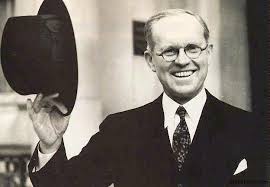
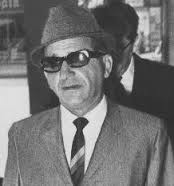



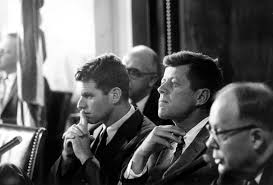

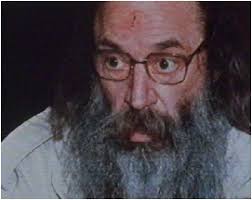
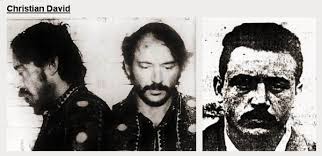

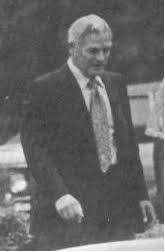
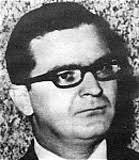
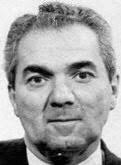


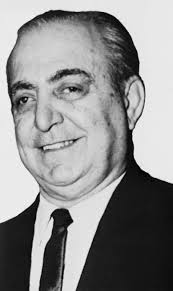
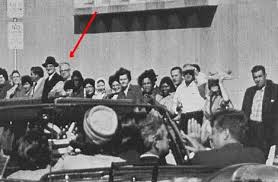
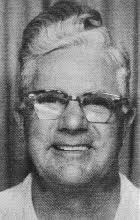

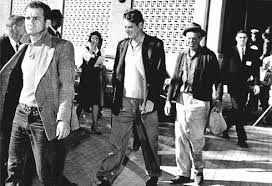


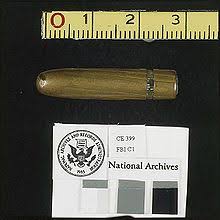
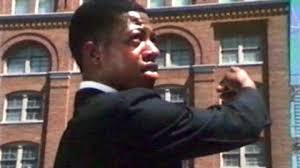


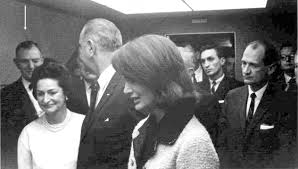
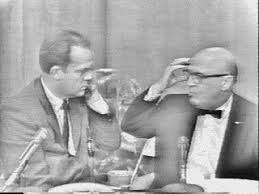
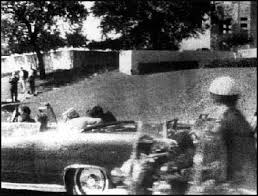
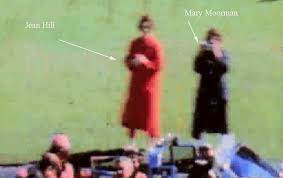
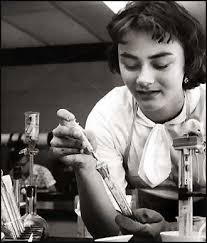
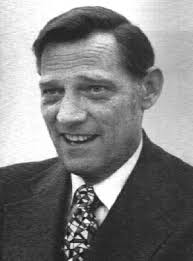

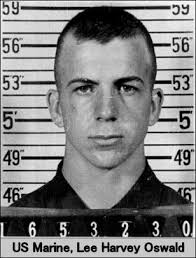
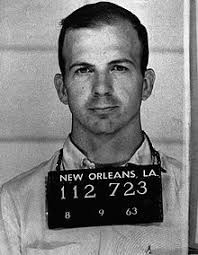

There was much speculation about who was buried in the grave and Oswald’s wife Marina feared the body might’ve been snatched, so by 1981 she ordered it exhumed to see if her husband was still there. Paul Groody was still in business, but Miller’s Funeral Home had been bought out by Baumgardner, Inc., Groody handled the remains as it made its way to Baylor for pathologists to run a dental identification test. Their conclusion was that beyond any shadow of a doubt, the body in that grave was indeed Lee Harvey Oswald.

For those who never really took interest in this topic (or actually have a life), I want to compile a cumulative summary of all the evidence, testimonies, and theories that are flying around for the casual reader to draw their own conclusion. This is information that’s already been published in the media in the form of print, television, and the always reliable internet. My sources come from a number of books I’ve read over the past few years, several internet sites such as Wikipedia and Spartacus Educational, the Warren Report itself(available online), but the bulk of it relies on the television mini-series “The Men Who Killed Kennedy” (TMWKK), in which all nine episodes are available on YouTube.
As for a quick background on the TMWKK mini-series, it actually originated in the UK by producer Nigel Turner, who eventually sold its rights to the Arts & Entertainment Network, which owns the History Channel where the episodes were aired on in the US. The final three episodes have been pulled indefinitely from being aired due to a number of lawsuits, possible lawsuits, and public condemnations from important figures such as former US President Gerald Ford(before his death), former US President Jimmy Carter, and Jack Valenti, the former president of the Motion Picture Association of America, before his death as well. I monitor the History Channel frequently and haven’t seen any of TMWKK episodes being aired in recent years, so it’s rather safe to assume they’ve all been blacklisted from being aired, in the continuing trend of mainstream media that silences any dissent on the subject of JFK’s death. On the other side of the coin, when it comes to books or televised interviews, authors and programs need ‘red-meat’ to increase book sales and or increase ratings, so there’s a lot of motivation to make up stories or sculpt stories in a way to be purposely misleading. To keep the narrative balanced, I also reviewed the summary findings of the Warren Report and will mention those as well, but have to admit I didn’t go tooth-n-nail over the 888 page report simply because it’s as big as The Bible.
I’m laying everything out on the table with wisecrack remarks to bring some levity to the situation, so let’s get started with a fingerprint found on a cardboard box in the sixth-floor of the Texas School Book Depository (TSBD).
Part One: The Motives
Cold Case
It’s widely regarded that Lee Harvey Oswald fired three shots from a window on the sixth-floor of the TSBD. There were fifteen employees, including Oswald, recorded as working in the building on November 22, 1963, the day President Kennedy was killed. Government investigators fingerprinted all those employees, plus the police officers present, in an effort to compare them to all prints found at the crime scene in the TSBD to see if there were any different marks, and there was, on a cardboard box. This unidentified print couldn’t be matched with anyone else’s at the time and it was eventually sent to the National Archives in Washington, D.C, where it laid dormant for thirty-five years.
In 1998, working on a hunch, an independent investigator took this mysterious fingerprint to be compared to the fingerprint of one Malcolm Wallace and an expert concluded it matched based on a fingerprint loop system that I think resembles something as simple as this:
P(“S” | - S) = B/B+D P(“– S“ | S) = C/A+C P(-S | “S”) = B/A+B
Got it?......Alright, me neither, but the result was a 34% grade, which basically means it’s a very strong possible match in the exciting world of fingerprinting. This fingerprint expert, Nathan Darby, ran his test again three years later and came up with the same conclusion, a match. Nathan at the time of these findings had thirty-five years of experience in grading fingerprints, including the US military and Austin Police Department; it’s safe to say he’s no slouch. Also worth noting, fingerprints don’t have a long lifespan on cardboard surfaces, so when the print was discovered in the TSBD in 1963, it must have been made not too long before JFK was killed. This discovery of a likely match was spread out to several law enforcement agencies and the only one to display any interest was the Dallas Police Department, since the JFK murder was still an open case on their blotter. Dallas PD was told to forward the evidence up the line to the FBI and their conclusion was that it was not a match. Since then the issue has basically been put to bed.
Even if the FBI hasn’t found enough of a fingerprint trail to pursue this revelation, the question should be who is Malcolm Wallace and why did someone have a hunch about him in the first place?
Episode 9 of TMWKK, labeled as “The Guilty Men”, delves into this quite deeply and portrays former US President Lyndon B. Johnson (LBJ) and his entourage as those responsible for getting a plan to kill JFK off the ground. It was this episode which has led to the strongest of criticism and the reason why the entire series has all but evaporated being aired any further. LBJ was Vice President at the time JFK was President and was promoted to President on November 22, 1963(secret service agents were referring to LBJ as “Mr. President” as he arrived at Parkland Hospital before JFK was officially declared dead…were they so positive as it was a predetermined fact or just assumed from seeing the nastiness of the headshot?). Barr McClellan, the author of “Blood, Money & Power: How LBJ Killed JFK”, tells the tale of Malcolm, or Mac, Wallace and how initially he was carrying on an affair with Josefa Johnson, sister of LBJ. Wallace was working with the United States Department of Agriculture in Texas, a job he was able to secure through LBJ in 1950 after being introduced by Edward Clark, who partnered in a law firm that represented LBJ. In addition to Mac and Josefa, Josefa was also carrying on another affair with a gentleman named John Kinser.
Josefa Johnson was basically known as a drunken party girl who would get around more or less. Kinser, with some financial issues, asked Josefa if she could approach her brother, by then a US Senator, for a “loan”. Josefa, likely with the help of alcohol, was known to have loose lips and LBJ took this loan request from Kinser as blackmail as perhaps Josefa mentioned some shady dealing from LBJ’s past that Kinser could use against the future president. John Kinser must have been quite the lady’s man as he was also having an affair with Mac Wallace’s wife. A way to get rid of a possible blackmailer, just kill him. In 1951 Mac Wallace walked into a golf pro shop and shot Kinser five times, killing him. Edward Clark arranged for two of Johnson's financial supporters, M. E. Ruby and Bill Carroll, to post bonds on behalf of the defendant. LBJ's attorney from Edward Clark’s law firm, John Cofer, agreed to represent Wallace. In 1952, Wallace resigned from his government job in order to distance himself from LBJ. His trial began seventeen days later, Wallace did not testify. Cofer admitted his client's guilt, but claimed it was an act of revenge as Kinser had been sleeping with Wallace's wife (but it was okay for Wallace to cheat on his wife with Josefa). The jury found Wallace guilty of "murder with malice afore-thought". Eleven of the jurors were for the death penalty. The twelfth argued for life imprisonment. Judge Charles O. Betts overruled the jury and announced a sentence of five years imprisonment. He suspended the sentence and Wallace was immediately freed. Edward Clark wasn’t only known to have the best law firm in Texas, he also was a strong presence in the state capital of Austin and exerted control over state officials amongst many other entities. According to Bill Adler of The Texas Observer, several of the jurors telephoned John Kinser's parents to apologize for agreeing to a suspended sentence, but said they did so only because threats had been made against their families.
Without straying too far off course, LBJ appeared to have had other rotten apples in his barrel, including a business partner in a few enterprises named Billie Sol Estes. Estes ran a vast scam getting federal agricultural subsidies and according to Estes he obtained $21 million a year for "growing" and "storing" non-existent crops of cotton. Around 1960 Henry Marshall from the Agricultural Adjustment Administration (the other AAA) was sent to investigate and a manager from the Estes’ company reached out to Cliff Carter, a LBJ aide who would also serve in the White House under the future president, to essentially get Marshall to back off. Months of dialogue pass by and long story short, Marshall is found dead out in the weeds from an apparent suicide from being shot with his own rifle five times. His head was also found near the exhaust pipe of his vehicle while the motor was still running. The county sheriff did a bang up job with the investigation as no fingerprints were taken of the rifle or the truck, no blood samples taken, no crime scene photos, and the truck was even washed and waxed the next day. Based on the sheriff’s diligent investigation, a judge marked the death certificate a suicide from a gunshot. Marshall’s body was exhumed in an effort to detect whether the gunshots killed him or the carbon monoxide, the report came back it wasn’t a suicide and noted there was also a blow to his forehead. The case was kicked to the FBI, but they came back to the original verdict, self-inflicted gunshot wound in which even FBI Director J. Edgar Hoover made a notation on May 21, 1962: "I just can't understand how one can fire five shots at himself."
The intriguing part in all of this is that a local gas station attendant gave a description of a stranger with glasses who asked for directions to Marshall’s farm, (and yes) that police sketch had a striking resemblance to Mac Wallace.
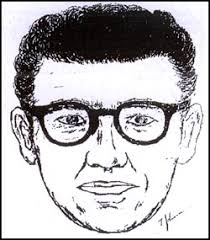
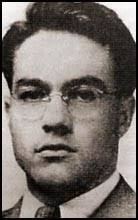
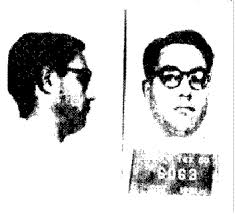
By this time even JFK had taken interest in this case as well as his younger brother who he appointed US Attorney General, Robert Kennedy (Bobby). Estes did appear in front of a grand jury, with LBJ attorney John Cofer from the always-popular Edward Clark law firm that also represented the admitted killer Mac Wallace at his trial, and there was nothing found to charge Estes with. Unfortunately for Estes, his luck ran out the following year as he went to prison for fraud relating to the mostly nonexistent fertilizer tanks he had put up for collateral as part of the cotton allotment scam.
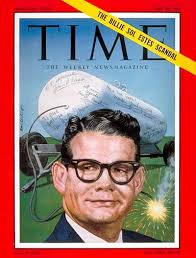
The second bad apple in LBJ’s circle of trust was Bobby Baker. His official title was Secretary to the Senate Majority, but in addition he was rumored to be wheeling and dealing all over with business partnerships formed with several key figures in organized crime was picked up on FBI wiretaps (forcing LBJ to pull out all FBI wiretaps years later). His ultimate downfall was getting caught receiving a bribe for awarding a contract to General Dynamics to produce fighter-jets. As a result he had to resign his post as Secretary.
With the Kennedys looking at the death of Marshall, the fraud of Estes, the corruption of Baker, LBJ had to worry that not only he might be left off the ticket for JFK’s 1964 re-election, but he himself could very well end up in prison if anything traced back to him. It’s no secret LBJ and the Kennedys didn’t particularity like each other to begin with, but they were paired strategically by the Democratic Party so LBJ’s popularity in the south could help JFK defeat Richard Nixon in the 1960 election. During the actual JFK Presidency, LBJ was reduced to being a piece of White House furniture (as most Vice Presidents are) and it was really Bobby who served as his brother’s right-hand man. Now with the Kennedys no longer really needing LBJ for the 64’ campaign and the threat of them looking into his dirty laundry, well, there’s only so much a proud Texan can take.
By this time even JFK had taken interest in this case as well as his younger brother who he appointed US Attorney General, Robert Kennedy (Bobby). Estes did appear in front of a grand jury, with LBJ attorney John Cofer from the always-popular Edward Clark law firm that also represented the admitted killer Mac Wallace at his trial, and there was nothing found to charge Estes with. Unfortunately for Estes, his luck ran out the following year as he went to prison for fraud relating to the mostly nonexistent fertilizer tanks he had put up for collateral as part of the cotton allotment scam.
The second bad apple in LBJ’s circle of trust was Bobby Baker. His official title was Secretary to the Senate Majority, but in addition he was rumored to be wheeling and dealing all over with business partnerships formed with several key figures in organized crime was picked up on FBI wiretaps (forcing LBJ to pull out all FBI wiretaps years later). His ultimate downfall was getting caught receiving a bribe for awarding a contract to General Dynamics to produce fighter-jets. As a result he had to resign his post as Secretary.
With the Kennedys looking at the death of Marshall, the fraud of Estes, the corruption of Baker, LBJ had to worry that not only he might be left off the ticket for JFK’s 1964 re-election, but he himself could very well end up in prison if anything traced back to him. It’s no secret LBJ and the Kennedys didn’t particularity like each other to begin with, but they were paired strategically by the Democratic Party so LBJ’s popularity in the south could help JFK defeat Richard Nixon in the 1960 election. During the actual JFK Presidency, LBJ was reduced to being a piece of White House furniture (as most Vice Presidents are) and it was really Bobby who served as his brother’s right-hand man. Now with the Kennedys no longer really needing LBJ for the 64’ campaign and the threat of them looking into his dirty laundry, well, there’s only so much a proud Texan can take.
Messin’ with Texas
Another high profile client of Edward Clark’s law firm is a big shot Texas oil tycoon by the name of Clint Murchison, who had a son who went on to be owner of the Dallas Cowboys for a while, but this tale involves the father. Author Barr McClellan point out that Murchison, along with other fellows by the names of H.L. Hunt and D.H. Byrd, was part of the “Big Oil” group in Dallas, which by today’s standards would be like OPEC. One of the main concerns of this group was the preservation of the oil depletion allowance. The federal government allowed owners of oil wells to take a tax savings for selling their oil. Specifically, a firm could reduce its corporate income tax by an oil depletion allowance equal to roughly 27.5 percent of the value of the crude oil sold. Throughout the 1950’s, “Big Oil’s” main man in the senate was no other than majority leader LBJ. It was LBJ, Murchison, and a whole host of other right-wing businessmen and politicians that made up a group known as Suite 8F(These guys are basically who you seen in the movies when there’s a bunch of old rich white dudes in a room smoking cigars and planning evil stuff). The name Group Suite 8F was in reference to Suite 8F at the Lamar Hotel in Houston where this group as well as a lot of Texan high-rollers would get together for gambling, partying, socializing, etc.
Around January of 1963, JFK was proposing the idea to do away with the oil depletion allowance. It is estimated that the proposed removal of the oil depletion allowance would result in a loss of around $300 million a year to Texas oilmen. So doing the math real quickly, another year of JFK, plus four more if he got re-elected, would cost these rich oil men billions of dollars. This wasn’t only the only loaf of bread the Kennedy was burning; he was also proving to be a threat to a little known agency called the CIA. In April of 1961 the CIA led an invading force of Cuban exiles into Cuba for the sole purpose of toppling Fidel Castro’s communist (communism - bad for US business and organized crime gambling) regime. One of these CIA agents was E. Howard Hunt, who years later was caught breaking into the Watergate Hotel to bug the Democratic Party’s headquarters on behalf of then President Richard Nixon. Getting back to this incident, it’s called the Bay of Pigs; it was a failure and total embarrassment to Kennedy’s administration. The main problem was the Cubans seemed to be well prepared for the so-called surprise attack and Kennedy blamed the CIA for the bungle. In 2000, a Washington Post article, "Soviets Knew Date of Cuba Attack", reported that the CIA had information indicating that the Soviet Union knew the invasion was going to take place, and did not inform Kennedy. April 1961, Radio Moscow broadcast an English-language newscast, predicting the invasion "in a plot hatched by the CIA" using paid "criminals" within a week. The invasion took place four days later.
Of course the CIA and the US military top commanders were muttering that it was JFK’s fault for not using the US military as backup, or at the very least not ordering more firepower to pound the Cuban defenses and give the invasion a better chance at success. Perhaps the CIA eventually realized the invasion was doomed for failure, but by going ahead anyways they might force Kennedy to call in US firepower and troops instead of facing embarrassment, but Kennedy preferred the embarrassment over the Soviet Union entering the mix. Kennedy fired a shot of his own by having CIA Director Allen Dulles, CIA Deputy Director Charles Cabell, and Deputy Director for Plans Richard Bissell, resign by early 1962. In addition, Kennedy was aiming at legislation to splinter the CIA in a thousand pieces and scatter it to the winds, as he was quoted. He wanted to bring the CIA back to serve as their original purpose when they were created, and that’s pure intelligence gathering. Not getting involved in wars and sponsoring their own hostile actions. The CIA Director who was forced to resign, Allen Dulles, would be a member of the Warren Commission that investigated JFK’s death two years later after JFK basically canned him over the Bay of Pigs fiasco. (Allen Dulles would investigate JFK’s murder objectively and without prejudice, wouldn’t he?)
Let Us Blow Things Up
As the US and Russia used the global map as their own life-size board game of Risk, one of the territories that became a focal point was the country of Vietnam.



A civil war had begun and the narrative became the communist north versus the democratic south. In reality, Ho Chi Minh, leader of the north, was simply using communism as a tool to unite the country under one flag and could really care less about the ideology. In fact, after war with the US, the Vietnamese went on to start fighting their communist brothers in China. The south was less dedicated and less disciplined than their northern counterparts, and once it looked like the entire country was to go communist, the US intervened. At first the US sent advisors and weapons to arm and train the southern army, without getting involved in hostile action. Even with the US’ aid, the south was being overrun and a decision was needed on Kennedy’s part whether the US would use its troops to assist the south, or simply pull back and leave the fate of Vietnam in its own hands. Kennedy’s Secretary of Defense, Bob McNamara, was putting on a good face for the press that things were under control in Vietnam, but behind the scenes he saw what was happening and soon enough Kennedy was making public statements that the south had to handle its own affairs.
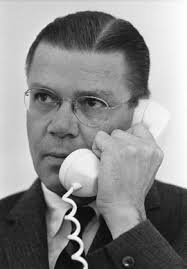
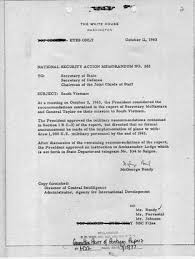
JFK also signed a number of national security memos, highlighted by NSAM 263 which ordered the complete transfer of the US military’s mission in Vietnam to the government of the south by the end of 1965. (On the other hand, if JFK wasn’t around for a second term as President, then he wouldn’t be able to actually see it through)
A civil war had begun and the narrative became the communist north versus the democratic south. In reality, Ho Chi Minh, leader of the north, was simply using communism as a tool to unite the country under one flag and could really care less about the ideology. In fact, after war with the US, the Vietnamese went on to start fighting their communist brothers in China. The south was less dedicated and less disciplined than their northern counterparts, and once it looked like the entire country was to go communist, the US intervened. At first the US sent advisors and weapons to arm and train the southern army, without getting involved in hostile action. Even with the US’ aid, the south was being overrun and a decision was needed on Kennedy’s part whether the US would use its troops to assist the south, or simply pull back and leave the fate of Vietnam in its own hands. Kennedy’s Secretary of Defense, Bob McNamara, was putting on a good face for the press that things were under control in Vietnam, but behind the scenes he saw what was happening and soon enough Kennedy was making public statements that the south had to handle its own affairs.
JFK also signed a number of national security memos, highlighted by NSAM 263 which ordered the complete transfer of the US military’s mission in Vietnam to the government of the south by the end of 1965. (On the other hand, if JFK wasn’t around for a second term as President, then he wouldn’t be able to actually see it through)
Pulling out of Vietnam would not only irk the admirals and generals that need a good war to advance their military credentials, but it would also result in the loss of billions of dollars to the companies that manufacture military vehicles and equipment. These companies rely on wars so they can get lucrative contracts from the US government (your tax dollars being spent) to build helicopters, fighter-jets, tanks, jeeps, amongst many other cool toys. These manufacturers include Bell, General Dynamics, Lockheed Martin, Northrop, and even General Electric. In addition to money made by building these machines of destruction, there’s money to be made by fueling them up (the “Big Oil” and Suite 8F people must have really loved JFK’s decision to not escalate the war in Vietnam). It was bad enough JFK wasn’t letting the army soldiers play war with Cuba just ninety-miles off the Florida cost, but he wasn’t going to let them have fun in Vietnam either.
Was there anyone else Kennedy managed to rub the wrong way?
A Picture is Worth a Thousand Words
For nearly forty-years J. Edgar Hoover had served as Director of the FBI and part of his usual protocol was reporting directly to the President. Under JFK’s administration, a curveball was tossed at the old man as he was now instructed to report to US Attorney General Robert Kennedy instead of the President. As people reach their golden years and have been doing someone a certain way for a very long time, they don’t take kindly to sudden changes. One could only imagine the look on Hoover’s face when he was forced to look up at some snot-nosed punk kid (likely in his mind) as his boss. The Kennedy brothers with their wealthy upbringing, celebrity-good looks, rumored affairs with women, was everything that Hoover despised.
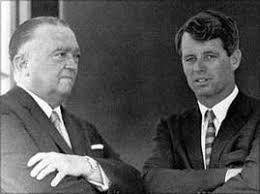
Hoover designated FBI teams to states which had the highest amount of organized crime figures to go after their leaders in what was known as his Top Hoodlum Program. New York and Chicago received the most attention naturally, but in all there were mobsters such as Tony Accardo, Sam Giancana, Joe Bonnano, Vito Genovese, Santo Trafficante, Carlos Marcello, Joe Profaci(with the Gallo Brothers), and Tommy Lucchese, all receiving special attention. The agenda of the FBI under Hoover had always been directed towards finding communist spies in the country, not much was done about organized crime.
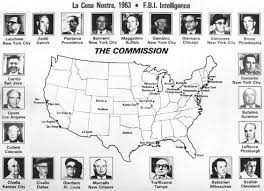
In a case of who do you want to believe, former FBI agent of the Chicago office, William Roemer, who was assigned to play cops-n-robbers with Accordo and Giancana, claims in his book, “Accardo: The Genuine Godfather”, that Hoover wasn’t passive on organized crime as he is usually made out to be, and was zealous about putting these guys behind bars. Yet, one can’t ignore the fact that organized crime in the country went unchecked for a long time before JFK took office, and it was mainly lower level government officials such as New York District Attorney Thomas Dewey, New York City Mayor LaGuardia (got an airport named after him for tossing slot machines in the East River), Senate Committees such as Kefauver and McClellan, that went on the assault of the mob. According to Bill Bonanno, son of one of the original bosses of the Five New York Crime Families Joe Bonanno, in his final book that was released only after his death, “The Last Testament of Bill Bonanno”, states there were two reasons Hoover didn’t focus in on the mob. One was someone in the underworld was able to get their hands on a photo of him with another man taken at a beach, and with Hoover’s rumored homosexuality, this must have been a very interesting photo. The second reason, also according to Bill Bonanno, was Hoover met with his father Joe in the 1940’s and they had a gentlemen’s agreement, the mobs not take part in drug trafficking in the country and in turn the FBI wouldn’t come down on the mob’s activities.
In a case of who do you want to believe, former FBI agent of the Chicago office, William Roemer, who was assigned to play cops-n-robbers with Accordo and Giancana, claims in his book, “Accardo: The Genuine Godfather”, that Hoover wasn’t passive on organized crime as he is usually made out to be, and was zealous about putting these guys behind bars. Yet, one can’t ignore the fact that organized crime in the country went unchecked for a long time before JFK took office, and it was mainly lower level government officials such as New York District Attorney Thomas Dewey, New York City Mayor LaGuardia (got an airport named after him for tossing slot machines in the East River), Senate Committees such as Kefauver and McClellan, that went on the assault of the mob. According to Bill Bonanno, son of one of the original bosses of the Five New York Crime Families Joe Bonanno, in his final book that was released only after his death, “The Last Testament of Bill Bonanno”, states there were two reasons Hoover didn’t focus in on the mob. One was someone in the underworld was able to get their hands on a photo of him with another man taken at a beach, and with Hoover’s rumored homosexuality, this must have been a very interesting photo. The second reason, also according to Bill Bonanno, was Hoover met with his father Joe in the 1940’s and they had a gentlemen’s agreement, the mobs not take part in drug trafficking in the country and in turn the FBI wouldn’t come down on the mob’s activities.
In “Double Cross”, co-authored by Chicago mob boss Sam Giancana’s younger brother Chuck, its further revealed that Sam Giancana and another big mobster from New York named Frank Costello would frequently feed tips to Hoover about rigged horse races. This system of letting Hoover win on certain races was a payoff more or less. Although if the mob had the ability to ruin Hoover with the photograph, why would they need to pay him off? Unless the extra pocket money was to just smooth everything over and keep Hoover from re-thinking the situation. William Roemer might feel Hoover was tough on the mob, but the fact is there was no aggressive effort on part of the FBI until the infamous big mob meeting in Appalachia, NY in 1957 was all over the newspapers in which Hoover had no choice but to launch his Top Hoodlum Program. The gay-photo angle does have a nice touch, but it seems too good to be true. Most objective analyzers have concluded that Hoover feared targeting the mob because most of the law enforcement groups that has gone after them before had usually come under the temptation of bribes and corruption.
Take a town like Chicago, just about every beat cop on the street up to the mayor’s office was on the pad (on the take). Hoover enjoyed the fact the FBI was able to maintain a squeaky clean image and that was mostly because the FBI stayed out of the mob’s hair. With Bobby Kennedy and his strong anti-mob sentiments acting as Hoover’s boss, Hoover had to face the reality that his agents would eventually be offered bribes and the squeaky clean image of the FBI would be gone. And for a moment let’s say the gay-photo story was true, in addition to his agents getting corrupted, perhaps if the wrong mobster ended up behind bars because of the FBI’s work, then maybe that photo would’ve leaked out. Hoover also had to be concerned about his age, closing in on 70, it’s likely by law he would’ve been forced to retire from the job he loved doing for so long. With the Kennedy’s and Hoover not exactly on the greatest terms, JFK as President would’ve had enough authority to hold him to the law and force him out as Director of the FBI.
We Thought You Were Our Friend
Speaking of the mob, they weren’t exactly the biggest Kennedy fans either by 1963. Both Kennedy brothers were involved in the McClellan Committee that brought a lot of top mob figures to public hearings on national television during the 1950’s. When JFK as President selected to not overthrow Fidel Castro by use of military force, the paradise the mob had set up in Cuba that earned them a fortune was destroyed. In fact, Castro even had Tampa mob boss Santo Trafficante imprisoned and facing a death penalty (Trafficante must have had to pay a ton to get out of that fix).
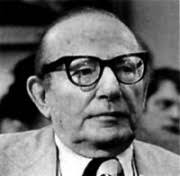
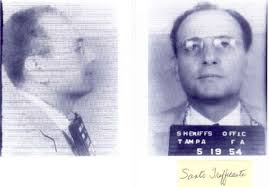
Without getting too far ahead, the person who is believed to have picked up Trafficante from Cuba and escorted him back to the States was Jack Ruby, but he’s to be discussed later.
The mob was living high on the hog in Cuba before Castro ruined the fun with their many casinos ranking in billions of dollars. Initially, most of the Cuban casinos had rigged games, but legendary mob figures such as Meyer Lansky explained that if word gets out that their games are fixed, the US tourists would be scared away. Soon enough, Lansky, Trafficante, Marcello, and Giancana became major players in Cuba since they knew how to bring in the tourists that spent the money.
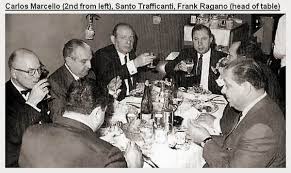
Fulgencio Batista was as corrupt of a dictator as they come in Cuba, and he was more than happy to accept donations from the mob that allowed them to basically do whatever they wanted in his country without worry of the type of government regulations that existed in the US. When the Cuban revolution begun under Castro, the mob made sure to split their bets and financially supported both sides of the conflict.
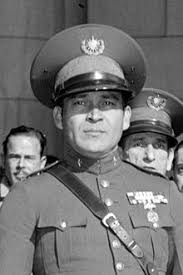

The thinking process there was, if Castro wins, he would be grateful of the mob’s support and allow them to continue making money with their casinos. If Batista’s forces win, same thing, they’ll be grateful as well and everything would continue as it was before. Castro was smart enough to take the mob’s money and guns, but after the Cuban revolution, instead of rewarding the mob, he seized the casinos and kicked them out of his country, except for Trafficante who was thrown in jail. With the Bay of Pigs invasion a failure and JFK not following up with any plans to get Cuba back for the mob, as well as legitimate US businesses who invested in that country, the mob had lost a huge moneymaking machine.
Fulgencio Batista was as corrupt of a dictator as they come in Cuba, and he was more than happy to accept donations from the mob that allowed them to basically do whatever they wanted in his country without worry of the type of government regulations that existed in the US. When the Cuban revolution begun under Castro, the mob made sure to split their bets and financially supported both sides of the conflict.
The thinking process there was, if Castro wins, he would be grateful of the mob’s support and allow them to continue making money with their casinos. If Batista’s forces win, same thing, they’ll be grateful as well and everything would continue as it was before. Castro was smart enough to take the mob’s money and guns, but after the Cuban revolution, instead of rewarding the mob, he seized the casinos and kicked them out of his country, except for Trafficante who was thrown in jail. With the Bay of Pigs invasion a failure and JFK not following up with any plans to get Cuba back for the mob, as well as legitimate US businesses who invested in that country, the mob had lost a huge moneymaking machine.
Where did the funds come from to build the casinos in Cuba, as well as in Las Vegas and Miami?
Another pressure point that both Kennedy brothers were drawing unwanted attention to was the Teamster’s Pension Fund and the man who controlled the purse strings, James R. Hoffa, better known as Jimmy Hoffa. As a percentage of wages came out of unionized truck drivers and other laborers’ pay checks each pay cycle, those funds went into the Teamster’s Pension Fund which was supposed to be there for those workers after they retired. So with a pile of cash lying around doing nothing, Hoffa started to provide loans to dummy corporations that were created by mobs, and with those funds the dummy companies would finance the building of casinos.
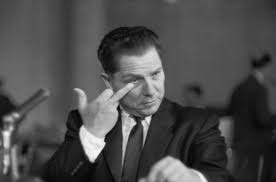
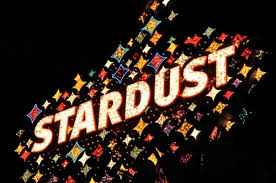
Once those casinos started to earn a profit, the funds were paid back to the Teamsters with interest, and of course Hoffa was rewarded with a thank you gift on the side. The mob loved this system because they were able to build casinos without actually having to invest their own money. This of course was totally illegal, and Hoffa was also involved in a lot of other fraudulent schemes that cost him a prison sentence later on. During the McClellan Committee, Hoffa had to appear on national television and face a barrage of questions from Bobby Kennedy. During the infamous Presidential Debate with Richard Nixon for the 1960 race, JFK even referred to Hoffa as a criminal, and it only got worse when Bobby was made US Attorney General and made Hoffa his number one priority. Bobby formed a special task force unit called the “Get Hoffa Squad”.
Once those casinos started to earn a profit, the funds were paid back to the Teamsters with interest, and of course Hoffa was rewarded with a thank you gift on the side. The mob loved this system because they were able to build casinos without actually having to invest their own money. This of course was totally illegal, and Hoffa was also involved in a lot of other fraudulent schemes that cost him a prison sentence later on. During the McClellan Committee, Hoffa had to appear on national television and face a barrage of questions from Bobby Kennedy. During the infamous Presidential Debate with Richard Nixon for the 1960 race, JFK even referred to Hoffa as a criminal, and it only got worse when Bobby was made US Attorney General and made Hoffa his number one priority. Bobby formed a special task force unit called the “Get Hoffa Squad”.
Hoffa wasn’t the only Teamster official under attack from Bobby Kennedy. Tony Provenzano, a high ranking leader in New York’s Genovese crime family, was made union vice president of Union Local 560 of New Jersey by Hoffa and his position gave him access to union funds which he ended up taking for personal use. Eventually Bobby’s crusade labor racketeering caught up with ‘Tony Pro’, as he was nicknamed, and was convicted in June 1963 by a charge that would eventually cost him a four-year prison sentence. What angered Tony Pro allegedly was that Bobby’s investigators questioned his family, friends, neighbors, and even Tony Pro’s children (can you kids tell me where daddy got the money to buy those toys?). While talking to the press during his appeal, the New York Times reported Provenzano went on such an obscene tirade regarding Bobby Kennedy that reporters couldn’t even put a quote together from him. Bringing attention to the Teamster’s loans and the dealings of the likes of Hoffa and Tony Pro was risking the mob’s access to large amounts of capital to finance their ventures.
Taking into account the mob possibly losing its ability to secure loans from the Teamsters, the fact JFK didn’t militarily stop Castro from overtaking Cuba which got the mob kicked out, forcing Hoover to be more aggressive towards investigating the mob, and Bobby himself going after top mob figures as Attorney General, the mob must have been saying to themselves, that’s some way to return a favor.
What?
It’s an urban legend that the father of John and Bobby Kennedy, Joe Kennedy, reached out to the mob, specifically Chicago boss Sam Giancana, to use their influence to get his son elected President in 1960 by guaranteeing Illinois. During the US Prohibition days, Joe Kennedy made a fortune as a rumrunner before moving into more legitimate rackets. Joe might’ve moved onto bigger and better things, but he rubbed elbows with many underworld figures in the past and knew who he needed to call upon for a favor for his son.
In another case of ‘do you want to believe mobsters?’, Bill Bonanno in “The Last Testament of Bill Bonanno”, recalls a story his father told him about Joe Kennedy. It was during these rumrunner days when Joe’s boat was carrying whiskey from Canada, as well as illegal immigrants that were being snuck into America. As a patrol boat was closing in and Joe Kennedy needed his ship lighter in weight to flee away faster, he ordered the illegal immigrants tossed overboard. Also in “Double Cross”, Sam Giancana’s younger brother Chuck confirms the legend of Joe Kennedy reaching out to Sam, and takes it even further. Many years earlier when a decision was being made amongst top mob leaders to rub Joe out, it was Sam who spoke up and had it called off. Chuck also went on to say the Kennedys, as in John and Bobby as well as daddy Joe, frequented a bordello run by the Chicago mob in Reno, NV for a number of sexual romps. In fact, Giancana had the Kennedys supposedly bugged during these acts to use as a weapon against them, but no ever tapes ever surface, so it’s near impossible to detect the validity of that tale. Even as President, Chuck claims Sam told him JFK was providing Sam with the FBI reports he received, using call girls they would both sleep with to transfer the files. Iconic singer Frank Sinatra was also said to have been used as a message boy between both parties since he was friends with both JFK and Giancana. In one instance, Giancana was caught in the company of Marilyn Monroe at one of Sinatra's places in Nevada. Sinatra was called into court to testify about it. Publicly he denied knowing Giancana or having any affiliation with mobsters, but years later Sam Giancana’s daughter, Antonette, gave an interview stating that Frank Sinatra came over to their house many times.
In 1963, Frank Sinatra sponsored Chicago mobster Johnny Roselli for membership in the exclusive Los Angeles Friar's Club and after 1976 a picture surface of Frank Sinatra posing with the hierarchy of New York's Gambino crime family, including the legendary Carlo Gambino and future boss Paul Castellano. Sinatra was performing at the Westchester Palace Theater and boys went backstage to say hello, but of course Sinatra wasn’t cozy with mobsters, was he?
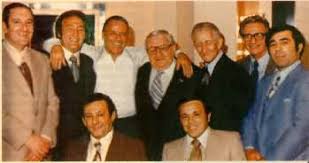
If Chuck’s stories about his brother’s relationship with the Kennedys aren’t wild enough, he even said his brother had multiple meeting with JFK as President in the actual White House!! Something he claimed his brother also did during Harry S. Truman’s tenure. When Truman was declared a winner for the 1948 Election, there’s a famous picture of him holding up a Chicago newspaper wrongfully declaring Truman the loser. Just as Joe Kennedy supposedly did, Truman also reached out to Giancana for help and the Chicago mob was able to use its influence to swing the State of Illinois in Truman’s favor last minute.
When the Kennedy’s reached the White House and Bobby came out with all this tough talk about getting rid of the mob, Sam Giancana and the rest of the underworld must have been scratching their heads and thinking, “huh?”
The word from Joe Kennedy, even as far back as the 1950’s during the McClellan Committee, was that John and Bobby were just acting tough on the mob in front of the cameras to boost their political careers. The same message was repeated again from Joe when Bobby was increasing his rhetoric about busting the mob after JFK was elected President. According to Chuck, most of Sam’s fears were put to rest when he was able to have his meetings in the White House as well as receive the FBI reports, but that eventually that fizzled out. Giancana wasn’t able to get in touch with the President anymore and he wasn’t receiving his normal FBI reports. For whatever reason, JFK was giving Giancana the cold shoulder. Then Giancana came to the realization that the Kennedys hustled him; Have Joe reach out to the mob to get JFK elected, then instead of holding up their end of the bargain, just have Bobby take them down and call it a “war on crime”. This way, with the mob bosses behind bars or deported, the Kennedys won’t have to return any favors.
Could the Kennedys sink to such a low level to get into the White House?
The Kennedy name isn’t the most unblemished in the world. Michael Kennedy was accused of statutory rape of the family babysitter in the 1990’s and only admitted to consensual sex when she was 16, the legal age in Massachusetts (so that makes it okay?). In 1969, Ted Kennedy left the scene of a car accident in which his female passenger was submerged under water and drowned. Ted, likely driving while drunk, fled the scene to protect his political career, but too bad for him he didn’t realize he needed to call the authorities until the next morning (probably after he sobered up). Although Ted stayed on as the Senator of Massachusetts for a very long time, the drowning incident likely ruined his chance to be President when he ran against Jimmy Carter for the 1980 Democratic ticket. The drowning- issue frequently came up with reporters and Ted Kennedy wasn’t able to smooth talk his way out of it. Toss in these stories and the legend of Joe Kennedy’s bootlegging days, there does appear to be a sinister factor alive in the Kennedy gene.
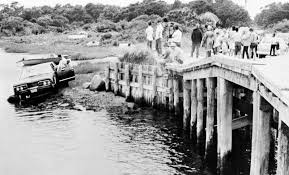
Bobby did go ahead with his assault on organized crime as well as Jimmy Hoffa and the Teamsters. New Orleans mob boss Carlos Marcello was actually deported from the US and dumped in the jungles of Guatemala in 1961.

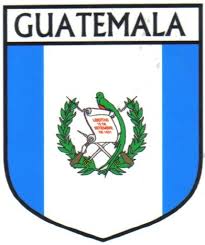
Although he was able return to the US, it was an embarrassing affair for him and the Kennedys had personally angered one of the most powerful mob bosses in the country. When teased by an acquaintance about the deportation ordeal and his feeling towards the Kennedy’s, Marcello remarked, “You kill a serpent by cutting off its head”. The head in this case, is referring to the President.
Although he was able return to the US, it was an embarrassing affair for him and the Kennedys had personally angered one of the most powerful mob bosses in the country. When teased by an acquaintance about the deportation ordeal and his feeling towards the Kennedy’s, Marcello remarked, “You kill a serpent by cutting off its head”. The head in this case, is referring to the President.
Part One: The Motives - Results
If there was a multi-tiered conspiracy behind the death of JFK, the only way for it to work is if the people and groups who succeeded in power were at the heads of the highest positions of government, including the Presidency.
The shooting itself would be the easy part; the difficult part is spreading disinformation to the media, withholding evidence, and making witnesses disappear. A lone nut, the mob, angry Cuban exiles, a rogue element in the CIA, those suspects alone wouldn’t be able to pull it off. What would be required for a cover-up is a President, Director of the CIA, Director of the FBI, Head of Secret Service; everyone would need to be on board and in powerful positions to pass orders down the chain.
Could Lyndon B. Johnson be that ruthless?
In July 31, 1964 the USS Maddox was sent on an intelligence finding mission off the waters of North Vietnam and was ordered 8 miles off their coast so they would be in international waters. By August 2nd, fighting occurred between the US Maddox and North Vietnamese torpedo boats. The US claimed they didn’t violate the 8-mile rule, but North Vietnamese General, Phùng Thế Tài, claimed that the Maddox had been tracked since July 31 and that it had attacked fishing boats on August 2, forcing North Vietnamese Navy to engage since it was also 5 miles off their coastline. Previously, the USS John R. Craig performed a similar mission without violence, and ships from other countries did the same thing without any fighting.
Two days later on August 4th, the Maddox picked up false radar reports of torpedo missiles being fired at the the ship. The first (likely provoked) attack on August 2nd, and then a total phantom attack two days later, became known as the Gulf of Tonkin incident. Without fully confirming the radar report on the second engagement, the by then President Johnson took the ball and ran with it. He proposed the Gulf of Tonkin Resolution which was passed by Congress that allowed LBJ to assist any nation in the Indo-China region that was in threat of communist aggression. Basically that was the green-light for full US involvement in that country and the official start of the Vietnam War. In 2003, Bob McNamara, who was still on as Secretary of Defense during the start of that war, stated in the documentary “The Fog of War” that indeed the second “attack” wasn’t real. So if LBJ was cool with bamboozling his way to start up the Vietnam War with all the death and carnage that would cause, what’s one little JFK to push out of the way?
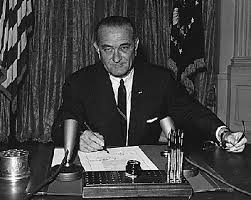
What else occurred after JFK died?
LBJ certainly wasn’t left off the 1964 ticket, he was President by that time and got elected to another term in which he served through 1968. Although eligible to run again in 68’, he decided to retire from politics and lived out his remaining years on his ranch where he put on weight, took up smoking again, drank, and faced depression (I wonder what could’ve made him feel so unnerved?).
LBJ eliminated government plans to remove the oil depletion allowance, and it dropped to 15% from 27.5% only after he left office (Richard Nixon kept the allowance during his tenure as President and it was not until the arrival of Jimmy Carter that the oil depletion allowance was completely removed).
The CIA wasn’t “splintered into a thousand pieces” as JFK was on record saying he wanted to do.
Although LBJ kept Bobby Kennedy on as Attorney General, to the surprise of many, Hoover of the FBI no longer reported directly to Bobby, but instead to LBJ as Hoover had with previous administrations before JFK. Before Hoover reached the mandatory retirement age of 70 on January 1, 1965, President Lyndon Johnson staged a ceremony in the White House Rose Garden to announce his waiver of retirement. Hoover would go on to serve as Director of the FBI until his death in 1972.
July 11, 1965, LBJ ordered the FBI to pull all wiretaps from their investigations. Since the FBI had been directed to focus on the mob at that time, it begs the question of what words coming out of an associate’s mouth or from mobsters was LBJ afraid of ending up in a courtroom somewhere.
Thanks to the Gulf of Tonkin Resolution, the Admirals and Generals got to play war in Vietnam and the companies that manufactured the necessary war materials went on to receive lucrative contracts worth billions of dollars from the US government over the next decade.
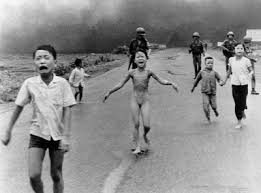

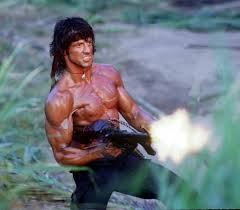
Cuba remained in the hands of Fidel Castro’s communist regime (Who needs him? We got Vietnam now and its way cooler).
None of the heads of the mob families throughout the country, known collectively as ‘The Commission’, as identified by a 1963 FBI report, faced any serious prison time in the wake of JFK’s death, with exception of Vito Genovese who was already jailed in 1959 for a narcotics charge. Although death-by-murder and prison sentences came for some later on, it was well beyond the years of JFK’s assassination. The biggest names at the time such as Carlo Gambino, Tommy Lucchese, Carlos Marcello, Santos Trafficante, Tony Accardo, Joe Bonanno, and Joe Profaci went to live into their old age and died of natural causes (It’s worth noting that in addition to most Commission members staying outside prison walls, the supposed gay-photo of FBI Director Hoover never surfaced…..coincidence?).
Jimmy Hoffa was convicted on separate accounts in 1964 and sentenced to a total of thirteen years in prison, but he didn’t start serving time until 1967 and was pardoned by President Nixon in 1971 after only serving four years. In his absence, Hoffa appointed Frank Fitzsimmons to run everything and the lesser-clout Fitzsimmons turned out more favorable to the mob in securing Teamster loans. Hoffa had a higher standing than Fitzsimmons and was able to push back against mob requests, Fitzsimmons on the other hand was a complete door mat. Although Hoffa was behind bars, business with the mob and the Teamsters continued like clockwork.
Tony Provenzano was jailed at Lewisburg Penitentiary around the same time as Hoffa and the two eventually had a falling out which led to a prison scuffle. Supposedly Hoffa was scheduled to meet with Tony Pro, as well as Detroit mobster Anthony "Tony Jack" Giacalone, and Northeastern Pennsylvania boss Russell Bufalino on the day he disappeared to iron out their differences. Due to the prison sentences of Hoffa and Tony Pro and their parole stipulations, they had to stay away from Teamster activity for a certain period of time, and both were at odds over the other one obtaining their previous Teamster’s position. In the end, Hoffa went missing in 1975 (officially declared dead in 1982). A year later in 1976, Tony Pro was photographed playing golf with Richard Nixon.

Two years later he was convicted of an old 1961 murder and sent to prison again where he eventually died of a heart attack in 1988.
Two years later he was convicted of an old 1961 murder and sent to prison again where he eventually died of a heart attack in 1988.
Why was D.H. Byrd worth mentioning alongside Clint Murchison as part of the “Big Oil” group in Texas?
Byrd was only the owner of an insignificant building called the Texas School Book Depository (Yes!! That one! Where it was alleged Oswald fired the shots from). At the time of the JFK shooting Byrd was away on an African safari trip (How convenient….reminds me of the time Al Capone decided he needed a vacation in Florida when the St. Valentine’s Day Massacre was occurring in Chicago).
Anything else interesting about Byrd?
Sure, he started the Civil Air Patrol.
So?
The Civil Air Patrol would go on to be joined by the likes of Lee Harvey Oswald, and another interesting figure that will be mentioned several more times, David Ferrie.

H.L. Hunt? The oil tycoon and another one of LBJ’s financial backers.
According to former Hunt aide, John Currington, Joe Kennedy met with Hunt in California a few days before the 1960 Democratic Convention when JFK and LBJ were running for the ticket. From that meeting a decision was made JFK would be the presidential candidate and LBJ vice-president, which left Hunt and LBJ very unhappy. Madeleine Duncan Brown, a self-proclaimed LBJ mistress who will be discussed later, stated after this 1960 agreement LBJ stated he lost a battle, but he’ll win a war. After JFK died, she said LBJ remarked to her, “We won the war”.
Barr McClellan, the author of “Blood, Money & Power: How LBJ Killed JFK”, is the one who speaks of the murders ordered by LBJ, this notion of the oil depletion allowance, and the sinister dealings within Edward Clark’s law firm, why should anyone believe him?
McClellan joined Clark’s law firm in 1966 and became a full-time partner in 1972. He left the firm in 72’ after an internal office dispute with a new client having conflict with existing clients. Working there for six years, I’m sure he heard a few good tales by the water cooler. As for his dedication to the truth, he was charged with forgery in 1986, but those charges were dropped in 1992.
Since Episode 9 of TMWKK series caused the most controversy, it was given to an independent study group to determine its validity. The group determined the accusations weren’t valid, but they didn’t bother to interview the person who made a lot of the accusations in the first place, Barr McClellan, or the show’s producer Nigel Turner (Imagine charging a suspect of a crime without even questioning the suspect).
Can’t someone just track down Mac Wallace and ask him about his possible fingerprint found in the Texas School Book Depository or these supposed killings he performed by orders from LBJ?
Opps, sorry.
He died in a car crash in 1971. While Barr McClellan still has the stage, he says the exhaust pipe in his car was doctored to have gas leak into the car so Wallace would crash on purpose. There were no witnesses to the accident, and McClellan states it was a result of Wallace demanding more money from Edward Clark for his role in JFK’s assassination.
Would have he been capable of firing a shot from the TSBD?
Wallace did join the marines in 1939 and completed basic training.
Can anyone else tell the same story McClellan has?
Good ol’ Billie Sol Estes to the rescue. He was the guy in LBJ’s entourage who was busted for fraud and drew the attention of the Kennedy brothers after the “suicide” of Henry Marshall.
In 1984, eleven years after LBJ had died, Estes’ lawyer Douglas Caddy, wrote to Stephen S. Trott at the U.S. Department of Justice. In the letter Caddy claimed that Estes, Lyndon B. Johnson, Mac Wallace and Clifton C. Carter had been involved in eight murders, including John Kinser (shot by Wallace at golf pro shot, received five-year suspended sentence), Henry Marshall (suicide by shooting himself five times), Johnson’s own lush sister Josefa (official death listed as a brain hemorrhage, no autopsy allowed), and lastly John F. Kennedy.
Caddy added: "Mr. Estes is willing to testify that LBJ ordered these killings, and that he transmitted his orders through Cliff Carter to Mac Wallace, who executed the murders."
Estes did testify in front of a grand jury in Texas of those same allegations as in the letter and said it was all done to protect LBJ’s political career.
Four days later, the Texas Bureau of Vital Statistics ruled that there was now "clear and convincing" evidence to prove Henry Marshall was murdered and State District Judge Peter Lowry ordered that the death certificate should be changed to "homicide by gunshot wounds".
Maybe Cliff Carter can back up these allegations, told by someone like Estes who spent a lot of years behind bars for fraud and other crimes.
Opps, sorry. He’s dead too.
Died suddenly weeks after Mac Wallace’s death in 71’, reason listed as natural causes.
In 2003, Estes published “JFK, the Last Standing Man”. In the book Estes claims that Lyndon B. Johnson was involved in the assassination of President John F. Kennedy. When interviewed by the American journalist, Pete Kendall, Estes said: “He (Johnson) told me if I wouldn’t talk, I would not go to jail.” Estes has had no contact with LBJ’s other long-ago associates since the book’s publication. “About all of them are dead, really. I think I’m about the last one standing.” That’s partly why, according to Estes, he wasn’t interested in doing a book sooner.
“I’ve been accused of being dumb,” he said, “but I’m not stupid.”
Part Two: The Planning
Someone has to Pull the Trigger(s)
Okay, for a moment let’s say there was this group of sinister oilmen in Texas and a Texan Vice President who wanted JFK out of the picture, plus a ‘raise your hands if you don’t mind us killing the President’ census taken amongst high-level military figures, the CIA, Hoover of the FBI, and business leaders in the military weaponry field, who is actually going to do the killing and how?
Lamar Waldron and Thom Hartmann were two researchers highlighted in Episode 6 of TMWKK that came upon a military program called Project Freedom. JFK was looking for a low profile method to remove Castro, and since all the previous US attempts failed, such as Richard Nixon’s ‘Operation 40’ he ran as Vice President under Eisenhower in 1959 that led to the Bay of Pigs invasion in 1961. Bobby as US Attorney General was put in charge of coming up with his own plan. The goal was to have Castro removed, one way or another, by the end of 1963 so that Cuba wouldn’t be a political issue by the time JFK’s 1964 re-election came about. Project Freedom had two parts; one was to collect better intelligence from within Cuba to see how receptive the population would be to Castro’s removal. To do this, the researchers say during the summer of 1963, many young spies were being sent by the US to Mexico City to obtain visas to Cuba (just like Oswald tried on his supposed attempt to return to Russia through Cuba). The other half of the project was these shady CIA-Mafia type partnerships put in place to carry out the actual killing of Castro.
The CIA and the mob working together?
The CIA receives a budget each year like any other government branch, but when their operations become more expensive than the budget calls for, extra money is needed, and there comes the mob to help. By forming partnerships with the mob by helping them smuggling drugs into the country or remove certain elements that stand in their way of doing business, the CIA can gain more budget for themselves that can be used to buy guns for some guerilla army in the jungles or finance some civil war. Although the mob had been kicked out by Castro, their experience in the country for the many years before that would serve intelligence agencies well on how to get close enough to Castro kill him, or have mob figures carry out the operation themselves. Col. Fletcher Prouty in Episode 2 of TMWKK series worked inside the Pentagon from 1955-1963 as Chief of Special Ops for the Joints Chief of Staff, displayed a military manual dealing with the subject of assassinations in Latin America. Prouty was the inspiration to Donald Sutherland’s character in the 1991 film “JFK” in which a fictional scene takes place between Jim Garrison and a mysterious military man. In this assassination booklet contained the premise of using professional criminals as a method to carry out killings. So with an apparatus of a CIA-Mafia team set in place to kill Castro, could that same apparatus be directed by another force and aimed towards the President?
Clint Murchison of the “Big Oil’ group in Texas owned the Hotel Del Charro in La Jolla, CA and it was known as a ritzy place to stay; attracting politicians, Hollywood stars, and other wealthy people who could afford the $100 per night fee (almost $1,000 a night by today’s standards).
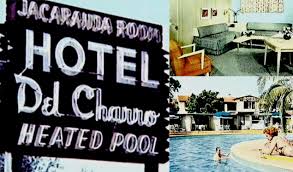
As reported by investigator Ed Tatro, Murchison used to invite prominent figures such as Richard Nixon, Hoover, as well as leaders in Carlos Marcello’s mob family to stay for free. Since Murchison had these important guests over at his place, it was an opportunity for him to hold court and discuss certain matters, perhaps such as getting rid of JFK. Since Nixon isn’t likely to be the one taking shots with a rifle, a conversation with someone within Marcello’s mob family might be a good starting point to get the ball rolling. In “Double Cross”, Chuck Giancana also states his brother Sam referred to Murchison and H.L. Hunt as a business associates. There is one important facet to keep in mind when discussing the US mob, at least during those times, but even till this day, although they are broken up into different families and territories, they tend to partner in many business opportunities or circumstances and the purpose of The Commission was to mediate any disputes. It’s doubtful a plan of this magnitude was whispered across all the US mob leaders as too many people in the know could tip off authorities, but if Marcello was involved, it makes perfect sense for at least his closest underworld allies to be in the mix such as Sam Giancana of Chicago and Santo Trafficante of Tampa. Marcello, Trafficante, and Giancana had lost the biggest business interests in Cuba, gained CIA connections from programs like Project Freedom and other business ventures, plus lastly had enough hatred for the Kennedys by 1963 to make it happen. If that isn’t enough of a connection, both Carlos Marcello and Santo Trafficante shared the same lawyer, Frank Ragano, who also happened to be the lawyer for Jimmy Hoffa, another member of the ‘I Hate Kennedy’ fan club.
As reported by investigator Ed Tatro, Murchison used to invite prominent figures such as Richard Nixon, Hoover, as well as leaders in Carlos Marcello’s mob family to stay for free. Since Murchison had these important guests over at his place, it was an opportunity for him to hold court and discuss certain matters, perhaps such as getting rid of JFK. Since Nixon isn’t likely to be the one taking shots with a rifle, a conversation with someone within Marcello’s mob family might be a good starting point to get the ball rolling. In “Double Cross”, Chuck Giancana also states his brother Sam referred to Murchison and H.L. Hunt as a business associates. There is one important facet to keep in mind when discussing the US mob, at least during those times, but even till this day, although they are broken up into different families and territories, they tend to partner in many business opportunities or circumstances and the purpose of The Commission was to mediate any disputes. It’s doubtful a plan of this magnitude was whispered across all the US mob leaders as too many people in the know could tip off authorities, but if Marcello was involved, it makes perfect sense for at least his closest underworld allies to be in the mix such as Sam Giancana of Chicago and Santo Trafficante of Tampa. Marcello, Trafficante, and Giancana had lost the biggest business interests in Cuba, gained CIA connections from programs like Project Freedom and other business ventures, plus lastly had enough hatred for the Kennedys by 1963 to make it happen. If that isn’t enough of a connection, both Carlos Marcello and Santo Trafficante shared the same lawyer, Frank Ragano, who also happened to be the lawyer for Jimmy Hoffa, another member of the ‘I Hate Kennedy’ fan club.
The US mob have also had a long standing policy of not killing police or public officials as it could bring down a lot of heat from law enforcement (yet a segment of them were about to whack the President?). This rule of not shooting cops or public officials was orchestrated by Charles “Lucky” Luciano who had fellow gangster Dutch Schultz killed for threatening to take out New York District Attorney Thomas Dewey during the 1930’s.
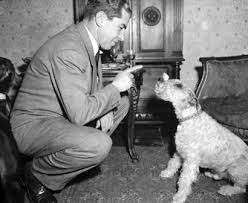


Luciano is credited with organizing the US mobs into a business enterprise and forming The Commission to address disputes. As a thank you, Dewey would years later convict Luciano on charges of running a prostitution ring (which is a real slap in the face for a high-echelon mob figure).
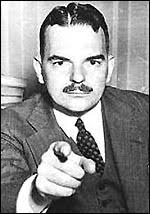

By 1962, Luciano had been deported to Italy and although was still involved mob affairs, his position had been marginalized due to his distance from the US. That being said, he was still a powerful enough figure that if he got wind of a plot against the President, it’s likely he would’ve done something to veto it. This all means either the plot against JFK wasn’t hatched until 1963, or that only a segment of the mob was in on it, not nationwide. It turns out Luciano would never see the year 1963 as he suddenly dropped dead of a heart attack at an airport in 1962 while he was waiting for the arrival of a movie producer to discuss a film on his life. He walked inside a nearby restaurant to order a sandwich, went outside to meet the producer, and died before he was able to pick up his food. (Was this “heart attack” from a poke of a needle? Was the CIA-Mob worried what he might tell the movie producer about subjects like Cuba? Or was the CIA-Mob just removing someone who would veto any action against JFK? Perhaps the many years as a criminal put a strain on Luciano’s heart and he didn’t eat enough Honeynut Cheerios).


Never knowing what Luciano’s position would’ve actually been on the mob assisting in killing the President, all that can be detected is that the environment for such a thing to happen would’ve been easier with Luciano gone versus still alive.
Luciano is credited with organizing the US mobs into a business enterprise and forming The Commission to address disputes. As a thank you, Dewey would years later convict Luciano on charges of running a prostitution ring (which is a real slap in the face for a high-echelon mob figure).
By 1962, Luciano had been deported to Italy and although was still involved mob affairs, his position had been marginalized due to his distance from the US. That being said, he was still a powerful enough figure that if he got wind of a plot against the President, it’s likely he would’ve done something to veto it. This all means either the plot against JFK wasn’t hatched until 1963, or that only a segment of the mob was in on it, not nationwide. It turns out Luciano would never see the year 1963 as he suddenly dropped dead of a heart attack at an airport in 1962 while he was waiting for the arrival of a movie producer to discuss a film on his life. He walked inside a nearby restaurant to order a sandwich, went outside to meet the producer, and died before he was able to pick up his food. (Was this “heart attack” from a poke of a needle? Was the CIA-Mob worried what he might tell the movie producer about subjects like Cuba? Or was the CIA-Mob just removing someone who would veto any action against JFK? Perhaps the many years as a criminal put a strain on Luciano’s heart and he didn’t eat enough Honeynut Cheerios).
Never knowing what Luciano’s position would’ve actually been on the mob assisting in killing the President, all that can be detected is that the environment for such a thing to happen would’ve been easier with Luciano gone versus still alive.
Let’s Order French
The American mob wasn’t the only crime syndicate with casino interests in Cuba, the Corsican mob had a presence there as well. With that in mind, it makes sense for the likes Santo Trafficante or Carlos Marcello, who were heavy into Cuba, to rub elbows with French mob leaders such as Antoine Guérini.
If any attempt on the President’s life went wrong and the assassins caught, it would be an absolute disaster for whoever was behind it. For a hit of this magnitude it only makes sense to hire foreign killers because if they’re caught, they can claim they were hired from a great number of different sources and nothing would be traced back to the US mob or the CIA. In Episode 2 of TMWKK writer Stephen J. Rivele unearth a French Connection in the murder of JFK. In addition to this investigative work which led to a book, years later he would also go on to write the screenplay to the 1995 film “Nixon”. Although he doesn’t mention how he got this lead to begin with (perhaps to protect the identity of a source) he came upon a jailed Corsican drug trafficker by the name of Christian David. Imprisoned in the US on a drug charge, David was known to be the head of the Corsican drug pipeline from Latin America, and on the side served as an intelligence source for several different countries. According to Rivele, in exchange for helping David find a good lawyer to avoid extradition back to France, David agreed to provide bits and pieces of his knowledge on JFK’s assassination.
From what David told Rivele, he was initially offered the contract to take part in the assassination by Antoine Guérini in May or June of 1963, but he turned it down as it felt it was too risky when he learned it was to take place inside the US. Eventually the contract went out to three other killers who accepted the mission. One of the killers confirmed by David turned out to be Lucien Sarti, the other two David refused to name since they were still alive at the time he spoke to Rivele during the 1980’s (Sarti was killed in Mexico City in 1972).
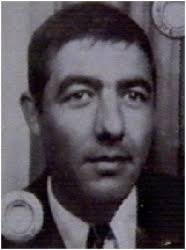
Providing further details from a bar conversation he attended in Argentina around 1965-66, David said the team crossed the US border using Italian passports in Brownsville, TX, where they met with associates from the Chicago mob (ding-ding-ding Sam Giancana’s involvement) who spoke Italian. They were then driven to a safe house in Dallas and canvased the Dealey Plaza area with photographs to look for the best location to set up a triangular crossfire trap for JFK’s parade. After Rivele showed David a map of the area, David point out that the two unidentified killers were located in buildings in back of the motorcade, which would be the TSBD and the Dal-Tex Building. Sarti initially wanted to position himself on the railroad bridge, but since it was guarded, he found a spot behind the picket fence on the infamous grassy knoll area. As was his reputation for doing so, Sarti also wore a uniform, either military or Dallas PD, and in addition used a special exploding bullet that fragments upon impact.
Providing further details from a bar conversation he attended in Argentina around 1965-66, David said the team crossed the US border using Italian passports in Brownsville, TX, where they met with associates from the Chicago mob (ding-ding-ding Sam Giancana’s involvement) who spoke Italian. They were then driven to a safe house in Dallas and canvased the Dealey Plaza area with photographs to look for the best location to set up a triangular crossfire trap for JFK’s parade. After Rivele showed David a map of the area, David point out that the two unidentified killers were located in buildings in back of the motorcade, which would be the TSBD and the Dal-Tex Building. Sarti initially wanted to position himself on the railroad bridge, but since it was guarded, he found a spot behind the picket fence on the infamous grassy knoll area. As was his reputation for doing so, Sarti also wore a uniform, either military or Dallas PD, and in addition used a special exploding bullet that fragments upon impact.
Although the Warren Report and the popular accepted theory was that three shots were fired at the motorcade from behind, which will be discussed later, David said there were four shots:
1st – Came from behind and hit Kennedy in the back
2nd – Came from behind and hit Gov. Connally in the back, who was riding in front of Kennedy.
3rd - Sarti’s front shot from the grassy knoll that hit Kennedy in the head.
4th – Came from behind and missed Kennedy’s car entirely (likely wounded James Tague).
With these four shots, two of them came instantaneously of each other, but David didn’t say which.
After the chaos that surrounded the area after the shooting, the shooters were able to slip out and return to their safe house in Dallas where they waited for the heat to blow over for ten days. Afterwards they were flown on a private jet from Dallas to Montreal, and then made their final trip home to Marseille.
Rivele asked David if anyone else could confirm this story, and David suggested he get in touch with a man named Michel Nicoli. It turns out that Nicoli and David both knew Sarti and ran in the same drug trafficking circles. After years of drug trafficking himself, Nicoli entered the witness protection program for the US government, and his handler, DEA agent Michael Tobin, described Nicoli to Rivele as the best witness he’s seen in his thirty-years in the business. By 1986 Rivele was able to get in touch with Nicoli who said he was at the same bar as David in Argentina when the story was told, and confirmed everything David stated.

Neither David nor Nicoli mention if the story was told by Sarti or any of the other contracted killers, so it could’ve just been the ramblings of a drunken Frenchman. Both David and Nicoli stated the killers were paid in heroin and they visited David in Argentina to turn it into cash for them. Nicoli said he doesn’t know who specifically was behind the plot, except the general phrase “mafia”. In that case, “mafia” would likely be referring to the Trafficante-Marcello-Giancana trio.
Neither David nor Nicoli mention if the story was told by Sarti or any of the other contracted killers, so it could’ve just been the ramblings of a drunken Frenchman. Both David and Nicoli stated the killers were paid in heroin and they visited David in Argentina to turn it into cash for them. Nicoli said he doesn’t know who specifically was behind the plot, except the general phrase “mafia”. In that case, “mafia” would likely be referring to the Trafficante-Marcello-Giancana trio.
Rivele had Nicoli make the same statements in from of his DEA agent handler Tobin, which he did in 1987, and from there Tobin said they needed a second witness in order to appear in front of a grand jury. David’s worst fears came to reality as he was transferred to a prison in France to face sentencing in the shooting of a French policeman in 1966. Thinking his testimony of the JFK case might harm his position in the police shooting case, he refused to cooperate, leaving Nicoli as the sole potential witness and ending the investigation. David’s second place prize was a letter he sealed and handed over to his lawyer in France with instructions to not open without his consent. In the letter his lawyer believes contains further details in regards to the killing of JFK, in which the lawyer felt there was more than just one person involved. This letter was supposedly opened and read by two researchers, one in Dallas and another in France, how they got access to it is unknown, but they’ve refused to make the findings public.
Although Rivele wasn’t able to spark a new investigation into the case on his own, he handed all his materials over to the FBI by 1988 in hopes they would be able to dig deeper into the plot, but from there it hit a brick wall and nothing has been done on their part. Rivele initially thought he found the identities of the two other shooters, but those suspects turned out to have solid alibis at the time of JFK’s death. Rivele himself claims he hasn’t investigated this Corsican angle any further since the time he passed the ball to the FBI.
Making Dealey Plaza Unsecure
Col. Fletcher Prouty also revealed that basic protection measures for JFK weren’t taken for his scheduled parade in Dallas. Special Group 113 from San Antonio wasn’t deployed to Dallas as their commander was told they were not needed. These soldiers would have provided a military presence in the crowd and helped protect the President against any attacks. The Secret Service didn’t have any agents on record as positioned on the streets along the parade route either. When the President’s limousine made that funky turn on Houston and Elm in front of the TSBD which caused the vehicle to slow down to 11 mph, by procedure when the President’s limo goes below 44 mph, agents are supposed to protect it as in jog alongside of it or find some other measures to not leave the President wide open to an easy shot.
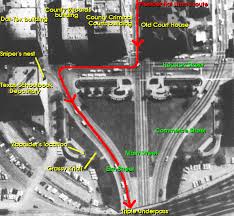

JFK was left unguarded on both of his sides while the vehicle slowed down on that turn, in fact an eyewitness, Mary Woodward of the Dallas Morning News at the time, stated the limo seemed to slow down again after the first shot (perhaps to make sure whoever finishes the job) and it took “forever” for the car to get out of harm’s way. She also mentioned that the 2nd and 3rd shots came on top of each other, with one coming from the grassy knoll, which basically goes along what Corsican drug trafficker Christian David was told in that two of the shots came almost at the same time and Sarti’s headshot from the grassy knoll.
JFK was left unguarded on both of his sides while the vehicle slowed down on that turn, in fact an eyewitness, Mary Woodward of the Dallas Morning News at the time, stated the limo seemed to slow down again after the first shot (perhaps to make sure whoever finishes the job) and it took “forever” for the car to get out of harm’s way. She also mentioned that the 2nd and 3rd shots came on top of each other, with one coming from the grassy knoll, which basically goes along what Corsican drug trafficker Christian David was told in that two of the shots came almost at the same time and Sarti’s headshot from the grassy knoll.
More people also stated the limo seemed to have slowed down after the first shot. Jean Hill, who was the closest witness to the car when Kennedy was shot, According to Hill "the motorcade came to almost a halt at the time the shots rang out". James Chaney (one of the four Presidential motorcyclists) - stated that the limousine "after the shooting, from the time the first shot rang out, the car stopped completely, pulled to the left and stopped.". The driver of the limo was Bill Greer.
There were also open windows in the buildings all along the parade route, but especially in Dealey Plaza, that by normal Secret Service protection codes would have not been permitted.
One would think Secret Service agents would need to be in top form if they knew they had a parade coming up tomorrow in a state like Texas that wasn’t too kind with the liberal-minded Kennedy, but reports were that the night before agents were partying in a Fort Worth nightclub called The Cellar as late as 5am. If these reports are true, was it gross negligence, or a premeditated action to use as an excuse the next day if something were to happen to the President?
Another line of defense of the President would have been the Dallas Police themselves, and in charge of them as well as the parade route would’ve been Dallas’ mayor Earle Cabell.
Why should the last name Cabell strike a chord?
Earle Cabell’s brother was former CIA Deputy Director Charles Cabell, one of the three high-level CIA officials JFK forced to resign after the Bay of Pigs invasion failed (Think it would take a lot of arm-twisting to have Earle Cabell help out in killing the man who had his brother fired and disgraced?). According to Sam Gianana’s paraphrased account in “Double Cross”, “They made sure it was so loose down there on the day of the hit, shit, a four-year-old could’ve nailed Jack Kennedy.”
Also to work out the logistics in terms of other Dallas law officials, there’s also LBJ’s legal team in Edward Clark to solve that problem. Based in the state’s capital in Austin, Clark would be in position in make any arrangements where government people needed to be, or not to be. Barr McClellan in Episode 9 of TMWKK shares a road trip he took with Don Thomas, one of the partners in Clark’s law firm. Thomas hated flying, so they had a long drive in Texas on while driving Thomas mentioned to McClellan that “I’m the only one who knows about box thirteen”, referring to the alleged voter scam in the 1948 election that got LBJ elected Senator. Later on Thomas made the remark, “Clark took care of things in Dallas.”
Expanding on the information Sam Giancana shared with his younger brother Chuck in “Double Cross”, and from what Chuck also picked up later on, the entire assassination plot took months of planning and dozens of men were involved, a combo of CIA and mob-types. Other cities such as Los Angeles, Chicago, and Miami were considered, but eventually Dallas was selected the winner. Giancana used Chicago gangster Johnny Roselli as the go-between with the CIA, Trafficante, Marcello, and Jimmy Hoffa in helping get everything set up. What Giancana doesn’t confirm with is the use of the French hired assassins as the shooters. Instead, he mentions two of Marcello’s men, two of Trafficante’s Cuban exile associates, and members of the Chicago mob (Chuck Nicoletti and Richard Cain). Cain was a former Chicago policeman before turning to the dark side of the Force. Nicoletti and Cain were positioned on opposite sides of the TSBD and it was actually Cain firing out the sixth floor window, not Oswald. Another Chicago mobster, Felix "Milwaukee Phil" Alderisio, was on streets to handle any last minute interference with the shooters.
As for the CIA, according to Giancana’s story, they were positioned in a nearby hotel room with walkie-talkie equipment and monitoring the whole affair. In addition to killing JFK, Lee Harvey Oswald was first charged with killing Dallas policeman JD Tippit. According to the Warren Report, Oswald was walking away from his boarding house, where he picked up his revolver, and Tippit pulled up alongside of Oswald since he somewhat matched the description that went out on the police radio of the President’s shooter. Tippit was shot dead, supposedly by Oswald, who then continued on his way to the Texas Theater. Giancana said the Tippit killing was the only thing that got botched. An anti-Castro fanatic, Roscoe White was a member of Dallas PD as Tippit was, and both were supposed to kill Oswald, the pasty in the whole plot. Instead, Tippit got cold feet, so White ended up killing Tippit instead which let Oswald slip away. Hoover was in no way going to help Bobby Kennedy uncover this plot, so he did all he could to help cover it up. Also according to Giancana, both LBJ and Nixon knew well of the plot beforehand and met with them in Dallas several times before the actual assassination.
Where did they dig up Oswald?
He was being set up by the CIA for a job like this before he even knew it.
A fatherless child born in New Orleans, he was taken under the wing of his uncle, who was a leader in Carlos Marcello’s crime family. As Oswald grew older, he served in the Civil Air Patrol, a known breeding ground for CIA recruits, and made acquaintance with David Ferrie, a CIA operative himself and a pilot used by both the Chicago and Marcello’s family to move drugs and guns out of Central America. Ferrie was portrayed in the 1991 Oliver Stone film “JFK” by actor Joe Pesci.
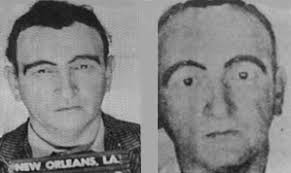
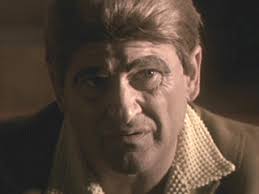
From there Oswald went to serve in the Marines and shortly after was sent to a base in Japan run by the Office of Naval Intelligence for a series of intensive training sessions, likely meaning he was becoming a CIA agent. Oswald’s time in Russia was as a US spy, and unlike how he was portrayed in the media after JFK’s assassination, he was actually a right-wing supporter of killing Castro.
From there Oswald went to serve in the Marines and shortly after was sent to a base in Japan run by the Office of Naval Intelligence for a series of intensive training sessions, likely meaning he was becoming a CIA agent. Oswald’s time in Russia was as a US spy, and unlike how he was portrayed in the media after JFK’s assassination, he was actually a right-wing supporter of killing Castro.
Guy Banister himself was a former Naval Intelligence officer and used to be head of the FBI Office in Chicago.

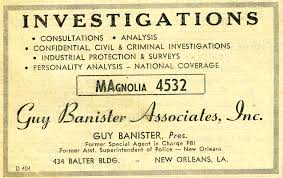
While running a private investigator firm (likely a cover job) he oversaw the creation of Oswald’s cover story as a communist sympathizer when Oswald returned to New Orleans, and his pro-commie imagine made him the perfect patsy for the killing of a US President. Described as gullible, Johnny Roselli met with Marcello and Banister and they came to the conclusion of Oswald being perfect to take the blame for the whole thing. Oswald could be tricked into thinking he was using his pro-communist standing as a way to spy on a group of communists set on killing the President, but instead when the President is killed differently than he anticipated, have him portrayed as the communist assassin.
While running a private investigator firm (likely a cover job) he oversaw the creation of Oswald’s cover story as a communist sympathizer when Oswald returned to New Orleans, and his pro-commie imagine made him the perfect patsy for the killing of a US President. Described as gullible, Johnny Roselli met with Marcello and Banister and they came to the conclusion of Oswald being perfect to take the blame for the whole thing. Oswald could be tricked into thinking he was using his pro-communist standing as a way to spy on a group of communists set on killing the President, but instead when the President is killed differently than he anticipated, have him portrayed as the communist assassin.
How does Jack Ruby fit in?
If the Giancana tales aren’t far-fetched enough, he describes Ruby as the Outfit’s (name for Chicago mob family) representative in Dallas, working the rackets such as gambling and prostitution, but also working with the CIA on gunrunning operations and helping with the Bay of Pigs invasion.

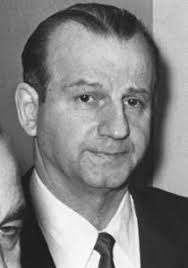
Originally from Chicago, Ruby was sent down to Dallas and soon-enough made friends with many of the local Dallas PD officers who frequently visited his burlesque club, The Carousel Club. Ruby was familiar with CIA pilot-operative David Ferrie and worked with him on some of these operations, such as handling Oswald. When White and Tippit failed to kill Oswald like they were instructed to, Ruby had no choice but to use his knowledge and relationship with the Dallas PD to get close enough to shoot Oswald as he was being transferred to the county jail.
Originally from Chicago, Ruby was sent down to Dallas and soon-enough made friends with many of the local Dallas PD officers who frequently visited his burlesque club, The Carousel Club. Ruby was familiar with CIA pilot-operative David Ferrie and worked with him on some of these operations, such as handling Oswald. When White and Tippit failed to kill Oswald like they were instructed to, Ruby had no choice but to use his knowledge and relationship with the Dallas PD to get close enough to shoot Oswald as he was being transferred to the county jail.
Giancana mentions Hoffa in “Double Cross” as involved in the planning, but no further details than that, so how did he play a role?
Don’t Drink And Drive
Another very interesting book touches upon this subject called “I Heard You Paint Houses” by Charles Brandt. The book centers around Teamsters official and mob hitman Frank “The Irishman” Sheeran who gave his testimony before his death. The book is being discussed into a movie deal with Martin Scorsese as the director and parts divided out amongst Hollywood gangster-role icons Robert DeNiro, Al Pacino, and Joe Pesci. Sheeran was listed on Rudolph Giuliani’s RICO suit against the US mob in the early 1980’s and was one of the two only non-Italians mentioned. Coming up as a hitman for Northeastern Pennsylvania mob boss Russell Bufalino, Sheeran was introduced to Hoffa by Buffalino and given a position within the Teamsters. One of Hoffa’s opening statements to Sheeran was, “I heard you paint houses”, a reference that Hoffa knew Sheeran was a hitman, with blood splattering the walls as the term for ‘painting houses’.
Sheeran states that on one of his many missions for the Hoffa and the mob throughout the years, one had close ties to JFK’s murder. Around a week before the assassination on November 22, 1963, Sheeran received a call from Hoffa to contact Bufalino. After speaking to his long time mob conduit, Sheeran was instructed to go to Monte’s restaurant in Brooklyn, NY, a known hangout for members of New York’s Genovese crime family where he met up with mobster/union official Tony Provenzano (Tony Pro). Sheeran was handed a duffle bag containing three rifles and instructed to drive down to Baltimore to meet up with their “pilot friend”, who turned out to be Carlos Marcello’s pilot, David Ferrie. Sheeran handed off the package to Ferrie and another Genovese family member, which Sheeran didn’t want to name, and a week later JFK was killed in Dallas.
The reason Sheeran needed to make that trip?
About twelve years later in a hotel room with Sheeran, Hoffa was livid about the mobs collective stance on maintaining Fitzsimmons and opposing Hoffa’s bid to run for Teamster’s president that he started spouting off about details behind the mob’s participation in the conspiracy against JFK. One of them was about the package of rifles Sheeran brought to Baltimore. Hoffa claimed the original rifles were in the trunk of a thunderbird that crashed because the driver was drunk, so they needed replacements. He also said Giancana, Trafficante, and Marcello was the driving forces behind it all, essentially the same CIA-Mafia cast that was involved in setting up the Bay of Pigs invasion and getting rid of Castro.
Heads-up From Miami
On November 9, 1963, a Miami police informant named William Somersett, a union organizer with right-wing connections, met with Joseph A. Milteer, a wealthy right-wing extremist and known white-supremacist. Miami PD as well as the FBI was monitoring Milteer for his political affiliations and connections.
Sticking to one possible conspiracy at a time, some researchers have also discovered links that Milteer secured associates from Carlos Marcello’s mob to carry out the assassination of Martin Luther King.
But getting back to JFK, Somersett had his room set up with a bug by Miami police and on November 9th Milteer discussed JFK’s planned trip to Miami on November 18th and mentioned there was a plan to kill him while he was going to be in town.
Here is a written transcript of the conversation on the subject of JFK:
Somersett: ...I think Kennedy is coming here on the 18th...to make some kind of speech...I imagine it will be on TV.
Milteer: You can bet your bottom dollar he is going to have a lot to say about the Cubans. There are so many of them here.
Somersett: Yeah, well, he will have a thousand bodyguards. Don't worry about that.
Milteer: The more bodyguards he has the easier it is to get him.
Somersett: Well, how in the hell do you figure would be the best way to get him?
Milteer: From an office building with a high-powered rifle. How many people does he have going around who look just like him? Do you now about that?
Somersett: No, I never heard he had anybody.
Milteer: He has about fifteen. Whenever he goes anyplace, he knows he is a marked man.
Somersett: You think he knows he is a marked man?
Milteer: Sure he does.
Somersett: They are really going to try to kill him?
Milteer: Oh yeah, it is in the working. Brown himself, [Jack] Brown is just as likely to get him as anybody in the world. He hasn't said so, but he tried to get Martin Luther King.
(Jack Brown was an important figure in the Klu Klux Klan) After a few more minutes of conversation, Somersett again spoke of assassination:
Somersett: Hitting this Kennedy is going to be a hard proposition, I tell you. I believe you may have figured out a way to get him, the office building and all that. I don't know how the Secret Service agents cover all them office buildings everywhere he is going. Do you know whether they do that or not?
Milteer: Well, if they have any suspicion they do that, of course. But without suspicion, chances are that they wouldn't. You take there in Washington. This is the wrong time of the year, but in pleasant weather, he comes out of the veranda and somebody could be in a hotel room across the way and pick him off just like that.
Somersett: Is that right?
Milteer: Sure, disassemble a gun. You don't have to take a gun up there, you can take it up in pieces. All those guns come knock down. You can take them apart.
Before the end of the tape, the conversation returns to Kennedy:
Milteer: Well, we are going to have to get nasty...
Somersett: Yeah, get nasty.
Milteer: We have got to be ready, we have got to be sitting on go, too.
Somersett: Yeah, that is right.
Milteer: There ain't any count-down to it, we have just go to be sitting on go. Countdown, they can move in on you, and on go they can't. Countdown is all right for a slow prepared operation. But in an emergency operation, you have got to be sitting on go.
Somersett: Boy if that Kennedy gets shot, we have got to know where we are at. Because you know that will be a real shake...
Milteer: They wouldn't leave any stone unturned there. No way. They will pick somebody within hours afterwards, if anything like that would happen, just to throw the public off.
Somersett: Oh, somebody is going to have to go to jail, if he gets killed.
Milteer: Just like Bruno Hauptmann in the Lindbergh case, you know.
The conversation recorded by Miami PD was made known to the FBI and Secret Service which caused JFK’s detail beefed up while he visited Miami. Milteer was questioned by the FBI regarding what he was taped saying, but they found nothing to hold him on and he was released. The same informant, William Somersett, later claimed Milteer called him from Dallas on the day of the shooting with the comment, “The President will never be in Miami again”, but no solid evidence has ever been produced of Milteer being in that city of November 22, 1963. A photograph of a man standing in Dealey Plaza as the President’s motorcade drove by does looking striking similar to Milteer, but it’s never been officially confirmed that it was him depicted.
Milteer has never been linked to any of the popular suspects in the possible JFK conspiracy such as LBJ, CIA, the mob, Cuban exiles, Oswald, etc, so it’s difficult to determine how he would’ve had knowledge of any plot. Although he mentioned the use of a high-powered rifle from an office building and the need for the cops to pick someone up a few hours later, a patsy like Oswald, he doesn’t mention more than one shooter or give any definite details such as the names involved. The only slight possibility is his right-wing political views, which could’ve put him in circles of people from the Suite 8F Group that were made up of alot of LBJ’s cronies and political allies that observed right-wing views. Rumors could’ve leaked out through the grapevine that something was going to be done about JFK and perhaps Milteer heard a very basic version of the plot. The fact he mentioned there’s an active plot to shoot the President from a building with a high-powered rifle when he comes to Miami, and four days later something like that basically happens in Dallas can’t be a total coincidence, can it?
Guess Who’s Coming to Dinner
Another reason Episode 9 of TMWKK received the harshest of criticism was the story told by the self-proclaimed long-time mistress of Lyndon Johnson named Madeleine Duncan Brown. She claimed her son Steven was fathered by LBJ, but the biggest controversy she made was a story about a party she attended the night before the assassination at one of the homes of “Big Oil” man Clint Murchison in North Dallas.
In attendance of this party was Murchison of course, H.L. Hunt, Richard Nixon, Hoover (who she claimed the party was for) and last, but not least, Lyndon Johnson who showed up later on unexpected. She said LBJ came in around 11pm when the party was dying down, and all the big shots such as LBJ, Murchison, Nixon, Hunt, and others from the group Suite8F people went into a conference room. The atmosphere got real tight according to her, and there was a feeling something strange was brewing in the air. When the shotgun meeting was over, she said LBJ came over to her and said something to the extent of, “Those (bleeping) Kennedys will never embarrass me again, that’s not a threat, that’s a promise.”
Seems too good to be true?
May Newman, who worked for Clint Murchison’s second wife Virginia from 1962 till Virginia died in 1997 in a different Murchison home, confirmed the party did occur, but was not in attendance to see who was actually there with her own eyes.
How does she know it happened?
The cook who was working the party, Buella May Holeman, told May Newman she had to cook quail for a special guest (Hoover) and asked if she wanted to come over. At the time, Newman had no idea who Hoover really was and felt he wasn’t important enough to see. She said she would’ve went over if it was a Hollywood star or singer, but apparently she didn’t know of Hoover….who was somewhat famous as Director of the FBI. Virginia Murchison’s driver, Jule Feifer, also told May Newman on the night before the assassination he was instructed by Virginia’s son, John, to pick up a man at the airport flying in from Washington DC they nicknamed ‘Bulldog’. What stood out to Feifer that night that he had to take him back and forth from the airport to this Murchison party, and Hoover gave him no tip.
May Newman said the mood in the Murchison home she worked in was joyful when JFK died as champagne and caviar were served all week thereafter.
Getting back to Madeleine Brown, she went on to say just hours before the assassination, LBJ called her and repeated the same remark he gave to her the night before at the party, Those (bleeping) Kennedys will never embarrass me again, that’s not a threat, that’s a promise.” Madeleine said a short time after the assassination, she confronted LBJ on the matter and he confessed no direct involvement in the plot, but it was the “Fat Cats of Texas and the Intelligence people” behind it. The ‘Fat Cats of Texas’ would be referring to the oilmen.
In press interviews Lyndon Johnson gave after his Presidency, he stated he believed Oswald pulled the trigger that killed Kennedy, but he wasn’t comfortable with the Warren Commission’s finding that he was a lone assassin.
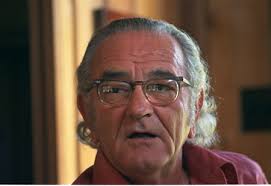
Was those his true feelings or was he just playing the role of the innocent conspiracy theorist so nobody would ever think to look at him as a suspect?
Part Two: The Planning – Results
The Washington Post ran a story in April 1981 about the hours after the assassination, Bobby Kennedy called a member of the Project Freedom team and remarked, “One of your guys did it!” This could’ve been after Bobby saw Oswald’s face on television or something about the way in which his brother was killed sounded strangely familiar to the plans he knew of that were on the shelf to remove Castro.
French authorities were quick to provide alibis for the supposed two other assassins Steve Rivele thought he uncovered, that they wouldn’t have been able to murder JFK in Dallas on November 22, 1963 (perhaps afraid America would stop importing their toast and fries). TMWKK producer Nigel Turner responded by reminding everyone they’ve had 25 years to come up with solid alibis. When asked why not just try to interview any of the two suspected assassins, Tuner described the idea as too dangerous.
Infamous former CIA agent E. Howard Hunt (no relation to H.L. Hunt) was involved in the Bay of Pigs invasion, but is best known for being one of the men arrested in the break-in of the Democratic Headquarters at the Watergate Hotel in 1972. In the closing years and months of his life, according to his son, Saint John Hunt, his father provided “deathbed confessions” of all the secrets he knew from the years being a CIA operative and the years after. In regards to the JFK assassination, Hunt said it was orchestrated from as high as LBJ, and in addition to his own involvement in the conspiracy, he also named the same dead French hitman both Christian David and Michele Nicoli confirmed, Lucien Sarti, the one who died in Mexico City in 1972. Nothing else by Hunt is mentioned in regards to any other hired Corsicans for the job, but he does point out that Sarti was positioned on the grassy knoll area (something Christian David also specified). The operation was codenamed “The Big Event”. These confessions were turned into a (surprise-surprise) book deal titled “American Spy: My Secret History in the CIA, Watergate, and Beyond”.
Howard Hunt, along with Frank Sturgis, is believed by many to be two out of the “Three Tramps” photographed being taken into police custody at Dealey Plaza. There are no official police records of who these three people actually were. Sturgis was arrested along with Hunt in the Watergate break-in.
Hunt also revealed the assassination was supposed to take place in Miami, which coincides what Joseph Milteer was caught talking about.
Christian David was eventually released from jail in France, but as of 2008 his whereabouts have been difficult to obtain.
The Secret Service’s notes of the motorcade that day were destroyed. The medical team, which is usually positioned in the middle or closer to the President in case he has a medical emergency, was located at the very rear of the motorcade. No agents were jogging alongside the President’s limo when it drastically reduced its speed at the turn of Houston and Elm in near the TSBD. Windows at the TSBD and other nearby windows were wide open well before the motorcade even reached that point of the parade.
The parade route was supposed to take the President to the International Trade Mart where he was schedule to have lunch. The directions chosen was heading down Main St., and instead continuing straight down Main as a method to get to the entrance to the Stemmons Freeway, the motorcade turned right down Houston St. that headed towards the TSBD (in which a lone gunman from the 6th floor of the TSBD would’ve had a higher percentage shot to hit the President between the eyes instead of trying to get him from behind as he was driving away on Elm), then as it approached the TSBD it had to make an extremely awkward left turn at Elm St., which brought the vehicle to the dangerous 11mph speed, and proceed down Elm as a method to reach Stemmons Freeway. Of course, shots were fired and the President was hit before they reached the triple-bypass railroad bridge in front of the freeway entrance.
Why did the motorcade proceed to Houston and Elm instead of just continuing down Main St?
On the other side of the triple-bypass there is a concrete curb which blocks traffic from Main St. from accessing the freeway entrance. The curb is no higher than an ordinary street curb that a car could drive over theoretically, and although it would’ve been against the driving laws of the city, this is the President of the United States after all, a concession could’ve been made.

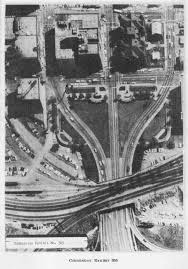
At present day, the concrete dividers would be too higher for a car to smoothly pass over on, but on 1963 that might’ve not been the case as Dallas police officer Joe Smith testified in front of the Warren Commission:
Mr. LIEBELER. Are you familiar with the traffic patterns on these three streets here, Commerce, Main, and Elm Streets, as they go down under the triple underpass?
Mr. SMITH. Yes sir.
Mr. LIEBELER. The motorcade came down Main Street from the east to intersection of Main Street and Houston, did it not?
Mr. SMITH. Yes; headed west on Main.
Mr. LIEBELER. Yes; and it turned right on Houston Street and then turned left on Elm and was headed toward the triple underpass when the assassination occurred. What would have prevented the motorcade from going directly down Main Street under the triple underpass, remembering now that the motorcade wanted to go onto Stemmons Freeway?
Mr. SMITH. I don't know, sir.
Mr. LIEBELER. Now, could you have gone straight down Main Street and gotten onto Stemmons Freeway down here?
Mr. SMITH. Yes, sir.
Mr. LIEBELER. Where the three streets go under the triple overpass, there is a concrete barrier between Elm Street and Main Street; is there not?
Mr. SMITH. What do you mean?
Mr. LIEBELER. Where the streets actually go under the railroad tracks here.
Mr. SMITH. Yes, sir.
Mr. LIEBELER. Now where is the entrance as we go off, as we see the three streets going off the picture here, Commission Exhibit No. 354? Where is the entrance to the Stemmons Freeway?
Mr. SMITH. It is back off.
Mr. LIEBELER. It is not shown on the picture?
Mr. SMITH. No, sir; it is back off here.
Mr. LIEBELER. To go down Stemmons Expressway or Freeway towards the trade mart, you would have to turn how? Would you turn to your right?
Mr. SMITH. Yes, sir.
Mr. LIEBELER. Now could you have actually gone off to the right and crossed over Elm Street if you had been on Main Street and gone under the triple underpass?
Mr. SMITH. They merge.
Mr. LIEBELER. They all merge together down there?
Mr. SMITH. Yes, sir.
Mr. LIEBELER. So as far as you know, there was no reason why the motorcade couldn't have gone straight down Elm Street and gone on to the Stemmons Freeway headed for the trade mart?
Mr. SMITH. As far as I know, there is no reason.
Mr. LIEBELER. Is it possible that as you come down Main Street, if you stayed directly on Main Street going under the triple underpass, that you might have difficulty in making the turn with a big car from Main Street to go onto Stemmons Freeway?
Mr. SMITH. Yes, sir.
Mr. LIEBELER. I don't think I have any more questions about the situation, unless you can think of something else that you might have seen or observed that day that I haven't asked you about, that you think the Commission should know.
Mr. SMITH. Sir, I just can't think of anything else.
Mr. LIEBELER. I want to thank you very much for coming over. I appreciate your cooperation.
Mr. SMITH. Yes, sir; thank you.
What Joe Smith says essentially, was that although it wouldn’t have been completely smooth for the Presidents car to pass over from Main to Elm after the bypass , it was very possible since all the streets merge down there (notice how once Mr. Smith made it known the motorcade didn’t need to make the Houston and Elm turns, Mr. Liebeler of the Warren Commission quickly changed the conversation to focusing on the car being too big to go down Main St. the whole way and ended the questioning session on that note).
It’s really a case of pick your poison, but the decision was made by Dallas city officials and apparently okayed by the Secret Service to bring the motorcade towards the TSBD and grassy knoll area that required two turns, instead of just continuing down Main St. and making a one slight-bumpy right turn after the bypass bridge to get onto Stemmons Freeway.
What Dallas city officials would make those choices?
The mayor Earle Cabell would be a good bet, the brother of fired CIA Deputy Director Charles Cabell, who Chuck Giancana said his older mob boss brother Sam was on friendly terms with. Plus any other city officials would lean towards the direction of Edward Clark’s position in the state capital of Austin (a client from Clark’s law firm in Mac Wallace got a five-year suspended sentence from a judge after cold-bloodedly shooting John Kinser five times, so Clark must have pull with city officials in Texas).
Was the parade route brought there on purpose knowing that’s where a shooter or shooters would have the best opportunity to strike, was it gross negligence, or an innocent bad decision?
Sam Giancana, the boss of the Outfit (Chicago crime family) went on a hiatus to Mexico from 1966 and didn’t return to town until 1975 after he was kicked out by the Mexican government. Law authorities believe he was kicked out of Chicago by the Outfit for becoming too high-profile by the mid 1960’s and appearing too much in the media. Giancana was made boss after Tony Accardo “retired” in the late 1950’s, although his closest FBI investigator William Roemer believes Accardo was still in charge, but just staying in the shadows to keep the heat off him. Giancana’s overseas empires; such as the casinos in Iran and Latin America being skimmed weren’t being shared with the rest of the Outfit, which angered their top leadership. There was also a rumor he was trying to get his old position back as Outfit boss when he returned to the States.
In 1975, Frank Church and his ‘Select Committee to Study Governmental Operations with Respect to Intelligence Activities’ discovered that Judith Campbell had been involved with both Giancana and John F. Kennedy. It emerged that during the 1960 presidential election Campbell took messages from Giancana to Kennedy. Campbell later claimed these messages concerned the plans to murder Fidel Castro. Kennedy also began an affair with Campbell and used her as a courier to carry sealed envelopes to Giancana. He told her they contained "intelligence material" concerning the plot to kill Castro (Could these papers also been the FBI reports Giancana claimed he received from JFK himself?).
Giancana was scheduled to appear before Church's committee. However, before he could appear, on 19th June, 1975, Sam Giancana was murdered in the basement of his own home. He had a massive wound in the back of the head. He had also been shot six times in a circle around the mouth (in case the first five didn’t work).

What makes it interesting was he was cooking sausages at the time, and due to a recent surgery and health issues he had, he wasn’t supposed to be eating them. Likely, he had to be cooking them for someone else. In addition, there was no sign of forced entry, so this all leads up to the probability he knew his killer. There’s also been the story that he was angered by how the Outfit turned on him and was beginning to cooperate with the FBI as an informant, but his younger brother Chuck believes his dedication to the old mob rules would’ve preventing him from ever becoming a ‘rat’.
What makes it interesting was he was cooking sausages at the time, and due to a recent surgery and health issues he had, he wasn’t supposed to be eating them. Likely, he had to be cooking them for someone else. In addition, there was no sign of forced entry, so this all leads up to the probability he knew his killer. There’s also been the story that he was angered by how the Outfit turned on him and was beginning to cooperate with the FBI as an informant, but his younger brother Chuck believes his dedication to the old mob rules would’ve preventing him from ever becoming a ‘rat’.
Apparently someone didn’t want Sam Giancana talking to the Senate Committee and being asked questions such as mob partnerships with the CIA and killing Castro. The mob might understand the rules that he wouldn’t talk, but in the double-crossing epianodge world of the CIA where there is no omerta or blood oaths, the CIA may not be that sentimental.
Former CIA Director William Colby has been quoted as saying, "We had nothing to do with it."
Mobsters stayed away from Sam Giancana’s funeral, which by mob protocol is a sign of shame and disrespect towards the deceased. Maybe the mob wasn’t behind his murder, maybe they were, but clearly they were not happy with him.
Johnny Roselli, the Chicago mobster named by Giancana as his go-between for the CIA, Trafficante, and Marcello, was also found dead after he too was schedule to appear in front of a Senate Committee. He did testify on June 24th (five days after Giancana’s death) and September 22nd of 1975 for the same Church Committee Giancana was supposed to appear before, regarding the CIA’s plot to kill Castro called Operation Mongoose. After Giancana died, Roselli relocated from the Los Angeles/Las Vegas area to Miami. On April 23, 1976 Roselli was called before the committee to testify about a conspiracy to kill President Kennedy. Three months after his first round of testimony on the Kennedy assassination the Committee wanted to recall Roselli. However, at this point, he had been missing since July 28th. On August 3, Senator Howard Baker, a member of the new Senate Committee, requested the FBI investigate Roselli's disappearance.
They found him……sort of.
On August 9,1976 Roselli's decomposing body was found in a 55-gallon steel fuel drum floating in Dumfounding Bay near Miami, Florida. Roselli had been strangled and shot, and his legs were sawn off.
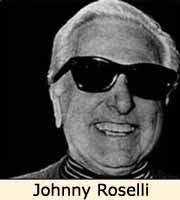
Okay, someone reaaallllly doesn’t want anyone speaking with Senate Committees about the CIA.

Santo Trafficante did appear in front of the Committee, but went unscathed and lived out into his old age, dying of natural causes in 1987. Law Authorities believe Trafficante was behind Roselli’s murder for revealing too much during his questioning, and was worried what Giancana would’ve told, so received permission from the Outfit leadership to have him killed as well.
Carlos Marcello lived to the age of 83, dying in 1993. As he battled advanced stages of Alzheimer’s Disease in the years before he died, he was overheard stating that he killed President Kennedy. (Were the ramblings made up as a result of the disease or did he lose the control of his brain to keep those secrets hidden?)
Bill Bonanno, son of Bonanno crime family founder, Joe Bonanno, stated in his first book, “Bound by Honor” that while doing a prison stretch with Roselli, he told Bonanno he was involved in the assassination and took a shot from the storm drain on the curb alongside Elm St. Also in this book, Bill Bonanno revealed that once everyone saw Jack Ruby kill Oswald on TV, the Bonanno Family recognized Ruby as an associate of Sam Giancana.
Frank “The Irishman” Sheeran of “I Heard You Paint Houses” witnessed Jack Ruby in the presence of Sam Giancana on one of his trips to Chicago.
What happened to Ruby?
He was sentenced to death (should’ve used the Edward Clark’s law firm) in 1964 for the killing of Lee Harvey Oswald.
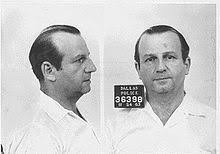
While in prison, Ruby made claims he was being purposely injected with cancer-causing cells. He did develop lung cancer and died at Parkland Hospital in 1967 at the age of 55 before his upcoming appeal was to take place. On the day Ruby killed Oswald, he was escorted to a jail cell and frantically asked police officer Don Archer for a cigarette. After Ruby’s nerves calmed, Archer offered Ruby another cigarette in which Ruby responded, “I don’t smoke”. Newspaperman Seth Kantor, who became friendly with Ruby, described Ruby as a health nut who swam in his pool almost every morning.
While in prison, Ruby made claims he was being purposely injected with cancer-causing cells. He did develop lung cancer and died at Parkland Hospital in 1967 at the age of 55 before his upcoming appeal was to take place. On the day Ruby killed Oswald, he was escorted to a jail cell and frantically asked police officer Don Archer for a cigarette. After Ruby’s nerves calmed, Archer offered Ruby another cigarette in which Ruby responded, “I don’t smoke”. Newspaperman Seth Kantor, who became friendly with Ruby, described Ruby as a health nut who swam in his pool almost every morning.
There are natural ways to get lung cancer without smoking, but it’s worth noting.
Jack Ruby said he acted alone and in no way was part of a conspiracy with Lee Harvey Oswald or anyone else. In fact, he willfully took a polygraph test for the Warren Commission to prove it, but since those tests are useless for court cases, the results aren’t disclosed (there is a written transcript of the questioning session in the Warren Report). He also pleaded with the Warren Commission to take him out of Dallas and back to Washington DC for the questioning in which he might divulge more, but that never occurred. It’s a somewhat mixed message from Ruby, saying there wasn’t a conspiracy; yet trying to get out of Dallas with the notion he has more to tell.
Despite all that, at his trial in 1964 for the killing of Oswald, he gave a very bizarre cryptic statement to the press which had been filmed and is shown on Episode 1 of TMWKK series:
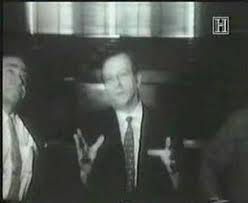
Ruby: Everything pertaining to what's happening has never come to the surface. The world will never know the true facts, of what occurred, my motives. The people had, that had so much to gain and had such an ulterior motive for putting me in the position I'm in, will never let the true facts come above board to the world.
Reporter: Are these people in very high positions, Jack?
Ruby: Yes
As for other conspirators mentioned by Giancana’s account in “Double Cross”, Chuck Nicoletti was shot dead in a restaurant parking lot in 1977 by three slugs to the back of the head. Nicoletti was due to appear before the House Select Committee on Assassinations at the time of his death. Richard Cain, still working with Giancana as a bagman carrying money from Iranian and Latin America casino skims, was killed in a Chicago sandwich shop by four masked gunmen in 1973.
‘Milwaukee Phil’ Felix Alderisio served as head of the Outfit for a short while, but was eventually sent to prison where he died in 1971 of natural causes at the age of 59 (a lot of people dying young here). Unlike Giancana’s funeral, Tony Accardo and other mobsters attended this one.
Guy Banister died of a heart attack in 1964 at the age of 64 (okay, at least not 59) just before the Warren Commission was wrapping up their investigation and were planning to ask Bannister about the following topics: "CIA", "Ammunition and Arms", "Civil rights program of JFK", "Fair Play for Cuba Committee" and "The International Trade Mart".
Banister's files went missing after his death
Lee Harvey Oswald stamped an address on leaflets he was handing out in New Orleans for a pro-communist ‘Fair Play for Cuba Committee’ group.
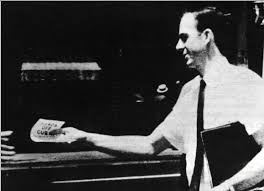
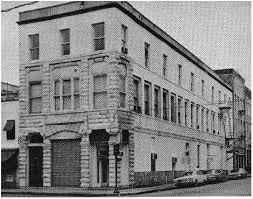
The address on these leaflets led to a corner building and also located in this corner building was Guy Banister’s private investigation firm. Although two different addresses, they were located at the same building since the building was on a street corner. New Orleans Assistant District Attorney Andrew Sciambra interviewed Banister's widow. She told him that she saw some Fair Play for Cuba leaflets in Banister's office when she went there after his death.

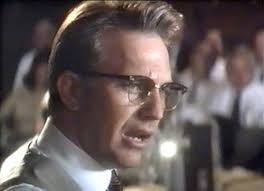
The address on these leaflets led to a corner building and also located in this corner building was Guy Banister’s private investigation firm. Although two different addresses, they were located at the same building since the building was on a street corner. New Orleans Assistant District Attorney Andrew Sciambra interviewed Banister's widow. She told him that she saw some Fair Play for Cuba leaflets in Banister's office when she went there after his death.
This Banister-Oswald connection became an early lead in New Orleans District Attorney Jim Garrison’s trial against Clay Shaw in the murder of JFK, as made famous by Oliver Stone’s 1991 film “JFK”, which will be discussed later.

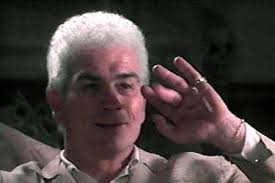
David Ferrie was also targeted by Jim Garrison as part of the plot after a rumor spread that Ferrie’s library card was found in Oswald's wallet the day he was arrested in Dallas on November 22, 1963. No such item was found on Oswald by Dallas PD and Ferrie was able to produce his library card for FBI agents who interviewed him on November 27, 1963.
On February 22, 1967, less than a week after the New Orleans States-Item broke the story of Garrison's investigation, Ferrie was found dead in his apartment. The New Orleans coroner officially reported that the cause of death was an intracranial berry aneurysm. Although two suicide notes were found in the apartment.
After Frank Sheeran spills the beans to his mafia boss friend Russell Bufalino that Hoffa was willing to talk about the JFK plot if he didn’t get what he wanted from the mob, Bufalino sent Sheeran back to kill his long-time Teamster buddy. Sheeran, along with a few other men, including Hoffa’s ‘adopted son’ Chuckie O’Brien, picked up Hoffa from the Red Fox diner in the suburbs outside of Detroit and took him to a house where he thought he was meeting mobsters Russell Bufalino, Tony Provenzano, and Tony Giacalone. This took place on July 30, 1975, about a month after Sam Giancana was murdered.
According to Sheeran’s account, once they entered the house he shot Hoffa in the head. Linoleum had been placed inside the house to cover any blood splatters. Although he doesn’t know for sure, Sheeran believes Hoffa’s body was taken to a local funeral home the Detroit crime family used to cremate problems.
Sheeran himself died in a nursing home in 2003 at the age of 83. He also gave the same story of his role in Hoffa’s death to a FOX news reporter.
The car Chuckie O’Brien allegedly drove Hoffa to his death in did later show up with a hair sample of Hoffa’s based on FBI analysis. O’Brien had always denied involvement, in fact before the paternity test craze; he went on The Maury Povich Show and passed a lie detector test.
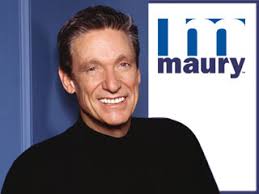
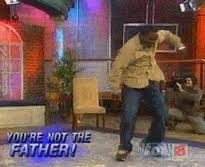
Hoffa’s family as well as law enforcement agencies are still convinced O’Brien isn’t completely innocent.
Hoffa’s family as well as law enforcement agencies are still convinced O’Brien isn’t completely innocent.
Sheeran claimed O’Brien isn’t at fault as he was used by the team to help lure Hoffa, who would have his guard down after seeing O’Brien and his long-time friend Sheeran in the car.
Joseph Milteer, the right-wing lover of all races, who was recorded on a wiretap in Miami days before the assassination with knowledge of a working plot to kill JFK, he died in a house fire in 1974 (maybe he had a cross in the basement or just knew too much about JFK and/or MLK’s demise).
As for LBJ’s supposed mistress Madeleine Duncan Brown, her account of a party the night before the assassination at Clint Murchison’s house has been attacked left and right. First of all, long time homecare workers for Murchison claimed he had a stroke by 1958-59, therefore was in no condition to be hosting lavish late-night cocktail parties by 1963 (or then possibly planning assassinations).
JFK conspiracy enthusiast and current curator of the 6th Floor Museum in the Texas School book Depository, Gary Mack, looked into her story found that there was no way Lyndon Johnson and Richard Nixon could’ve been able to attend the party around the time Brown said they were all there, about 11pm:
“Could LBJ have been at a Murchison party? No. LBJ was seen and photographed in the Houston Coliseum with JFK at a dinner and speech. They flew out around 10pm and arrived at Carswell (Air Force Base in northwest Fort Worth) at 11:07 Thursday night. Their motorcade to the Hotel Texas arrived about 11:50 and LBJ was again photographed. He stayed in the Will Rogers suite on the 13th floor and Manchester (William Manchester - author of The Death of a President) says he was up late. Could Nixon have been at Murchison’s party? No. Tony Zoppi (Entertainment Editor of The Dallas Morning News) and Don Safran (Entertainment Editor of the Dallas Times Herald) saw Nixon at the Empire Room at the Statler-Hilton. He walked in with Joan Crawford (Movie actress). Robert Clary (of Hogan’s Heroes fame) stopped his show to point them out, saying “. . . either you like him or you don’t.” Zoppi thought that was in poor taste, but Safran said Nixon laughed. Zoppi’s deadline was 11pm, so he stayed until 10:30 or 10:45 and Nixon was still there.”
Gary Mack also pointed out that Hoover as the FBI Director, would’ve had his own secured driver and not relied on some family’s chauffer pick him up. Although if Hoover attended a secret meeting like this it makes sense not to use official FBI employees to witness it.
Can anybody confirm anything about Brown’s tall tale?
Back to Barr McClellan, he stated that Madeleine Brown received regular payments from Johnson via Brazos-Tenth, his money-laundering corporation.
She worked in the advertising business for a company called Glenn Advertising, and in addition to the story of the Murchison party, she also claimed one time her and her advertising colleagues visited Jack Ruby’s Carousel Club and Jack was in there saying Oswald had been in the club bragging he just took a shot at Major General Edwin Walker (an act the Warren Commission says he committed).
In 1988, Brown was charged with forgery of someone’s will.
Once Brown found out Gary Mack was looking to dissect her story, she appeared on the TV show “A Current Affair” in the early 1990’s to give her account. Her son Steven sued the Johnson Estate (Ladybird Johnson) in 1987 for monies he felt owed to him as LBJ’s illegitimate son, but he eventually dropped the lawsuit and died three years later on cancer at the age of 40. According to Brown, breaking her silence on national television was her way at getting back at the Johnson Estate as well as grief over her son’s death. She also appeared on TMWKK series and (of course) got a book deal for the 1997 release of “Texas in the Morning”.
She died in 2002.
A few years after leaving the office of the President, LBJ taped a three hour TV interview.
When the show aired on May 2, 1970, a portion of the interview was not broadcasted and the TV show explained it was at the request of LBJ. What was discussed during that ‘blacked out’ segment is unknown (JFK assassination maybe?).
Part Three: The Warren Commission
It Should Give Allen Something To Do
Since so far most of this has been based on accounts of people who say JFK’s assassination was a conspiracy, perhaps it’s time to give voice to the US Government’s original report that Lee Harvey Oswald acted alone and fired three shots from the Texas School Book Depository. Then two days later, Jack Ruby killed Oswald out of a fit of rage of his crime of killing the nation’s leader.
(Naturally I’ll still find room to squeeze in snide remarks)
Although the mainstream story in the media was that Oswald acted alone and fired three shots from the TSBD, the growing number of different witness accounts and stories being spread put LBJ in a position to from the group a week after the assassination to get a definitive answer on what happened. The group was formed and called the Warren Commission after its chairman Chief Justice Earl Warren. Other notable members are Allen Dulles, the former CIA Director JFK forced to resign after the Bay of Pigs incident, and Gerald Ford, who would become President of the United States after Nixon resigned from office in 1974 due to the Watergate scandal.
The commission hearings were not in secret. Witnesses testified in private in front of the commission, but they did have the right for an open hearing if they chose so (only one witness selected an open hearing). Witnesses were also allowed to publically share their accounts of what they discussed after they testified. About a year later in September of 1964 the commission provided its findings to LBJ with an 888-page report.
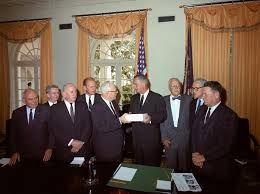
Two months later the Commission published twenty-six volumes of supporting documents, including the testimony or depositions of 552 witnesses and more than 3,100 exhibits.
Two months later the Commission published twenty-six volumes of supporting documents, including the testimony or depositions of 552 witnesses and more than 3,100 exhibits.
It Appears Something Has Happened In The Motorcade
From Dallas’ Love Field Airport the President’s motorcade was supposed to pass through the streets of downtown Dallas and make its way to the International Trade Mart (owned by Jim Garrison’s suspected guilty CIA agent Clay Shaw) for a 12:30 pm lunch.
The motorcade was running behind schedule and we actually at the TSBD by 12:30pm and almost on the Stemmons Freeway. The Secret Service radioed ahead to the Trade Mart that that the President will be there in five minutes. Seconds later, shots rang out (was “the President will be there in five minutes” the go-code for the shooters to proceed?)
One shot the back of Kennedy’s neck, just right of his spine, and exited out the front of his neck which caused damage to his necktie. At this time, Governor Connally, who was seated in front of the President with his wife Mrs. Connally, had his body turned to the right so he could face the crowd. As he motioned leftward, the bullet that exited out of Kennedy’s neck entered below Connally’s right armpit, where he felt a blow to his back.
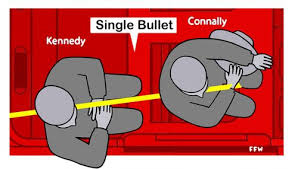
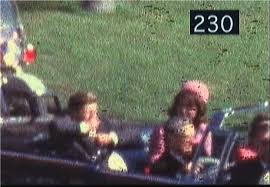
The bullet went through a portion of his chest and exited out below his right nipple, then proceeded to go through his right wrist, which was in his lap, and finally ended up as a wound in his left thigh.
The bullet went through a portion of his chest and exited out below his right nipple, then proceeded to go through his right wrist, which was in his lap, and finally ended up as a wound in his left thigh.
This of course was known as the “magic bullet” or “single bullet” theory.
Instead of being the bullet being lodged in his left thigh where the report says it ended up, someone just happened to find it lying on Connally’s stretcher at Parkland Hospital where he was taken for surgery on his wounds, because bullets just fall out of people that easily. From the good condition of this well-travelled bullet, it didn’t look like it has just passed through the skin and bones of two different people.
A second issue with this theory is the Zupruda film shows Connally’s right hand upwards and not in his lap the time the report says the bullet passed through his right wrist and entered the left thigh. In addition, Connally’s right wrist is depicted holding a pen, which might be tough if a bullet just shattered bones in that very same wrist.
Mrs. Connally pulled her husband into her lap and as Kennedy was hunched over in his seat, another shot entered the rear portion of his head and caused a massive head wound. Kennedy then feel towards the left into his wife’s lap who was riding to the left of him.
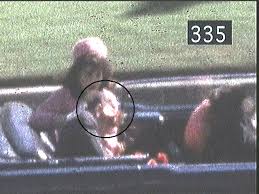
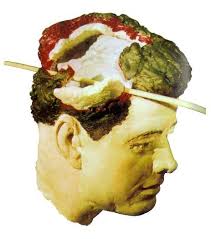
The Warren Commission doesn’t definitively say there were three shots, but only came to that conclusion when three empty cartridges were found on the 6th floor of the TSBD. The report mentions a range of possibilities just as only two real shots and one blank, three shots, only two shots, and just gives reference that some eyewitnesses claimed hearing four or more shots, but that they must have heard echoes (silly witnesses). Since three empty shell cases were found on the same floor as the rifle, the report concludes three shots fired, two hits (including the magic bullet), one miss, all coming from the 6th floor window of the TSBD.
The report names a few people who saw the actual shooting.
Howard L. Brennan noticed a man standing at the window before the motorcade showed up and listed him at 5’10’’ (Oswald was measured at 5’9’’ at his autopsy, but that’s a small manner to be picky about). Then later saw him with the rifle out the window aimed at the motorcade.
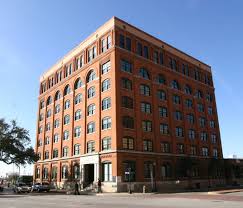
Amos Lee Euins, a 15-year-old ninth grade student, stated that he was facing the Depository as the motorcade turned the corner at Elm and Houston. He recalled:
“Then I was standing here, and as the motorcade turned the corner, I was facing, looking dead at the building. And so I seen this pipe thing sticking out the window. I wasn't paying too much attention to it. Then when the first shot was fired, I started looking around, thinking it was a backfire. Everybody else started looking around. Then I looked up at the window, and he shot again.”
Euins has stayed out of the media in the years since 1963 and just recently appeared on a show on the National Geographic Channel about the assassination to give this same story.
Both JFK and Connally, in the same limo, were taken to Parkland Hospital about 4 miles away. Doctors working on JFK reported irregular breathing, a possible heartbeat, but no pulse. A tracheotomy on his neck wound was performed in an effort to save his life, but eventually there was no heartbeat anymore and he was declared dead.
As the shooting happened at Dealey Plaza, Dallas PD Motorcycle Patrolman Marrion L. Baker heard rifle shot from the TSBD and noticed the pigeons scattering away from the building. He raced into the TSBD where we met up with the building’s superintendent Roy Truly. Both of the elevators were on upper floors, so Baker and Truly used the stairs to go up. They both encounter Oswald in the 2nd floor break room with a soda in his hand, and Officer Baker timed this at about 2 minutes after he heard the rifle shots. After Truly confirmed to Baker that Oswald was an employee, the two moved on up the stairs to the next floors. (So in less than two minutes, Oswald is believed to have fired three shots at the President of the United States, ditched the gun on the other side of the 6th floor of the building, went down four floors of stairs without anyone seeing him, got himself a soda, and looked calm enough for Baker and Truly to move on after seeing him…okay….)
1 minute later Oswald was seen passing through the 2nd floor offices on his way to the 1st floor exit. 7 minutes later Oswald boards a bus 7 blocks away around 12:40pm. One of Oswald’s former landlady’s, Mrs. Mary Bledsoe, sees Oswald on the bus. About 3-4 minutes later the bus is jammed in traffic caused by the shooting, that Oswald gets off and takes a cab to his boarding house, owned by Mrs. Earlene Roberts, about 1pm.
At 12:54pm a description of the President’s shooter went out as a white man, about 30 years old, slender, and at 5’10’’.
At approximately 1:15pm Dallas PD Officer James Tippit stops Oswald as he is strolling on the sidewalk since he closely matches the description. As Tippit exits the police car, Oswald shoots him with a revolver he had in his possession. Domingo Benavides, an automobile repairman, heard the shots, saw Tippit down and a man emptying his shells. When Oswald left the scene, Benavides called the police with Tippit’s radio which was logged at 1:16pm.
Barbara Jeanette Davis and her sister-in-law Virginia Davis heard the shots and saw the Oswald crossing their lawn and shaking a revolver as if he were emptying it of cartridge cases. Later each woman found a cartridge case near the scene and submitted them to police (Oswald is going to leave evidence of murdering a cop on someone’s front lawn? Why not pocket them and put them in the trash later on?).
Taxicab driver William W. Scoggins saw the Tippit shooting as his cab was parked on a side street. He said Oswald was muttering something to the extent of “poor damn cop” or “poor dumb cop”.
Johnny Calvin Brewer heard sirens and radio report of police shooting as he was in his shoe store. Saw Oswald in front of his store and felt he looked suspicious enough to follow. (Oswald may not have looked suspicious to Officer Baker back at the TSBD, but no way is he going to fool a shoe salesman). He observed Oswald enter the Texas Theater without paying for a ticket, so he informed theater worker Mrs. Julia Portal who called the cops. The police emerged onto the theater by 1:45pm and Oswald was in custody at the police station roughly about 2pm.
Around 1pm at the TSBD, investigators started to inspect the 6th floor and they discovered the three empty shells as well as a stack of boxes positioned as a sniper’s nest near the window looking out where the motorcade passed by. By 1:22pm the rifle was discovered on the other side of the floor (Funny how Oswald made an effort to hide the rifle, but, like the Tippit murder, he didn’t bother picking up the empty shells on the floor next to him which he could’ve walked out of the TSBD with).


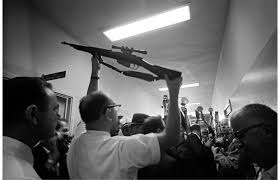
Superintendent Roy Truly mentioned Oswald was the only one of fifteen employees working that day not currently accounted for. Policemen returned to the station around 2pm to begin their search for Oswald, but he was already in custody from the theater incident.
Troubled Boy
The Warren Report provided a background on Lee Harvey Oswald and here are some of the highlights besides being a troubled youth who performed poorly in school:
He entered Russia in 1959 on a 6-day visa and slashed his wrist when he was ordered to leave. Finally, the Russian authorities let him stay on a year-by-year basis. By 1961 he met his wife Marina and they were both allowed to leave the country together for the US in 1962.
The FBI questioned him twice regarding his tenure in Russia.
April of 1963 Oswald attempts to kill Retired Maj. General Edwin A. Walker (right-winger) at his home, but fails (So he can pick off a President in the middle of a parade but can’t hit some retired General at his home?). Marina finds a note in Oswald’s study for her of what to do in case he was caught, and knowing what he tried to do, suggest he go look for work. Oswald leaves for New Orleans on April 24, 1963 while Marina stayed in Irving, TX and lived with a friend, Ruth Paine.
In September of 1963 Oswald travels to Mexico by bus to visit the Cuban and Russian embassies in hopes to go through Cuba to Russia, but is denied. After a string of low-wage jobs, in October Oswald returns to the Dallas area and stays at the house of Mrs. Mary Bledsoe while his wife Marina remained at the Paine house. A neighbor of Ruth Paine’s, Buell Wesley Frazier, who worked at the TSBD informed her of a job opening at the place and was able to get the job for Oswald. Later on, Oswald moved into another boarding house owned by Mrs. Earlene Roberts.
The Curtain Rods
The day before the assassination, Thursday November 21, 1963, Frazier drove Oswald to Paine’s house as he claimed he needed to pick up curtain rods. This was strange to everyone as Oswald would only come on the weekends to Paine’s house to visit Marina and his two kids. He spent the night there.
The morning of the assassination, Friday November 22, 1963, Frazier was set to drive Oswald to the TSBD and mentioned he was running late. Oswald left behind his wedding ring and his wallet with $170 inside and entered Frazier’s vehicle with a long package wrapped in paper. Oswald told Frazier the package was curtain rods and Frazier witnessed Oswald enter the TSBD with it.
When Marina heard about the shooting of JFK on TV and with the TSBD being mentioned and knowing her husband tried to shoot Retired General Walker months earlier, she went into the garage where she knew Oswald kept his rifle wrapped in a blanket. She noticed the blanket was still there, so paid no further mind to it. At 3pm, the cops arrived at Paine’s house in which Marina led them to the blanket in the garage. When they unwrapped the blanket there was no rifle.
At the police station, Oswald was in possession of another wallet that contained a Selective Service card with his picture and the name Alek J. Hidell (FBI agent James Hosty later stated this "Oswald wallet" was found a Officer Tippit's murder scene, but Warren Commission said Oswald was arrested with it at the Texas Theater). Police said he was allowed to make calls for an attorney and rejected legal assistance from the Dallas Bar Association. By the morning of Oswald’s death, he still hadn’t secured a lawyer. Of course if he turned down the Dallas Bar Association, then why at one of his press conferences at the Dallas police station was making a statement to reporters that he needed someone to step forward and provide him legal assistance?
Ruth Paine in TMWKK series confirmed Oswald called her house while he was in police custody, asking to speak to Marina and trying to get her to help him find an attorney.
At 7:10pm on November 22nd Oswald was charged in the killing of Officer Tippit. Hours later, at 1:30am of November 23rd he was charged with the killing of President John F. Kennedy.

The Warren Report also tracked down how Oswald obtained the rifle. It was paid by a money order in the name of A. Hidell in March of 1963 and shipped to a PO Box in Dallas rented by Oswald (when he could’ve entered a gun store in Texas and paid in cash for a rifle that wouldn’t be traced so easily back to his name).
Between 2:30am to 3:00am on Sunday November 24, 1963 the FBI and County Sherriff offices received phone calls threatening Oswald’s life. Originally Oswald was supposed to have been transferred from the police station to the county jail in an armored car, but plans were changed to use an unmarked police car which would be more agile in case they needed to flee the scene.
Before Oswald was taken into the unmarked car in the police station basement, Jack Ruby spurred out of the crowd and shot him dead.
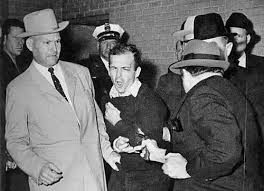
Here’s some of the report’s findings on Ruby:
Based on its evaluation of the record, however, the Commission believes that the evidence does not establish a significant link between Ruby and organized crime
Ruby's unusual generosity may be explained in part by his extremely emotional reaction to persons in distress, which may have resulted from his firsthand familiarity with poverty, and by his unusual craving to be recognized and relied upon. Many of Ruby's acquaintances described him as a "publicity hound," "glad hander," and "name dropper," one always seeking to be the center of attention. Apparently the "egocentrism" of his youth never left Ruby. Yet, frequently he sought reassurance from persons he admired.
Cause damn it!! A strip club owner is not going to sit idly by and let the killer of the President walk away unpunished!!
Part Three: The Warren Commission – The Results
The report also states Oswald’s fingerprint and palm prints were found on a paper bag and on boxes near the sniper nest of the 6th floor of the TSBD. (Although no prints were found during the first three days law enforcement officials dusted for it) Oswald’s palm print was also discovered on the 6.5 mm Carcano Model 91/38 rifle found on the 6th floor that Oswald did the shooting with.
A search of Oswald’s possessions by Dallas PD officer Gus Rose uncovered a photograph taken in 1962 of Oswald holding the same carcano rifle and a revolver that his wife Marina testified was taken a week before his attempt on Retired General Walker’s life. Marina also testified against Oswald regarding the note he left for her in regards to that assassination attempt that failed. Both Ruth Paine and her husband Michael told the commission they had no knowledge Oswald kept a rifle in their garage.
Interrogators mentioned in Episode 5 of TMWKK that when they showed Oswald this photo after he originally stated he didn’t own any guns (although was in possession with one at the Texas Theater), he became visibly upset and said the picture was his head super-imposed on someone else’s body (the photograph has become a popular topic of discussion for conspiracy theorists as the chin marks looked cropped and there’s inconsistencies with the shadows made from the sun on the head versus the rest of the body).

Marina did confirm in a 2009 interview with former Minnesota Governor Jesse Ventura for his TruTV show “Conspiracy Theory with Jesse Ventura” that she took the pictures, but at Oswald’s insistence (“Conspiracy Theory with Jesse Ventura”, which is owned by Turner Broadcasting, is a rare program on television for the fact that has gone against the popular stance on JFK’s assassination).
Marina did confirm in a 2009 interview with former Minnesota Governor Jesse Ventura for his TruTV show “Conspiracy Theory with Jesse Ventura” that she took the pictures, but at Oswald’s insistence (“Conspiracy Theory with Jesse Ventura”, which is owned by Turner Broadcasting, is a rare program on television for the fact that has gone against the popular stance on JFK’s assassination).
Although Marina painted a dark picture of Oswald in the Warren Report and did alot to seal the deal for the Government’s case in 1964, when she was in her early twenties, a scared immigrant window with two kids in a brand new country that could easily be intimidated, by 1995 she completely changed her tune. In episode 6 of TMWKK she believes Oswald is innocent of the murders of both Tippit and JFK and stated she was lied to and the public has been lied to. She also feels that her husband died a hero.
Huh?
Oswald’s mother, Marguerite, who one would think would want to bury her head in the sand after her son was accused of killing the President, gave this surprising statement at Oswald’s funeral:
"Lee Harvey Oswald, my son, even after his death, has done more for his country than any other living human being."
Double-Huh?
What heroic action could have he taken? Assuming the role of a patsy so they country wouldn’t tear itself apart from finding out its own government killed its leader?
Anyways, back to the magic bullet.
The crucial scene of Oliver Stone’s 1991 film “JFK” that screamed conspiracy is when Jim Garrison points out the ridiculousness of how this bullet could pass through two people, makes all these wounds, zig-zag, and at one point even pause in mid-air before changing directions on its own. Those revelations would lead to believe there must have been another shooter causes some of these wounds.
The mainstream media was quick to shoot that down by 1993. A computer animator named Dale Myers embarked on a 10-year project to completely render the events of November 22 in 3D computer animation. His results were shown as part of ABC's documentary The Kennedy Assassination: Beyond Conspiracy in 2003, and won an Emmy award. This network TV piece revealed that the President’s limo was designed for the backseat to be raised higher than the front. In addition, since JFK was sitting more inward than Connally, bullets coming front the upper-left diagonal direction of where the sniper window at the TSBD was would’ve been able to cause the wounds the Warren Report stated without any funky zig-zags or mid-air pauses.
Then someone tripped up.
Gerald Ford, the former President of the United States who was on the Warren Commission and worked with future Senator Arlen Specter on the magic bullet theory, admitted to the Associated Press in a 1997 interview that he purposely raised the entrance wound the report had from JFK’s back to the back of his neck in order to make the magic bullet theory fit.
Triple-Huh?
One of the key members of the Warren Commission admittedly forged an important ballistic detail of JFK’s wounds, which is kind of a very big story, but the mainstream media decided to stay away from that scoop. Same way they didn’t advertise the results of a 1999 wrongful death suit Martin Luther King’s family brought to a Tennessee court in which a jury declared MLK was assassinated by a conspiracy (that included government agencies).
By Ford revealing this, that means the other wounds found on JFK and Connally would have been caused by one or more shooters instead of just some lone nut. What this also means then is that the front neck wound of Kennedy, which Kennedy is visibly seen grabbing his throat in the Zapruder film, was a frontal entrance wound and not an exit wound. That places (at least) one shooter in front of Kennedy which is the opposite side of the TSBD where the report claimed Oswald was shooting from.
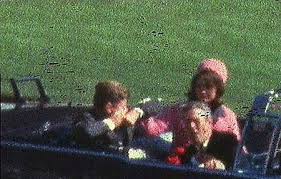
Can they take the Emmy back?
Then lastly, there is the explosive headshot to Kennedy’s head which ended any chance of him getting out of Dealey Plaza alive. This ‘back and to left’ motion Kennedy’s head took was the second main piece of proof in Oliver Stone’s 1991 film “JFK” that there was another shooter, positions to the front and right of the motorcade, which would’ve been the grassy knoll. Before the stunning visual image of Kennedy’s brains splattering out of his head, in slow motion reply there’s a white cloud of dust that's ricocheting off of the front right temple of Kennedy’s head, similar to what it would look like firing a bullet against a concrete wall, which would also coincide with a shot coming from the front right side of the motorcade.
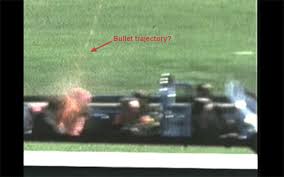
The nastiness of the head would looked to have been caused by someone closer to the vehicle, let’s say the grassy knoll, and done with something powerful like the exploding missile bullets Lucien Sarti had a reputation of using, and not from the 6th floor of a building nearly a hundred yards away with a rusty World War II era rifle that had a misaligned scope.
The nastiness of the head would looked to have been caused by someone closer to the vehicle, let’s say the grassy knoll, and done with something powerful like the exploding missile bullets Lucien Sarti had a reputation of using, and not from the 6th floor of a building nearly a hundred yards away with a rusty World War II era rifle that had a misaligned scope.
In the usual fashion of the mainstream media (minus Jesse Ventura’s “Conspiracy Theory”) continued support of the Warren Report, the Discovery channel’s (they‘re not gonna rock any boats) show “MythBusters” recently ran a test using the most powering rifle in the world to date, and their findings revealed that the kinetic energy from a bullet is not strong enough to dictate the movement of a person who is hit by it. In that case then, JFK’s head going back and to the left was nothing more than a neuromuscular reaction. Okay, but if someone punches me in the front right part of my head, I think my head will end up back and to the left. Does that also mean Abraham Lincoln could’ve fallen back out of his chair when Booth shot him in the back of the head? That would’ve looked pretty ridiculous.
Woooooah Nellie.
In November 1998, Nellie Connally, the wife of Governor Connally who was also wounded during the assassination, as the remaining person alive at the time from the occupants in that limo told the magazine “Newsweek” that, “I do know what happened in that car.” Her claim is that the Warren Commission’s finding that one bullet made all those wounds to both Kennedy and her husband is wrong. She states the first shot hit Kennedy, the second shot hit her husband, and then the third shot was the head wound to Kennedy. Nellie also recalled what Jackie Kennedy said during the incident, “Jack! Jack! They’ve killed my husband. I have his brains in my hand.”
During an interview on episode 1 of TMWKK series John Connally recalled what he said while the shots rang out and his statement was, “My God, they are going to kill us all!” Senator Ralph Yarborough, who was riding behind in a different limo with LBJ, also mentioned during this same episode what Jackie Kennedy was saying at Parkland Hospital while she was reflecting on what just occurred, “They murdered my husband, they murdered my husband.”
Seems like the word “they” was been used a lot during the shooting, which would indicate Jackie Kennedy and John Connally felt bullets were coming in from more than one direction. Or was it just a natural reaction to thinking that no one man could shoot the President, so there must be others involved?
Returning to the bullet wounds of Kennedy and Connally; the National Archives houses the photos taken of the clothes Kennedy wore while he was shot at and there is a clear bullet hole in the upper portion of the back.

The popular reason for saying the bullet entered the back of his head what that Kennedy’s jacket was crumbled upwards from waiving to the crowd during the parade. Taking into account what Ford admitted in 1997 that he falsified that portion of the report, that leaves the back wound from the hole in the jacket, the throat wound as we see Kennedy react in the Zupruder film as well as what Parkland Hospital doctors witnessed when his body was brought in, and then the fatal head shot which is very clear. That’s a total of three shots and three bullets. Connally was hit with at least one bullet himself for his wounds (right armpit-chest-below right nipple-right wrist-left thigh), so that adds another shot and bullet for four in total at this point (although if his right wrist wasn’t located near his left thigh when this bullet was supposed to pass through him, that would be yet another shot which would make it five in total, but let’s keep it four for now).
The popular reason for saying the bullet entered the back of his head what that Kennedy’s jacket was crumbled upwards from waiving to the crowd during the parade. Taking into account what Ford admitted in 1997 that he falsified that portion of the report, that leaves the back wound from the hole in the jacket, the throat wound as we see Kennedy react in the Zupruder film as well as what Parkland Hospital doctors witnessed when his body was brought in, and then the fatal head shot which is very clear. That’s a total of three shots and three bullets. Connally was hit with at least one bullet himself for his wounds (right armpit-chest-below right nipple-right wrist-left thigh), so that adds another shot and bullet for four in total at this point (although if his right wrist wasn’t located near his left thigh when this bullet was supposed to pass through him, that would be yet another shot which would make it five in total, but let’s keep it four for now).
Anymore?
James Tague was watching the parade from near the triple bypass railroad bright when he recalled hearing three shots. As he ducked for cover under the bypass he felt a stinging sensation on his face. When the shooting was over and he came out of hiding, Dallas sheriff detective, Buddy Walthers, saw blood on Tague’s right cheek and asked him where he was standing when the shooting started. The two inspected the area and came upon a curb on Main Street some twenty feet away from where Tague was standing that had a fresh scar mark against it as if it had just been hit by a bullet. They came to the conclusion that one bullet ricocheted off the curb and the debris hit Tague. This curb surrounding the scar chip was removed and replaced a day after the assassination and is now in the National Archives. Later, forensic tests by the FBI revealed that the chipped bullet mark impact location did not have any copper metal residue embedded in it, which would’ve left a trace had bullets from the 6.5mm gun Oswald supposedly used from the TSBD where the empty cases were found (or planted). The result of that is either it wasn’t a bullet mark, or a different bullet from a different gun did the damage. The curb mark was then patched up in which the FBI claimed must have been caused by a street-sweeper vehicle.
On his testimony to the Warren Commission Tague said he felt the shots originated from the monument area of the grassy knoll, which is left of the picket fence and a few hundred feet away from the TSBD. He also felt that it was the first shot that led to the wound on his cheek. By August 1964 the FBI literally jackhammered the section of curb out from the street and took it away so they could run a spectragraphic test on it that would determine perhaps where the bullet came from. Former Senate investigator Harry Weisberg asked to examine this spectragraphic plate later on and was told the tiny plate was destroyed essentially to save space in the FBI’s D.C. office (because enough room for files on who Sinatra was sleeping with is more important). Weisberg also examined the photo of the curb mark taken one day after the assassination and compared it to the photo on record at the National Archives and noticed the one on file at the Archives is patched-up. In 1997, James Tague visited the U.S. National Archives and personally examined the curbstone scar chip. Tague was also accompanied by a U.S. National Archivist. They both immediately agreed that the scar chip was covered up with a foreign-material patch over the scar chip (no documented record nor documented authorization exists of precisely who or what agency had the scar chip within its evidence chain, nor when the scar chip was covered up).
Unless a mosquito travelling at the speed of light cause the mark on Tague’s cheek, it means that’s another bullet was fired. The Warren Commission concluded three shots were fired in the span of about six seconds. There’s the fudge job by Gerald Ford for shot one in the back, and in relation to that the neck wound to Kennedy’s front for shot number two, the wounds of Connally for shot number three, the big head wound of Kennedy for shot four, and now the curbside misfire shot that injured Tague for shot number five.
Is that it?
Not really.
Dr. Evalea Glanges was a second-year student at Southwestern Medical University in Dallas and was present in the crowd at Parkland Hospital when the Secret Service arrived with JFK’s limo to get medical attention for the fatally wounded President. She shares her account of her experience at Parkland that day on episode 7 of TMWKK. As she walked up to the limo she clearly identified a bullet hole in the front windshield near the mirror. The Warren Report stats there were bullet fragmentation damage to the limo, including to the spot near the front windshield mirror, but that there was no glass penetration. Dr. Glanges claimed she saw a hole in the window, the Warren Report says no hole. As a crowd of onlookers grew gathered near the vehicle, a secret service member got in and drove it away.
Just as the Secret Service did with the President’s body, which will be discussed later, the limo wasn’t inspected by Dallas PD, as it should have by law, but was instead flown to Washington DC.
Charles Taylor, Jr. drove the limo from Andrews Airforce Base to the White House garage and on his report noted a hole in the left center part of the front windshield, and also noted it appeared bullet fragments had been removed. US Police Park Officer Nick Prencipe noted in his report of a hole in the same windshield, and his years of police work concluded it was from a bullet.
The garage kept a log of people who would enter and make comments on JFK’s limo, but an interesting thing happened towards the later part of November 24th and all of November 25th, nobody logged in any notes.
Does that mean no one wanted to see the cool limo anymore or was the limo not in the garage during that time span?
Taking the position it wasn’t in the garage, where did it go?
George Whittaker gives his account of the limo during episode 7 of TMWKK series. Whittaker was a lifetime worker at Ford Motor Company with 30 years of employment with them. His department at the Rouge, Michigan plant was in charge of laminating glass. On November 25th he saw the President’s limo at the plant with the interior stripped and the front windshield missing. When he inquired what was going on he saw workers holding up the window, which he said he saw a bullet hole in it, and found out their job was to copy the windshield’s dimensions and build a new one. The original windshield which had the bullet hole was destroyed afterwards. George Whittaker died in 2001. If Whittaker was dedicated to work for Ford for thirty years, it doesn’t make sense for him to create fairy-tales that could bring shame to the company.
If this Whittaker account is accurate, then the only reason to take out the window as well as the interior was that it contained evidence of multiple shooters. With the front window having a bullet hole, that adds to the tally (Kennedy back, Kennedy front neck, Kennedy head, Connally chest, Tague cheek, limo front window) of six shots fired at the limo.
(To combat the Whittaker tale, in his autobiography "Assignment Oswald", FBI Agent James Hosty, the handler of the Oswald case before the assassination of JFK, said he saw this bullet-ridden front window present in the room where he went to give his testimony to the Warren Commission many months later. Either a FBI agent or a Ford Motors worker is making up stories.)
(To combat the Whittaker tale, in his autobiography "Assignment Oswald", FBI Agent James Hosty, the handler of the Oswald case before the assassination of JFK, said he saw this bullet-ridden front window present in the room where he went to give his testimony to the Warren Commission many months later. Either a FBI agent or a Ford Motors worker is making up stories.)
Someone who might have an idea of what happened in the limo? How about the Warren Commission testimony of Roy Kellerman, the secret Service agent who rode in the front passenger seat:
Kellerman: "I am going to say that I have, from the firecracker report and the two other shots that I know, those were three shots. But, if President Kennedy had from all reports four wounds, Governor Connally three, there have got to be more than three shots, gentlemen."
He further testified to the Warren Commission that after he remembered hearing the first audible muzzle blast or mechanically suppressed fired bullet bow shockwave, the assassination then ended in a "flurry of shells" coming into the limousine that reminded him of a jet sonic-boom sound quickness.
The Warren Report is saturated with witnesses claiming to have heard three shots coming from behind the motorcade and in direction of the TSBD. In fact, there were witnesses in the TSBD who were below the 6th floor heard shots from above them as they looked out the window at the parade passing by. If shots were coming in from multiple shooters and from multiple directions, why aren’t those accounts listed in the Warren Report?
Simple.
The Warren Commission was able to shape the narrative any way they pleased.
Take the Willis family for example.
The first part of their statement was that they heard shots from behind the President’s car, which was all the Warren Commission was interested in hearing. The little extra detail that was left out of the final report was the rest of their statement that they also saw the fatal head shot coming from the grassy knoll as well as the President’s head exploding, as they told cameras during episode 1 of TMWKK.
Then there’s Bill Newman (still alive shockingly) who was probably one of the closest witnesses to the limo as Kennedy was being shot at. During his FBI questioning he made a statement about hearing multiple shots from the monument area on the knoll (just left of the picket fence), where he was standing with his family. Newman served in the military and had familiarity with rifle shots, which would’ve made him an excellent witness since he was also only twelve feet away from seeing Kennedy’s fatal head shot.
Think he was allowed to testify in front of the Warren Commission and give this type of statement?
No Way!!
Then there is the case of Jean Hill who was some twenty feet away from the President’s limo during the shooting.
In her book, “The Last Dissenting Witness”, she claims the Warren Commission fabricated her testimony. She claims she saw smoke lingering from the grassy knoll after the shooting, something that isn’t in the report. What is in the report is that she saw a man running from the TSBD to the railroad tracks, and later identified that man as Jack Ruby when shown mug shots. Also what appears in the book is her claim a Secret Service agent informed her that another agent saw debris kicked up from the grass near her feet during the shooting, which then could up the tally to seven shots fired at the limo, but Hill has proven to be a less than reliable witness.
Later in life she claimed to have seen a shooter from the grassy knoll, but when interviewed by a radio station immediately after the assassination, she said she only heard shots from there (unless she said that only because she was scared of retaliation at the time). She said she received death threats and even had the brakes in her car tampered with after the assassination (would explain why many other people connected to the case died of car accidents). The problem with her Ruby story is other witnesses had him in the office of The Dallas Morning News during the shooting where he was taking out an ad for his nightclub. She was planning on a second book, but then died in 2000.
Since she could be easily proven wrong on the Ruby story, then everything else coming out of her mouth would seem absurd, so that and a little testimony fudging like Ford did with JFK’s neck wound, and anyone who goes against three shots from TSBD line looks like a crackpot.
Even in the shooting of Officer Tippit there’s some ambiguity.
Although there were plenty of witnesses in the report who had saw Oswald do the shooting and saw him walking away from the scene shortly thereafter, but there were still some inconsistency. Some witnesses had Oswald walking east on Tenth St., others had him walking west. Researcher Larry Harris also looked into witness testimonies and discovered there were differences in the descriptions and clothing given of Tippit’s killer.
Acquilla Clemons was sitting on her front porch and said there were two killers involved with Tippit’s shooting who walked off in different directions. Naturally she wasn’t asked to testify by the Warren Commission.
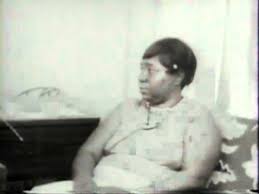
On police radio reports there were two references that the killer had an automatic weapon, even though Oswald was arrested with a revolver in his possession. Witnesses saw Oswald emptying shells on the grass after shooting Tippit, and the spent cartridges discovered did match up with the revolver he was arrested with, but the actual bullets taken out of Tippit’s body couldn’t be conclusively matched up with that gun. In addition, when Oswald was arrested at the Texas Theater, Officer Hill, who took possession of Oswald's revolver at his arrest, said the gun's six chambers were fully loaded with unspent cartridges and that Oswald had no other ammunition on him. Was Oswald a psychic who knew the exact amount of extra shells he needed to bring out with him that day, or did he not fire his revolver at Tippit at all?
For the witnesses who did finger Oswald as Tippit’s killer, how did they come to that conclusion?
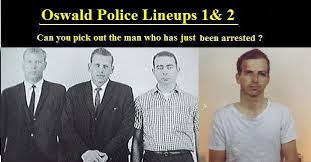
While Oswald was in police custody, he was placed in four different lineups with people who looked completely different than him. In fact, the final lineup included two teenagers and a Mexican gentleman.
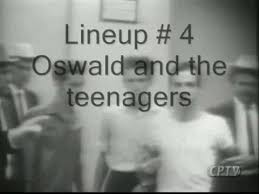
If the deck wasn’t stacked against Oswald enough, he was instructed to give his real name and that he worked at the TSBD, while the other lineup people gave fictitious names and occupations. Hours after the assassination, word had already spread from TV and radio reports about shots being fired from the TSBD, so when Oswald had to mention he worked there, witnesses were heavily influenced on whom to select.

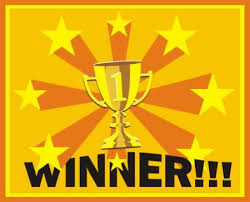
If the deck wasn’t stacked against Oswald enough, he was instructed to give his real name and that he worked at the TSBD, while the other lineup people gave fictitious names and occupations. Hours after the assassination, word had already spread from TV and radio reports about shots being fired from the TSBD, so when Oswald had to mention he worked there, witnesses were heavily influenced on whom to select.
As for the man who drove Oswald to the TSBD that morning with the ‘curtain rods’ package, Buell Wesley Frazier, initially police thought he was involved and pressured him to sign a confession, but he did not. Although he told the Warren Commission about the curtain rods Oswald claimed he was bringing into work today, there’s a slight problem with his story.
He described the way in which Oswald held the package that he cupped it with his hand on one end and had the other end of the package under his armpit. That particular carcano rifle Oswald has been tied to, when broken down is still about three feet in length. The 5’9” Oswald didn’t have the wingspan of a 7’0” basketball player and would not have been able to hold the three-foot package in that manner. Unless Oswald managed to find a way to disassemble the weapon further, he couldn’t have been holding it with his hand and armpit, or perhaps it was just a memory relapse on Frazier’s part.
A few notable mentions about Frazier is that he was the one who actually told Ruth Paine and the Oswalds about the job opening at the TSBD, plus one researcher pointed out he was friends with a man named John M. Crawford, who was an alleged associate of Jack Ruby’s. Frazier told the curtain rods story in episode 4 of TMWKK and recently provided a local television interview proclaiming his total innocence in the assassination.
Another witness for the Warren Commission, Jack Dougherty (surprised he was included), said Oswald entered the TSBD without any packages that morning.
Reporter and friend of Jack Ruby’s, Seth Kantor, in episode 3 of TMWKK said he told the Warren Commission he saw Ruby at Parkland Hospital moments after JFK was declared dead. In fact, he specifies a conversation in which Ruby asked his opinion on closing his nightclub due to the tragedy. The commission replied to Kantor that he must have been mistaken and the conversation took place at the police station, where Ruby was caught by news cameras correcting a reporter that Oswald was part of the ‘Fair Play for Cuba Committee’. If Ruby and Oswald didn’t know of each other previously as the Warren Report concluded, how would Ruby know such a random specific detail like that?
The Warren Report is still to this day considered the gold standard in terms of the facts surrounding the assassination, but years after its release in 1964 people kept questioning the results and there was a significant amount of the population not satisfied with the final conclusion that Oswald acted alone.
There was the 1969 Jim Garrison trial of Claw Shaw and his charge Shaw was the ‘Clay Bertrand’ person who called defense attorney Dean Andrews an asked him to represent Oswald while he was in police custody. The trial wasn’t as glamorous as depicted in the 1991 Oliver Stone film “JFK” and it took a jury less than an hour to find Clay Shaw not guilty. Although Garrison brought to light the relationships of Oswald-Bannister-Ferrie, he had a difficult time convincing the jury of Shaw’s link.
Stone’s film also ends with a credit that in 1979 CIA Director Richard Helms testified that Shaw had indeed worked for the CIA, but in reality it was a very loose relationship on the surface. As an international business man with many interests in Latin America, Shaw, along with thousands of other people, were debriefed by the CIA at certain periods of time regarding the on goings in those countries to provide any intelligence possible. That doesn’t actually make Shaw a full-fledged CIA employee as Stone’s film portrayed, but he was the one who ran the International Trade Mart that Kennedy was on his way to for lunch before he was killed. Shaw, as the owner, could’ve had prior knowledge of any security arrangements at the Trade Mart as well as maybe even the parade route. We’ll probably never know as Claw Shaw died in 1973 of cancer at the ripe old age of 61.
What the Garrison trial did do is spark more investigations into the assassination, there was the Clark Panel, the Rockefeller Report, the Church Committee, and the last real crack at it was the 1976 United States House Select Committee on Assassinations (HSCA).
The HSCA didn’t steer too far from the party line of the Warren Report, but was at least able to make a few dents into the siding. Both the CIA and FBI admitted they withheld evidence and obstructed investigations (Gerald Ford admitted something similar in the years before his death that the intelligence community wasn’t helpful with the Warren Commission), but they still weren’t helpful in the new investigation. Former two-term mayor of Beverly Hills, CA, Bob Tanenbaum resigned from the HSCA because he felt it was a complete waste of time since the CIA and FBI weren’t cooperating and were instead deleting documents. According to Tanenbaum, key witnesses weren’t being subpoenaed and held to telling the truth, as he mentioned in episode 6 of TMWKK.
The interesting twist to the HSCA’s conclusion was based on a motorcycle patrolman who had his hand down on his radio button while the assassination was taking place. This eight-second sound bite recorded by Dallas PD was put through an acoustic test in Dealey Plaza, and (shockingly) their test concluded there were four shots:
1st – From the TSBD
2nd – From the TSBD
3rd - From an area listed as ‘95% likely from the grassy knoll’
4th – From the TSBD
This allowed the HSCA to conclude that JFK was killed as part of a conspiracy. Perhaps this was the US Government’s way to toss the dogs a bone since so many witnesses and experts were refuting the Warren Report’s finding of three shots all from the TSBD. Of course, the FBI (oh, now they want to get involved) in 1982 ran their own version of this same acoustic test the HSCA performed and their conclusion was the HSCA was wrong in finding a 95% probability of a shot coming from the grassy knoll.
Although the HSCA found a conspiracy based on the notion of a second shooter, there has been no government-based movement to dig any further than that and the US Department of Justice officially closed the case of JFK’s murder in 1988.
There is a common misconception that President Nixon called the Warren Report a hoax on one of his White House tapes that were made public after the Watergate scandal. This is not the case and these are his actual words from a 1972 conversation about the shooting of Governor George Wallace:
NIXON: Why don't we play the game a bit smarter for a change. They pinned the assassination of Kennedy on the right wing, the Birchers. It was done by a Communist and it was the greatest hoax that has ever been perpetuated. And I respectfully suggest, can't we pin this on one of theirs?
Although Nixon’s words are confusing since the US Government stance is a lone communist fanatic did the shooting and it’s only a skeptic subculture who believe the right-wingers are responsible, nevertheless Nixon isn’t calling the Warren Report a hoax.
Another important fact worth mentioning is not all Warren Commission members were on the same page with the final conclusions. There were three dissenters: Senator Sherman Cooper, Senator Richard Russell, and Congressman Hale Boggs.
On a taped telephone conversation Senator Russell had with Lyndon B. Johnson about Oswald being the lone gunman, he is heard saying that "I don't believe it". Johnson responded with the words: "I don't either".
As Dallas journalist Jim Marrs pointed out, the most vocal critic among Commission members was Hale Boggs. Boggs became frustrated with the panel's total reliance on the FBI for information. Speaking of the single-bullet theory, Boggs once commented, “I had strong doubts about it.” On April 1, 1971, House Majority Leader Boggs delivered a blistering attack on FBI Director J. Edgar Hoover, charging that under his directorship the FBI had adopted the tactics of the Soviet Union and Hitler's Gestapo. Boggs also had to say this about Hoover during the Warren Commission investigation, “Hoover lied his eyes out to the Commission; on Oswald, on Ruby, on their friends, the bullets, the gun, you name it."
Boggs, who undoubtedly would have become a powerful ally in any reopening of the JFK assassination investigation, vanished on October 16, 1972, while on a military junket flight in Alaska (nobody likes a complainer).
Despite a massive search, no trace of the airplane or of Boggs has ever been found.
Part Four: The Fix
Media Meddling
If there were multiple shooters, different bullet wounds, and stories conflicting with most of the findings of the Warren Commission, then to achieve that there would need to be a control of the media, the evidence, and most importantly, JFK’s autopsy results.
One of the earliest radio reports from after the shooting reported that people were running up towards the grassy knoll. This is what was stated by an Associated Press reporter, “The shots apparently came from a grassy knoll in the area.”
Mary Woodward of the Dallas Morning News witnessed the shooting and raced home to write about it while it was fresh in her mind. In episode 3 of TMWKK she says she wrote an article stating the 2nd and 3rd shots came instantaneously and from the grassy knoll area. Her story was pulled because it went against the standard announcement of a single shooter from the TSBD.
Connie Kritzberg was a reporter for the Dallas Times Herald and conducted a phone interview with Doctors Kemp Clark and Malcolm Perry who witnessed JFK’s body at Parkland hospital. Dr. Perry told her the neck wound to JFK was an entrance wound (meaning shooting came from his front). Hours after this phone interview she noticed her original story had been altered as she recounts in episode 7 of TMWKK. When she asked her editor about the change of her story about the neck wound being an entrance wound, she was told it was done by the FBI. Naturally she was able to get a book deal as well with “The Secrets from the Sixth Floor”.
Dan Rather (of later CBS News fame) was one of the first reporters to view the Zapruder film and said Kennedy’s head thrusts forward during the headshot, although it clearly goes back and to the left. In his autobiography, Rather said this mistake from watching to film too quickly (and by that time the popular word of shots coming from the TSBD had been molded into everyone’s mind).
The New York Times produced a book called “The Witnesses” that summed up testimonies given to the Warren Commission, and the theme pointed to one gunman from the TSBD. The man who infamously captured the Zapruder film, Abraham Zupruder, who stated after the shooting he heard shots from behind him, wasn’t included in this book. Another witness had part of his statement omitted from the book, the part where he said he saw two men on the sixth floor of the TSBD, but an FBI agent told him to ”forget about that”.
Blame The Russians
Investigator Harry Weisberg in episode 1 of TMWKK was able to obtain the copy of a document through the Freedom of Information Act which was a note from Deputy Attorney General Nicholas Katzenbach to LBJ aide Bill Moyers (of later PBS channel fame) after Oswald was killed which read like this:
It is important that all of the facts surrounding President Kennedy's Assassination be made public in a way which will satisfy people in the United States and abroad that all the facts have been told and that a statement to this effect be made now.
1. The public must be satisfied that Oswald was the assassin; that he did not have confederates who are still at large; and that the evidence was such that he would have been convicted at trial.
2. Speculation about Oswald's motivation ought to be cut off, and we should have some basis for rebutting thought that this was a Communist conspiracy or (as the Iron Curtain press is saying) a right-wing conspiracy to blame it on the Communists. Unfortunately the facts on Oswald seem about too pat-- too obvious (Marxist, Cuba, Russian wife, etc.). The Dallas police have put out statements on the Communist conspiracy theory, and it was they who were in charge when he was shot and thus silenced.
3. The matter has been handled thus far with neither dignity nor conviction. Facts have been mixed with rumour and speculation. We can scarcely let the world see us totally in the image of the Dallas police when our President is murdered.
I think this objective may be satisfied by making public as soon as possible a complete and thorough FBI report on Oswald and the assassination. This may run into the difficulty of pointing to in- consistencies between this report and statements by Dallas police officials. But the reputation of the Bureau is such that it may do the whole job. The only other step would be the appointment of a Presidential Commission of unimpeachable personnel to review and examine the evidence and announce its conclusions. This has both advantages and disadvantages. It think it can await publication of the FBI report and public reaction to it here and abroad.
I think, however, that a statement that all the facts will be made public property in an orderly and responsible way should be made now. We need something to head off public speculation or Congressional hearings of the wrong sort.
Nicholas deB. Katzenbach
Deputy Attorney General
The suggestions of this note is a quick cleanup of the mess by pointing the finger at Oswald as the lone assassin before all the evidence and testimony has been collected and putting into the FBI’s hands so they could come out with a final answer the public would be satisfied with. There is a clear distaste for Dallas PD handling the investigation as well as no desire for a large inquiry such as the Warren Commission to take place. This is either gross irresponsibility, as it was only a few days after Kennedy’s death and no one knew for sure if there was a conspiracy (the possibility would need to be investigated), or it was pre-determined Oswald would be portrayed as the lone killer, so there would be no need to investigate elsewhere.
Was it important that Oswald had the appearance he acted alone to hide a possible a bigger communist plot that would’ve caused the American public to demand an Earth-ending nuclear war with Cuba and Russia, or were people in high positions of government worried that a big investigation might lead to the doorsteps of the likes of Ferrie, Ruby, Shaw, Marcello, Trafficante, Giancana, Roselli, Hunt, Sturgis, Murchison, Clark, and maybe even LBJ?
Here is the reason according to James Hosty, who was the FBI agent in charge of Oswald’s file before the assassination. He met with the Oswalds in March 1963, and then spoke his Marina alone at her house a second time a few weeks before the assassination. After finding out Hosty questioned Marina without his presence, Oswald actually walked into the FBI office and left a note for Hosty telling him to not speak to Marina without him being there too. In episode 3 of TMWKK, Hosty reveals that he took this note to his superior, Gordon Shanklin, after the assassination and since Oswald was dead and LBJ initially wanted no trials or hearings, Shanklin ordered Hosty to destroy the note. Initially Hosty was going to burn it and dump it in Shanklin’s garbage, but Shanklin wanted it more destroyed than that, so Hosty tore it up and flushed it down the toilet.
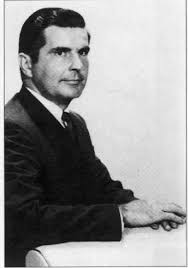

Even if there was to be no trial of Oswald, he had been accused of killing the President and in the FBI’s possession was a hand-written note from him. Wouldn’t they be interested in at least storing it somewhere for keep’s sake? Or was the note not about speaking to Marina alone, but instead a message about something else? Imagine if one of the 9/11 hijackers walked into the FBI’s office a few weeks before 9/11 and left a note for one of their agents. Then after 9/11 when the public wanted to see that note the response was that there was nothing important on it so it was torn and flushed down the toilet. The public would be furious and screaming to the hills about a government conspiracy.
Carrying on.
Hosty also revealed that while Oswald was down in Mexico City, the FBI had reason to believe he met with a KGB agent by the name of Valeriy Kostikov (gonna assume it’s a man’s name) who was in charge of assassinations and sabotage. Hosty believes had knowledge of that connection came out during the height of the Cold War, the American public would’ve demanded a military response against Russia, and with both sides having nuclear weapons, things could’ve gotten very ugly.
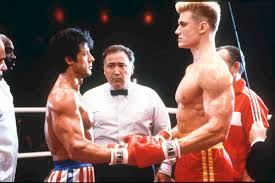
Instead there was an overall desire by the US Government to close the book on Oswald and move on. If that meant destroying evidence, being uncooperative, or misleading the public, then so be it. Hosty said the initial orders coming down the FBI chain were to assist the Dallas PD, but soon that order flipped over and the FBI was instructed to give Dallas PD the cold shoulder.
Instead there was an overall desire by the US Government to close the book on Oswald and move on. If that meant destroying evidence, being uncooperative, or misleading the public, then so be it. Hosty said the initial orders coming down the FBI chain were to assist the Dallas PD, but soon that order flipped over and the FBI was instructed to give Dallas PD the cold shoulder.
Shortly after Oswald’s death, FBI Director Hoover ordered Dallas Police Chief Jesse Curry to hand over all materials related to the case over to the FBI. Perhaps for following orders, Hosty didn’t die early of a sudden heart attack or cancer, but lived to 86, just passing away last year in 2011.
Most of it makes sense and is perfectly understandable, but if Oswald was just this loser looking for attention, how is he rubbing elbows with a KGB agent? Where would he even know to contact one? His wife Marina’s uncle was KGB, was there some linage there? Kennedy wasn’t invading Cuba and was making strides with Russia’s relationship with the US; there would be no motive for them to want to assassinate him. Jesse Ventura in his book, “American Conspiracies” recounts the time he visited Cuba and had a conversation with Fidel Castro. When discussing the subject, Castro admitted if he acted against JFK, his country would have certainly been invaded. Plus, Castro was getting word from Khrushchev that Kennedy was someone they could reason with. It was Castro’s belief it was a plot hatched by people within the US, but he doesn’t make any specific accusations.
Cliff Carter.
Yes, that Cliff Carter, named by Billie Sol Estes as an accomplice in planning eight murders with LBJ. Working as LBJ’s aide in 1963, he contacted Dallas District Attorney Henry Wade and told him to back off the initial rhetoric coming out of Dallas that Oswald was part of a communist conspiracy. The original charge against Oswald by Dallas officials in JFK’s murder was the killing was part of an international communist conspiracy, which had the White House staff furious. Carter made it clear to Wade that there was to be no talk of conspiracy and they were not to look beyond Oswald. A similar call was made the Attorney General of Texas Waggoner Carr. The Chief of Homicide in the Dallas PD Will Fritz was personally called by LBJ himself saying that Oswald was the lone gunman.
LBJ making calls?
Fritz wasn’t the only one who received a call from the new Commander in Chief.
While Oswald lay fatally wounded at Parkland Hospital after being shot by Ruby, Dr. Charles Crenshaw received a strange phone call. The surgeon picked up the phone and on the other end was no other than LBJ. Dr. Crenshaw tells this story on episode 9 of TMWKK that LBJ asked about the condition of the ‘accused assassin’, the phrase LBJ referred to, then instructed Dr. Crenshaw to inform Chief Operating Surgeon, Dr. Shires, that there would be a man in the room to take Oswald’s deathbed confession. Dr. Paul Peters of the Parkland staff recalls this incidence when Secret Service agents were in the room while Oswald was being treated, shouting into his ears and asking him if he shot the President during episode 4 of TMWKK. That must have meant Oswald never confessed to the murder of JFK while in police custody, likely Tippit either.
Dr. Crenshaw was highly criticized after a 1992 book was published about this experience and the belief was that in no way would LBJ make such a phone call.
Switchboard operator to the rescue!
Phyllis Bartlett was a switchboard operator that day at Parkland Hospital when Oswald was killed. After seeing Dr. Crenshaw being criticized publically for the accounts in his book, she stepped forward with a story to corroborate his tale. She first received a call by someone who said, “Hold the line for the President”. Moments later a second man on the phone with a voice Bartlett recognized as LBJ’s from hearing him on television and the radio, requested, “Transfer me to the doctors of the accused assassin”. Again, with that same phrase, ‘accused assassin’. Bartlett said she put the call through which went to Dr. Crenshaw.
Dr. Photos
When a make-shift press conference occurred at Parkland Hospital to discuss Kennedy’s shooting, Press Secretary Malcolm Kilduff was captured on camera saying a bullet hit the President in the head and pointed specifically to his right temple (where a shot from the grassy knoll and not the TSBD would have been able to reach).


If Kennedy was shot in the back of the head as the Warren Report says, why didn’t Kilduff make the reference by patting the back of his head instead? Did he know where the head wound was? Was Kilduff just randomly pointing to any spot on his head and coincidently selected the right temple? Maybe Kilduff was telling the truth before the ‘official word’ was put out by the disinformation machine.
If Kennedy was shot in the back of the head as the Warren Report says, why didn’t Kilduff make the reference by patting the back of his head instead? Did he know where the head wound was? Was Kilduff just randomly pointing to any spot on his head and coincidently selected the right temple? Maybe Kilduff was telling the truth before the ‘official word’ was put out by the disinformation machine.
Both Dr. Robert McClelland and Dr. Paul Peters worked on Kennedy when he was brought into Parkland and tell their story on episode 1 of TMWKK that they noticed a large exit wound to the back-right part of Kennedy’s skull (meaning it was caused by a frontal shot). In fact, Dr. Peters recalls Chief Neurosurgeon Dr. Clark looking at the wound and shaking his head that it was hopeless. Dr. McClellan remembered about 20-25% of the brain tissue was gone. They declared JFK dead at 1:00 pm CST.

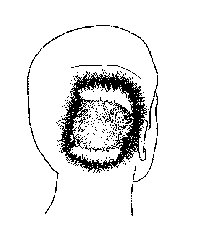
Aubrey Rike from the O’Neal Funeral Home was selected to handle JFK’s remains and transport the body from Parkland Hospital to the airport to be flown to the Bethesda Naval Hospital in Bethesda, Maryland for the autopsy. He said he wrapped Kennedy’s head with one sheet and then they wrapped Kennedy’s whole body in another sheet. They lifted Kennedy’s body up and placed him in a bronze casket, Rike remembered the spongy feeling as he handled the back on Kennedy’s head. The casket was the most expensive one they had in stock at the time and there were set to wheel it out of the hospital.
Just one problem.
By state law the autopsy needed to be done in Texas, and since they were already in Parkland Hospital, why not there? Dr. Earl Rose, according to Dr. Peters insisting on doing the autopsy in Texas and was more than qualified for the task. The Secret Service was determined to get the body out of the hospital and soon a shoving match erupted between the Parkland staff and the Secret Service for ownership of the body. There was plenty of foul language (in from of Jackie Kennedy and the Priest who performed the last rights) and the Secret Service threated to run Dr. Rose over with the casket if he didn’t get out of the way.
With an autopsy in Dallas, the Secret Service, the CIA, the FBI, high-ranking military personal, and even LBJ wouldn’t be able to control all the variables or censor any information they wouldn’t want leaking out, but by (illegally) removing the body out of Dallas and taking it to the Naval Hospital, now these entities were in complete control of all the information.
Eventually the Secret Service won the shoving match and the casket was taken out of the hospital. By 2:30pm CST the casket was loaded onto the plane and LBJ was sworn in as the new President shortly thereafter. There one famous photo of LBJ being sworn in, and a lesser known photo of Congressman Albert Thomas apparently winking at LBJ and the new President with a smirk on his face.
Air Force One touched down at Andrews Air Force Base around 6:00pm EST and showed by at the Naval Hospital around 8:00pm EST. This is when things became very bizarre according to Paul O’Conner’s testimony in episode 1 of TMWKK.
O’Connor was a medical technician that participated in Kennedy’s autopsy. The first glaring remark he made was that the body was in a cheap ‘shipping casket’ as he described it, and the body itself was in an ordinary rubber grey body-bag. At Parkland Hospital, Aubrey Rike had wrapped Kennedy’s body in a sheet and placed him in a bronze casket. So somewhere between when the casket was taken out of Air Force One after it landed at Andrews Air Force Base at 6pm and the time the body showed up at the autopsy at 8pm, Kennedy’s body had been tampered with (and who knows what evidence with it). The body was under the supervision of Alexander Haig, who would go on to serve as Secretary of State under the Reagan Administration.
Dr. James Joseph Humes and Dr. J. Thornton Boswell were two pathologists selected to lead the autopsy, which Paul O’Connor felt were strange choices because he knew those of two as administrators at that point of their careers and not the most qualified pathologists on staff to handle the procedure. In fact, he never even saw them in the morgue before. Dr. Humes had to call on Dr. Pierre Antoine Finck to help assist them. The other witnesses present at the autopsy were high-ranking military officials, Secret Service agents, someone from the FBI, and what O’Connor describes, really sinister looking people. With both Humes and Boswell career military people with not the best reputation for being good pathologists, they could be relied on to follow orders and operate a sloppy autopsy under command. Had the autopsy been performed in Dallas, this wouldn’t have been the case.
All night long, O’Connor said, once they started on a procedure, other witnesses in the room would huddle up together and speak in private, then come over to Kennedy’s body and order them to move onto something else. O’Connor’s job was removing the brain and the way he describes the head wound coincides what Dr. Peters and Dr. McClellan at Parkland Hospital saw, the back right half of the skull blown out, which indicates an exit wound. When he went to remove the brain, he realized it was just about all gone. Dr. McClellan at Parkland hospital described the brain as missing 20-25% of the tissue, but O’Connor said at the autopsy it was gone as in barely a handful left. In addition to Kennedy’s body being transferred to a body-bag inside a cheap shipping casket, more of his brain tissue had been removed as well before his body was taken to the autopsy. The importance of having the brain would’ve helped determined what gun was used and where the shots were fired from. Without a brain to serve as proof of the President being shot from the front, there could be no contradiction to the story of three shots from the TSBD by Oswald’s rifle.
The President’s brain was on record as being examined by Doctors Humes, Boswell, and Finck. Samples and tissue slides were taken and later on entered into the National Archives. So if O’Connor was lying and Kennedy had enough of a brain to examine, why not just look up the data?
You can’t.
It’s missing.
By October 30, 1966, JFK’s brain and other autopsy tissue results went missing from the National Archives with no paper trail on who ordered them removed.
There are autopsy photos of Kennedy’s head wounds and it doesn’t look like most of his brains are missing, so what gives?
Once the photos were displayed, none of the sixteen Parkland Hospital staff members who treated Kennedy on November 22, 1963 recognized the wounds from what they saw that day.

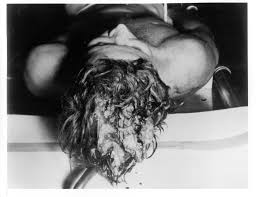

Paul O’Connor said the photos were inconsistent to what he witnessed during the autopsy, specifically the back of Kennedy’s head which looks intact in the picture, but from what he saw was half blown out with the brain missing.
Paul O’Connor said the photos were inconsistent to what he witnessed during the autopsy, specifically the back of Kennedy’s head which looks intact in the picture, but from what he saw was half blown out with the brain missing.
Joe O’Donnell tells this bizarre story in episode 7 of TMWKK about two sets of photos a colleague of his showed him. O’Donnell was a photographer himself from World War II and had a twenty-three year career in the State Department and US Information Agency. In all he served under six different Presidents. This colleague, Robert Knudsen, also a photographer, said he was selected to take photos for the Kennedy autopsy and was able to show O’Donnell two different prints within days of each other. The first prints were of the back of the President’s head with a grapefruit sized hole, the next set days later, that grapefruit sized head wound is not there and that part of the head looks intact.
The only snafu with this tale is Robert Knudsen is not on record as logged in as one of the witnesses present at the autopsy. Unless his name was purposely left off so nobody would ever ask him questions.
Joe O’Donnell isn’t the only one who claimed to have seen different photographs.
Dennis David was posted at the Naval Hospital around the time the autopsy took place as he spoke during episode 6 of TMWKK. He said a colleague of his as well, William Bruce Pitzer, Head of the Audio Visual Unit, showed him a 16mm film of the autopsy about 3-4 days after it took place. Pitzer also had film slides of JFK at the morgue, pictures of JFK show a small hole near his right temple (entrance wound) and a big hole in the back (exit wound).
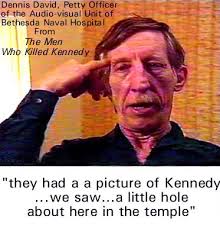
December 1965 Dennis David left the Naval Hospital for another post, but before leaving he remembered Pitzer mentioned to him he was planning on retiring and had offers from TV networks.
October 1966 William Bruce Pitzer was found dead at the hospital in a pool of his own blood. A gunshot wound to the head and a gun in his right hand. It was ruled a suicide. His left hand was badly mangled to the point his wife struggled getting his wedding ring off afterwards.
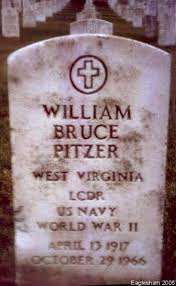
David felt it was odd Pitzer was found with the gun in his right hand because they knew of him as a lefty. Perhaps with his left hand damaged, he had no choice but to use his right. Was his left hand damaged from someone looking for those original film and pictures he had?
David felt it was odd Pitzer was found with the gun in his right hand because they knew of him as a lefty. Perhaps with his left hand damaged, he had no choice but to use his right. Was his left hand damaged from someone looking for those original film and pictures he had?
Dennis David thinks so, with Pitzer retiring and getting TV offers, it’s his belief Pitzer was killed out of fear that he might release those original autopsy materials to one of those TV networks.
Can anyone back this story up?
Retired Lt. Col. Dan Marvin from the same episode 6 of TMWKK series can.
In 1993 Marvin was watching a thirtieth anniversary special regarding the JFK assassination and there was a list of 42 names posted of people who were linked to the event that strangely died years after, which will be discussed later on too. One of these names was William Bruce Pitzer and it brought back a long forgotten memory for Marvin.
Around thirty years before that television special, Marvin was with the Green Berets and in a top secret guerilla warfare training program at Fort Bragg. These guerilla tactics were to be used at the service of the CIA for overseas operations.
This next part sounds too good to be true, but Marvin, who had over twenty-one awards and decorations in his military career, said this happened.
One day CIA instructors came into the training class with a mock-up of Dealey Plaza, and described the JFK assassination as the ideal method to remove a national leader and point a finger at a lone nut. He recalls they specifically pointed out were the shooters should be (or were) positioned and said Oswald was just a patsy.
This upcoming line is the real over the top part.
During a coffee break of this session, Marvin overheard one CIA agent tell the other something to the extent of, “Things really went well in Dealey Plaza”.
So how does William Bruce Pitzer finally come in?
A CIA agent approached Marvin and asked him if he would be willing to kill a US citizen, a Naval officer to be exact. Wanting more information about the job before proceeding, Marvin asked for the target’s name, and the CIA agent said William Bruce Pitzer at Bethesda. From what Marvin was taught, he was only to be used to kill foreigners overseas, not US citizens in the US. He said his group was taught that the mafia supplies killers for domestic jobs. Marvin turned down the mission, so in August 1965 the job was accepted by someone else by the name of David H. Vanek. After Vanek left for this mission, Marvin never saw or heard from him again and didn’t think about the situation until 1993. After seeing William Bruce Pitzer’s name from the TV show and wondering whatever became of Vanek, he decided to reach out to him.
There was a retired servicemen’s directory for former soldiers to contact each other and Marvin attempted to use this system to get in touch with Vanek, but was getting no response. Soon after, Marvin threatened to seek the help of then New York Governor Al D’Amato, and finally there was a response. The message was that nobody with that name ever existed in the US army. From Marvin’s tenure at the training camp in 1965, he was able to produce an official document of the members in that group at Fort Bragg, and one of the names was David H. Vanek with his serial number.
It would seem after Vanek erased Pitzer, someone erased Vanek.
Any manipulation of autopsy photographs couldn’t be done by some lone nut named Lee Harvey Oswald, as by that time he was dead and buried. The manipulation would point to a higher power, somewhere in the world of the CIA and LBJ. Since LBJ never made a public statement that the photographs were fakes (assuming he too saw Kennedy’s corpse at Parkland), then that in itself includes him in any conspiracy to cover up the murder. Whether the cover up was for the good of America or to hide any knowledge of he had of a plot to kill Kennedy beforehand, is still up in the air, but nevertheless if either the O’Donnell or the Marvin stories are true, then there was a cover up from the highest point of the US Government.
Waxy Perspective
Tom Wilson spent thirty years working with US Steel and specialized in image processing techniques to look for imperfections in steel processing. This computerized system is able to apply mathematical scientific data to photographed images for analysis. Wilson’s image technology can also be used in the case of gunshot wounds and his expertise has been accepted in Federal Court. He used this process to review the Zapruder film of the assassination along with the autopsy photographs and found some chilly discoveries. His story is told is episode 6 of TMWKK.
The first key finding is the shot to JFK’s head coming from the right and to the right. The only problem was he was having difficulty with the angle coming from someone being perched up on the grassy knoll. The angle, according to his image technology, was positioning the headshot from somewhere lower. Then Wilson figured it out, there was a storm drain on Elm St. to the front and right of the limo, and when he used that hypothesis, everything made sense with scientific analysis (Bill Bonanno in his autobiography said Johnny Roselli told him in prison he took a shot from the storm drain).
The second important study Wilson embarked on was the autopsy photographs of Kennedy. The image technology is able to differentiate authentic human tissue from any synthetic materials. He was able to detect the large hole in the back of Kennedy’s skull which looked intact in the autopsy photos, plus able to discover the entrance wound on Kennedy’s right temple. As for Wilson’s theory on why the Kennedy autopsy photos look the way they do, he said they are panned images on the original photograph.
Other researchers have also noted that in the autopsy pictures, especially the one of the back of Kennedy’s head, the photograph is three-dimensional except for the part covering the back right part of the head, which views in only two-dimension.
How were the photographs able to hide Kennedy’s real wounds?
Wilson detected a substance, likely mortician’s wax, on the ear and face of Kennedy in the autopsy photos. Though he made these two startling findings, using a technology process that was applied for US Steel and accepted in Federal Court, when he took this JFK information to the government and the media, nobody displayed any interest.
As for who was able to do the patchwork on Kennedy’s head to help forge the photographs in the first place, the story of John Liggett from episode 7 of TMWKK provides a source for that.
Liggett was an embalmer and had a sterling reputation for using mortician’s wax and other materials to produce limbs and body parts for bodies, according to fellow mortician and friend Charles Smith. This method was important for deceased people who died of nasty accidents or gunshot wounds and needed to look presentable at their funeral.
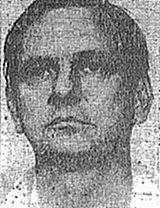

Liggett and Charles Smith worked for Restland Funeral Home, and Smith recalled how Liggett’s expertise allowed him more leeway with the funeral director and Liggett would sometimes disappear for two or three weeks at a time with no reprimand. Lois, a former wife of John Liggett, tells the story of what happened to her one-time husband around the time of the assassination.
Liggett and Charles Smith worked for Restland Funeral Home, and Smith recalled how Liggett’s expertise allowed him more leeway with the funeral director and Liggett would sometimes disappear for two or three weeks at a time with no reprimand. Lois, a former wife of John Liggett, tells the story of what happened to her one-time husband around the time of the assassination.
While at the gravesite for a relative who was being buried on the day Kennedy was shot, John was pulled aside and told someone was trying to reach out to him. John told Lois that he was summoned to Parkland Hospital. John phoned Lois from Parkland Lois asked if Restland was selected to handle the President’s body, John said no (the job went to the O’Neal Funeral Home).
Neither Lois nor a step-daughter of John Liggett’s, Debra Godwin, were able to provide exact hourly references for when John returned, which hurts the validity of their story, but it’s still worth continuing.
Lois described the time John was gone as long enough to have gone to Bethesda, MD, where Kennedy’s autopsy took place, and come back. She described John looking disheveled as he told the family they needed to leave town till this blows over. John didn’t mention anything more than that. He took Lois and his step-daughter, Debra, and they drove through Texas. During the trip John was making phone calls and speaking in coded language. He even met up with his brother Malcolm to discuss matters. On November 24th, they were in a hotel in Corpus Christi, TX and Debra described John as nervously glued to the television. After seeing Ruby shoot Oswald, Debra mentioned that John looked much calmer and he said the family was able to return home.
After the time of the assassination, John seemed to have come into a lot of money; they moved into a bigger house, John began a big gambler, and would even host gambling parties at his new house. Debra remembered one party guest she used to make fun off because of his funny eyebrows, and that was a man by the name of David Ferrie, who was from New Orleans and John said was in the Civil Air Patrol (seems too good to be true, I know). Ferrie is distinctively identified by his toupee and painted-on eyebrows. A radiation leak on a plane he flew caused him to lose about all of his body hair.

John kept down this path of partying and gambling which put a strain on the marriage, so Lois eventually divorced him in 1966. The gambling environment must have been appealing to John, because Lois said he spent some time working in the Las Vegas casinos as a dealer after they split.
From there John Liggett really went off the deep end and was involved in burglaries and suspected in a number of killings. What got him arrested in 1974 was the attempted murder of a lady named Dorothy Peck.

Around this time Lois said she met with John’s brother, Malcolm, who was one of the people John was in contact with as they went on that road trip after Kennedy’s death, and Malcolm warned Lois to stay away from John under the threat of her children’s lives. John Liggett was held at Dallas County Jail for nearly a year without any interrogation on record.
Around this time Lois said she met with John’s brother, Malcolm, who was one of the people John was in contact with as they went on that road trip after Kennedy’s death, and Malcolm warned Lois to stay away from John under the threat of her children’s lives. John Liggett was held at Dallas County Jail for nearly a year without any interrogation on record.
On February 14, 1975, on a transfer from the courthouse to the county jail, John managed to use a hidden key to get out of his handcuffs and made a break for it. A sheriff’s deputy shot him in the back and John Liggett was dead on sight. Malcolm Liggett handled the funeral arrangements with Restland. Mortician Charles Smith, who said he was a friend of Liggett, was present as the body was being prepared for the funeral.
Another wife of John Liggett’s, Leona, says something different.
In 1992 the step-daughter, Debra Godwin, said she spoke to Leona, who was John’s wife at the time he was killed for trying to escape, and Leona had a very interesting statement. Leona said that it wasn’t John Liggett’s body on display at Restland during his supposed funeral. She even referenced a mustache the corpse had which Debra found strange since she knew of John Liggett’s inability to grow one.
Lois also had a bizarre experience.
On a trip to Las Vegas with her grandkids she saw a dealer in a casino who had a striking resemblance to John Liggett. When Lois called out to her granddaughter by her name, she noticed this dealer immediately looked at the little girl, as if he knew who she was. Moments later, the dealer turned his back towards Lois and signaled to a co-worker in the direction from where Lois was standing. Startled by what she had just seen, Lois took her grandkids exited and the casino.
Is that the end of the story?
Not quite yet.
A photo that recently surfaced of Jack Ruby at his Carousel Club with a group of people added another dimension to this story. Debra pointed out that the man standing next to Ruby was none other than John Liggett’s brother, Malcolm, and Malcolm’s wife Susan next to him. Although not really related to the story, Debra also recognized a lady in the picture by the name of Iris Campbell. For a while Iris had befriended Lois as the two of them attended the same Episcopalian church, but then Iris disappeared.
The linkage in this story is John performing his wax expertise that would help in the Kennedy autopsy photographs being forged. Then John taking the family out of town immediately after the autopsy and making calls to people, including his brother Malcolm. There’s the photograph at the Carousel Club which shows Ruby and Malcolm standing next to each other. John watches Ruby kill Oswald on TV and seems relieved. After being monetarily rewarded for his work on Kennedy, John parties hard and has David Ferrie in his circle, who other witnesses have tied to both Ruby and Oswald.
There are plenty of holes in this story as in how did an expert embalmer turn to breaking into houses, when John Liggett took the family out of town after JFK’s death did nobody pressure him to explain why they needed to leave, and how come nobody called the police when another person’s corpse was used for John Liggett’s funeral?
Although most of this seems like it came from a sci-fi novel, there is that photo of Ruby and Malcolm Liggett standing together. Was Ruby just coming over to pose with them because he was the club’s owner, or did those two know each other?
The Video Replay
Abraham Zapruder took his camera to film the President’s parade that day, never knowing his footage would be used by parties of both side of the conspiracy debate. He perched himself up on a concrete block near the monument area of the grassy knoll and had receptionist, Marilyn Sitzman, hold him steady. In 1954 he co-founded Jennifer Juniors, Inc., producing the Chalet and Jennifer Juniors clothing brands, and had offices in the Dal-Tex Building across the street from the TSBD. The filming of the President’s shooting has been called the Zapruder Film.
Walking back to his office amid the confusion following the shots, Zapruder encountered Dallas Morning News reporter Harry McCormick, who was acquainted with Agent Forrest Sorrels of the Secret Service's Dallas office. McCormick offered to bring Sorrels to Zapruder's office. Zapruder continued to his office where he sent his assistant Lillian Rogers to find a Secret Service agent, in case McCormick failed to find Sorrels. McCormick did find Sorrels, outside the Sheriff's office at Main and Houston, and together they went to Zapruder's office. Zapruder agreed to give the film to Sorrels on the condition it would be used only for investigation of the assassination. The group took the film to the television station WFAA to be developed.
After it was realized that WFAA was unable to develop Zapruder's footage, in the late afternoon it was taken to Eastman Kodak's Dallas processing plant where it was immediately developed. Because under the Kodachrome process, different equipment is required for duplication than for simple development, around 6:30 p.m. the developed original was taken to the Jamieson Film Company, where three additional copies were exposed; these were returned to Kodak around 8 p.m. for processing. Zapruder kept the original, plus one copy, and gave the other two copies to Sorrels, who sent them to Secret Service headquarters in Washington.
Late that evening, Zapruder was contacted at home by Richard Stolley, an editor at Life magazine. They arranged to meet the following morning to view the film, after which Zapruder sold the print rights to Life magazine for $50,000. The following day on November 24, Life purchased all rights to the film for a total of $150,000 (equivalent to $1 million in 2007). Zapruder gave the first $25,000 to the widow of Dallas policeman J.D. Tippit.
The night after the assassination, Zapruder is said to have had a nightmare in which he saw a booth in Times Square advertising "See the President's head explode!" He determined that, while he was willing to make money from the film, he did not want the public to see the full horror of what he had seen. Therefore, a condition of the sale to Life was that frame 313, showing the fatal shot, would be withheld
Zapruder appeared on WFAA-TV in Dallas to give his account:
Zapruder: “ I got out in, uh, about a half-hour earlier to get a good spot to shoot some pictures. And I found a spot, one of these concrete blocks they have down near that park, near the underpass. And I got on top there, there was another girl from my office, she was right behind me. And as I was shooting, as the President was coming down from Houston Street making his turn, it was about a half-way down there, I heard a shot, and he slumped to the side, like this. Then I heard another shot or two, I couldn't say it was one or two, and I saw his head practically open up , all blood and everything, and I kept on shooting. That's about all, I'm just sick, I can't…”
When describing the brain-splattering head wound of Kennedy, he made a cone shape out of his right hand and placed it on the right side of his head, above the ear.
On November 22, Secret Service Special Agent Maxwell D. Phillips sent a hand-written memo to Secret Service head James Rowley, stating that, "According to Mr. Zapruder the position of the assassin was behind Mr. Zapruder."
When Zapruder testified in front of the Warren Commission, he seemed less confident in stating that it sounded like the shots came from behind in.
Zapruder: “No, there was too much reverberation. There was an echo which gave me a sound all over. In other words that square is kind of — it had a sound all over.”
Zapruder added that he had assumed the shots came from behind him because the explosive wound on the side of the President's head was facing that direction, and because police officers ran to the area behind Zapruder (perhaps he was debriefed to use that excuse in case anyone asked him why did he originally claim the shots came from behind him). Zapruder testified again at the 1969 Jim Garrison trial of Clay Shaw.
Abraham Zapruder’s ultimate reward for filming the assassination? He died of stomach cancer at the age of 65 in 1970.
When “Life” magazine first published the film’s stills for one of their issues after the assassination, they were sequenced out of order.
Another strange thing happened with “Life” after the Warren Report came out. There was an issue dedicated to the report’s findings with eight frames of Zapruder film images displayed. The only problem was frame #323 turned out to contradict something in the Warren Report, so #323 was replaced by frame #313, which is the one where Kennedy’s head explodes. The revised magazine article ran into a similar issue later on and this particular issue of “Life” went under two revisions and had three versions in total.
The magazine, as well as the New York Times, stood by the findings of the Warren Report in the years after the assassination, but in November 1966 “Life” put out an article titled, “Did Oswald Act Alone? A Matter of Reasonable Doubt.” This was to be the first of a series of articles on the subject, but in January 1967 editor Richard Billings was informed that, “It is not Life’s function to investigate the Kennedy assassination.” Billings resigned shortly thereafter.
Good job Fourth Estate on keeping the government in check!!
Why should it be fishy Time-Life had ownership of the Zapruder film?
The publisher of “Life” from 1960 to his death in 1964, C.D. Jackson, was supposedly mortified by the footage and was the one who ordered the rush in obtaining the film’s rights as a way to keep it out of the public’s view until things calmed down.
Perhaps there was another reason he wanted to get his hands on it so quickly.
In 1977, Carl Bernstein, who co-authored the infamous Watergate articles for the Washington Post which led to the 1976 film, “All the President’s Men”, wrote a piece for “Rolling Stone” regarding Time-Life founder Henry Luce and his liaison to the CIA, C.D. Jackson. One arrangement Jackson had with the CIA was providing cover for their agents as Time-Life employees.
After Time-Life purchased the rights to the film, it was allegedly stored in a CIA-run lab at Kodak’s Rochester, NY office (where the film could be adjusted in privacy).
Max Holland, author of The Kennedy Assassination Tapes, and a professional photographer named Johann Rush, in a joint editorial piece published by The New York Times on November 22, 2007 pointed out that Zapruder temporarily stopped filming at frame 132, when only police motorcycles were visible. When he resumed filming, frame 133 already shows the presidential motorcade in view. This pause could have great significance for the interpretation of the assassination. Did Zapruder stop filming or was an important piece of footage, such as evidence of other shots being fired, edited out?
In the authors' words, "The film, we realize, does not depict an assassination about to commence. It shows one that had already started."
Part Four: The Fix - Results
Even to this day, the major TV networks and newspapers such as the New York Times and Washington Post will not give any credence to a story which opposes the Warren Report’s final conclusions. When there is a television show aired about the subject, the conspiracy theorists selected to appear on camera are typically the most slack-jawed-knuckle-dragging whackos they could possibly find in which an audience will already have their minds made up that the person is totally absurd before they even open their mouth.
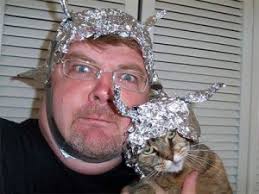
What makes TMWKK series unique is that people who appear on camera and don’t agree with the Warren Report are doctors, distinguished military veterans, politicians, and not the same crowd of people who claim they’ve been abducted by aliens and walk around with tinfoil on their head.
What makes TMWKK series unique is that people who appear on camera and don’t agree with the Warren Report are doctors, distinguished military veterans, politicians, and not the same crowd of people who claim they’ve been abducted by aliens and walk around with tinfoil on their head.
Another media manipulation trick performed when it comes to the topic of the JFK conspiracy is discussing the theories which are completely out of the realm of reality, which again, the audience has their minds influence to think that any conspiracy theory in this case must be crazy. As an example, a recent National Geographic television program on the JFK assassination dedicated time towards discussing the possibility that one of the Secret Service men riding in the same limo as JFK delivered the fatal headshot with a concealed handgun. The trick is to get the audience to view a theory that is near impossible, so when any other more plausible notion such as a shooter positioned on the grassy knoll or in the storm drain is proposed, the audience will be quick to dismiss those ideas as well.
Unfortunately this trend of not holding the government accountable has continued since the JFK assassination. The only small glimmer of hope was when the New York Times started to publish the Pentagon Papers, which was later carried on by other newspaper outlets. These documents, provided by Daniel Ellsberg, exposed government lies in the years before and during the Vietnam War. Other than that, the government has had a free ride from the Fourth Estate and with the strong competition in today’s intense media environment, no news outlet will risk losing their White House access or government sources by challenging the authority.
Longtime CBS News anchorman Dan Rather was forced to leave the network after going ahead with a story which questioned President George W. Bush’s tenure with the Air National Guard. It turns out Rather’s story was inaccurate, but instead of just saying sorry and moving on, he was forced to leave. When it turns there were no weapons of mass destruction in Iraq after the US invasion under the second Bush, nobody complained and Bush even got re-elected (Bush wasn’t forced out of his job for being wrong like Dan Rather was). When the federal government declared the air around Ground Zero as not harmful after 9/11 and eleven years later those responders are getting all sorts of cancers and respiratory problems, there was nothing more than a mere mention.
Instead the public is saturated by nonsensical news such as a debate over some healthcare bill which won’t even go into effect until the next twenty years, abortions, and celebrities entering drug rehab. The media also throws distractions at the public such as engineered hype over gadgets like the iPad, that snowball into in a mass frenzy, but in reality have as much use to society in 2012 than the ‘Tickle-Me’ Elmo doll had in 1996.
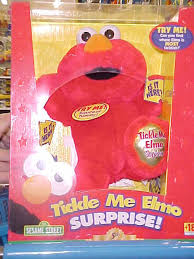


These sensational stories replace the real topics the public should be concerned with and the method to keeping citizens under control is to keep them ignorant.
These sensational stories replace the real topics the public should be concerned with and the method to keeping citizens under control is to keep them ignorant.
As technology has spread and will continue to spread to connect us all to the internet on a literal 24/7 basis where all information will be fed through, control of the internet by the government (which already started taking shape years ago) will remove any contradictory discourse and keep citizens blindfolded. Such as in the H.G. Wells classic, “The War of the Worlds”, aliens beamed down to Earth to drain humans of their blood, currently social media tools such as Facebook and Twitter are draining humans of their lives and storing them on a KB somewhere on the World Wide Web for corporations to tailor advertising around and for the government to mold. There’s a reason why Facebook is free.
Harry Weisberg summed it up best when it comes to the JFK conspiracy and his words will ring true in the years to come for future topics:
“Substantial criticism never had a voice.”
This power struggle of information between the FBI and Dallas local officials during the early part of the Kennedy investigation left many unanswered questions which has only raised the number of conspiracy theorists. With Kennedy freshly killed in Parkland Hospital, running the autopsy there would’ve brought more facts to the surface versus running the autopsy six hours later under lock and key at some military hospital. Although it was a President who was murdered, it was still a street homicide and a normal murder investigation by a better experienced Dallas PD in their own town would’ve yielded better results than a bunch of suits walking around with crew cuts in a foreign state. Besides, Jack Ruby had Dallas policemen in his Carousel Club all the time, who better to investigate if he had any connections to the mob or Oswald? Whatever facts the FBI and CIA did have, they weren’t fully cooperative with the Warren Commission or the HSCA, and this practice of withholding information between law enforcement agencies was a major cause for the 9/11 attacks.
Paul O’Connor, who participated in the autopsy, said two days after the session was forced to sign a confidentially agreement to not disclose anything about the autopsy. The 1976 HSCA investigation was able to waive that agreement which allowed him to speak to the panel as well as grant interviews in the years following. O’Connor died in 2006 at the age of 65.
As for the sinister looking people O’Connor described in the autopsy room that night who were directing the autopsy, one of them was Roy Kellerman, a Secret Service agent who rode in Kennedy’s limo. Kellerman testified to the HSCA that he played a role in the autopsy at Bethesda, including guiding the doctors toward specific conclusions regarding bullet locations. Kellerman also took personal custody of the x-rays and photographic negatives at the conclusion of the autopsy and took them with him as he rode in the ambulance that transported the president's casket to the White House. When asked by the HSCA staff why he wanted this material, he said "...the point is, he was our man, everything belonged in the White House.”
According to his widow June, Roy Kellerman believed there was a conspiracy behind the death of JFK. The daughter of Roy Kellerman mentioned something similar to Harry Weisberg in the 1970's, "I hope the day will come when these men (Kellerman and Greer {limo driver}) will be able to say what they've told their families".
If Kellerman was sincere with helping solve Kennedy’s murder, confiscating the body and the evidence says otherwise.
Another person who directed traffic in the autopsy room as later named by O’Connor was Rear Admiral George Burkley, who served as Kennedy’s personal physician. He would use the excuse of the Kennedy family not interested in something to get the medical team to leave what they were working on and move to a different procedure.
As for these stories of fake autopsy photos.
On May 29, 1992 to former navy medical technicians who were at the autopsy that night, Jerrol Custer, who X-rayed the body, and Floyd Riebe, who took photographs, said the Warren Commission had been supplied with fake photographs and X-rays. They further claimed they were instructed by the Secret Service (Roy Kellerman and Bill Greer maybe?) to keep their mouths shut about what they had seen.
The 1976 HSCA inquiry, which was supposed to be the new aged and uncompromised investigation into the Kennedy assassination, wouldn’t allow the medical staff at Parkland Hospital to testify against the Kennedy autopsy photos. Since the HSCA already knew they all disagreed with them based on what they saw when they treated Kennedy on November 22, 1963, in no way was the HSCA going to allow their statements to taken on the subject.
G. Robert Blakey, who ran the HSCA, had ‘photo specialists’ brought in and they (of course) testified the autopsy pictures were authentic.
As for the witnesses the HSCA did speak to who were present at Kennedy’s autopsy?
Those interviews will not be released until the year 2028.
Malcolm Liggett, the brother of master embalmer John Liggett who was apparently photographed with Jack Ruby, sued The Arts & Entertainment Network for what was said about him in episode 7 of TMWKK. A settlement was reached out of court. Malcolm said he was in Santa Barbara, CA the time it was alleged he met up with John on route to Corpus Christi, TX. Secondly, he said it is not him in the Jack Ruby photograph and it was a trick by the show’s producers to somehow connect Malcolm and John to the Kennedy conspiracy. Malcolm Liggett was an economics professor and died in 2008 at the age of 78.
Why would John Liggett’s former wife, Lois, and her daughter from a previous marriage, Debra, make up such a wild allegations is difficult to say. Money of course is a great motivator, but one would have to assume TMWKK producer Nigel Turner put them through some sort of screening to make sure their story checked out amongst the stack of other Kennedy conspiracy tales thrown his way. Someone who appears to be in the middle of the pack, mortician Charles Smith, although he says it was John’s body that was prepared for his 1975 funeral, does state before the Kennedy assassination that John would disappear for weeks at a time. Was John away on party binges, which would explain his reckless behavior later in life? Was John on call for intelligence agencies, or even the mafia, to apply his trade as an undertaker to disguise murders as natural deaths? Was the new persona of gambler and criminal staged and his death faked as a method to erase his identity and start a new life?
If Malcolm Liggett was completely innocent, why settle out of court? Why not take the Arts & Entertainment Network for all they got in a big trial to prove TMWKK series was nothing but a bunch of baloney? A trial would’ve required both sides to provide evidence, and maybe there was something Malcolm Liggett didn’t want entered into a court case.
The Zapruder film went on a rollercoaster ride itself in the decades following its creation.
In 1967, “Life” magazine hired a New Jersey film lab, Manhattan Effects, to make a 16 mm film copy of the original Zapruder film. Pleased with the results, they asked for a 35 mm internegative to be made. Mo Weitzman made several internegatives in 1968, giving the best to “Life” and retaining the test copies. Weitzman set up his own optical house and motion picture postproduction facility later that year. Employee and assassination buff Robert Groden, hired in 1969, used one of Weitzman's copies and an optical printer to make versions of the Zapruder film using close-ups and minimizing the camera's shakiness.
Prior to the 1969 trial of New Orleans businessman Clay Shaw for conspiracy in connection with the assassination, a copy of the film several generations from the original was subpoenaed from Time Inc. in 1967 by New Orleans District Attorney Jim Garrison for use at Shaw's grand jury hearing (Garrison unsuccessfully subpoenaed the original film in 1968). The courtroom showings of Garrison's copy in 1969 were the first time it had been shown in public as a film. Noted conspiracy theorist Mark Lane, author of "Rush to Judgement", was in New Orleans at the time to assist Garrison in his investigation. Lane 'borrowed' Garrison's copy of the Zapruder film (with Garrison’s approval supposedly) and had several copies printed at a local lab. These low quality copies began circulating among assassination researchers and were known to many journalists as well. The underground circulation of these copies and the secret screenings to a select few who had the opportunity to see them added an additional aura of mystery to the film, enhancing the idea that there was a secret to be found in it that was being kept hidden from the general public.
On March 6, 1975, on the ABC late-night television show Good Night America (hosted by Geraldo Rivera…of course), assassination researchers Robert Groden and Dick Gregory presented the first-ever network television showing of the Zapruder home movie.
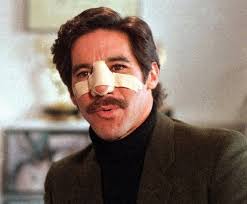
The public's response and outrage to that first television showing quickly led to the forming of the Hart-Schweiker investigation, contributed to the Church Committee Investigation on Intelligence Activities by the United States, and resulted in the House Select Committee on Assassinations investigation.
The public's response and outrage to that first television showing quickly led to the forming of the Hart-Schweiker investigation, contributed to the Church Committee Investigation on Intelligence Activities by the United States, and resulted in the House Select Committee on Assassinations investigation.
In April 1975, in settlement of a royalties suit between Time Inc. and Zapruder's heirs that arose from the ABC showing, Time Inc. sold the original film and its copyright back to the Zapruder family for the token sum of one dollar. Time Inc. wanted to donate the film to the U.S. government. The Zapruder family initially refused to consent, but in 1978 the family transferred the film to the National Archives and Records Administration for appropriate preservation and safe-keeping, while still retaining ownership of the film and it’s copyright. Director Oliver Stone paid approximately $85,000 to the Zapruder family for use of the Zapruder film in his motion picture JFK (1991).
On October 26, 1992, President George H. W. Bush signed into law the John F. Kennedy Records Collection Act of 1992 (the "JFK Act"), which sought to preserve for historical and governmental purposes all records related to the assassination of President Kennedy. The Act created the President John F. Kennedy Assassination Records Collection at the National Archives. The Zapruder film was automatically designated an "assassination record" and therefore became official property of the United States government. When the Zapruder family demanded the return of the original film in 1993 and 1994, National Archives officials refused to comply.
On April 24, 1997, the Assassination Records Review Board, which was created by the JFK Act, announced a "Statement of Policy and Intent with Regard to the Zapruder Film". The ARRB re-affirmed that the Zapruder Film is an "assassination record" within the meaning of the JFK Act and directed it to be transferred on August 1, 1998 from its present location in NARA's film collection to the John F. Kennedy Assassination Records Collection maintained by NARA. As required by law for such a seizure under eminent domain, payment to Zapruder's heirs was attempted. Because the film is unique, the film's value was difficult to ascertain; eventually, following arbitration with the Zapruder heirs, the government purchased the film in 1999 for $16 million.
The Zapruder family retained copyright to the film, which was not seized. In 1997, the film was digitally replicated and restored under license of the Zapruder family. The 1998 documentary Image of an Assassination: A New Look at the Zapruder Film shows the history of the film, as well as various versions of the restored film.
In December 1999, the Zapruder family donated the film's copyright to The Sixth Floor Museum, in the Texas School Book Depository building at Dealey Plaza, along with one of the first-generation copies made on November 22, 1963, and other copies of the film and frame enlargements once held by “Life” magazine, which had been since returned. The Zapruder family no longer retains any rights to the film, which are now controlled by the Museum.
All that just for taking a camera out one day to enjoy a parade with.
Part Five: As It Happened
The People Behind The Fence
After the shots were fired, a mass crowd headed for the picket fence on the grassy knoll area. When statements were taken, nearly fifty eyewitnesses said they heard shots coming from that area.
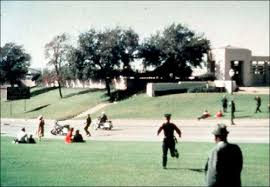
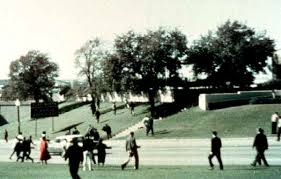
Officer Joe Marshall Smith of Dallas PD saw people running towards that way, so he pulled his gun out and headed in that direction as well. When testifying to the Warren Commission, Smith said there was a man behind the fence who flashed a Secret Service badge. What he felt odd about that man was that he had dirty hands and tatted clothes. Possibly he was one of the ‘3 Tramps’ photographed who were taken away in police custody, but no record shows what happened to them afterwards.
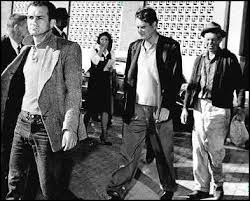
According to the Secret Service, they didn’t have anyone positioned in Dealey Plaza, especially in the rail yard behind the picket fence, so who was that guy?
Ed Hoffman was a deaf-mute who wanted to see the parade that day and found a high-up position on the freeway which also overlooked the rail yard behind the picket fence. After the shooting, he claims he saw someone wearing a blue suit and blue hat carry a rifle from behind the fence and hand it over to someone dressed like a railroad worker, who went behind a signal box to take the gun apart. According to Hoffman’s sign-language account in episode 2 of TMWKK, he took this information to the FBI and was offered money to keep quiet about it. Researchers have discovered that Hoffman’s story has changed over the years and his account has been widely criticized.
Lee Bowers worked in the rail yard signal tower and had the best view from behind the picket fence. He told the Warren Commission he saw up to four men behind the fence; two of who were uniformed parking attendants (one of which he knew), a heavier and older gentleman in a white shirt and dark trousers, and a younger gentleman in his mid-twenties with a plaid jacket or shirt (these were later believed to be groundskeepers). Bowers described that the police officer showed up “immediately” after the shooting.
He was also interviewed for the 1967 documentary “Rush to Judgment” and clarified his Warren Commission testimony that he saw no one directly behind the fence during the time of the shooting.
Lee Bowers wasn’t able to grant any interviews after that. The man who had the best view from behind the picket fence died of a car accident in August of 1966. His car left an empty road and struck a concrete bridge abutment near Midlothian, TX. Sounds a lot like Mac Wallace’s death from 1971 – car crash on an empty road with no witnesses.
Gordon Arnold was 22 years in 1963 and fresh out of a military training camp and on his way to a posting in Alaska. He brought his camera with him that day for the parade and had originally wanted to position himself behind the fence. He says in episode 2 of TMWKK that a man in a suit pulled out what he described as a CIA card and after that Gordon went the other side of the fence on the grassy knoll (maybe that was the same CIA or Secret Service official Officer Joe Marshall Smith encountered behind the fence). As Gordon was watching and the shots rang out, he recalled a shot buzzing by his left ear before he jumped for cover. A shot going by his left ear would’ve indicated a shooter positioned behind him where the picket fence was.
After the shooting, Gordon claimed a policeman with no hat on, took out his gun and forced Gordon to hand over his camera. Scared out of his wits, Gordon was off on his eighteen-month post in Alaska and didn’t bother looking back to assist with the Warren Commission. Finally in the late 1970’s, he came forward with his story to the HSCA. In fairness, Gordon Arnold doesn’t come across as the most sophisticated human being in the world, but that’s what he says happened that day.
Can anyone else confirm Gordon was there?
Sure.
Senator Ralph Yarborough of all people. He was riding with LBJ in another limo. He saw a man dressed in military clothing, which Gordon was wearing that day, jump down, in the area Gordon said he was at, as if he had military training.
Anyone else?
Absolutely.
Abraham Zupruder wasn’t the only person who captured an important piece of history that day.
Standing next to Jean Hill on the left side of the limo was a lady by the name of Mary Ann Moorman. She snapped a photographed about one-sixth of a second before the fatal headshot to JFK. At the time it seemed like a simple polaroid of Kennedy hunched in the limo from his previous wound(s), but many years later researchers Gary Mack and Jack White found something startling.
They had the picture blown up, focusing on the area behind the picket fence, and discovered an image which had a striking resemblance to a man in a uniform firing a rifle towards the limo. To the left of this shooter behind the fence also is another man wearing what looks to be a railroad-workers hardhat (the railroad worker Ed Hoffman saw dissemble the gun behind the signal box?). To the right of the shooter on the other side of the fence filming with his camera is no other than Gordon Arnold. This photograph has become known as the ‘Badge Man’ photo as the shooter seems to be wearing a police uniform.

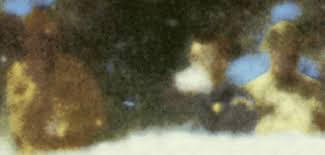
French narcotics trafficker Christian David told researcher Steve Rivelle that Lucien Sarti frequently used costumes and disguises, and during this job had either a Dallas PD or military uniform. Former CIA agent E. Howard Hunt listed Sarti as part of the plot during the final years of his life. With David (and government informant Nicoli), Hunt, Gordon, and this ‘Badge Man’ photo, that’s five separate sources placing (in all likelihood) Lucien Sarti behind the picket fence as a shooter.



When shown this photo for the first time on episode 2 of TMWKK, Gordon identified himself from the tall hat he was wearing that day and the fact he was holding the camera up to his eye. He then became visibly shaken about the fact the picture was showing a shooter behind the picket fence that he expressed regrets about coming forward and giving the interview.

Granted, it’s a blow up of a tiny picture in which the trees and bushes in the background could be made to look like random images, similar to how people see a Christ image on different surfaces. More evidence would be needed to confirm.
Perhaps Tom Wilson’s imaging processing technique can help.
The former US Steel analyzer who found fraud in the case of the Kennedy autopsy photos and calculated the fatal head shot came from a storm drain, applied his technology to the ‘Badge Man’ photo and confirmed the presence of Gordon Arnold and a man firing a rifle behind him.
Any other interesting stories from the ground?
The last one is Beverly Oliver.
Like Mary Ann Moormon, Oliver was on the left side of the limo with her camera and during episode 2 of TMWKK, said she saw smoke and figure near the tree behind the picket fence. She remained quiet about it publically for nearly twenty-five years until the episode aired in 1988. She claimed her camera was taken from her with the promise it would be returned in ten days, but she never got it back.
Why did Beverly Oliver stay quiet for so long?
There’s more to her story than just attending the parade that day.
She worked in the Colony Club which was next to Jack Ruby’s Carousel Club back in 1963. As a normal ritual, performers from the Colony Club would go over to see the performers at the Carousel Club when there act was done, and vice versa. About two weeks before the assassination, Oliver was in the Carousel Club and saw Ruby sitting with one of his performers, a lady known as Jada, but her real name was Janet Conforto.

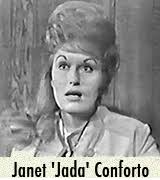
Ruby then introduced a man by the name of “Lee”, who didn’t leave much of an impression on Oliver at the time, but after seeing Ruby shoot Oswald on TV, she realized it was the same “Lee” Ruby introduced as his friend that night. Oliver also made claims she witnessed David Ferrie at Ruby’s club on other occasions.
Ruby then introduced a man by the name of “Lee”, who didn’t leave much of an impression on Oliver at the time, but after seeing Ruby shoot Oswald on TV, she realized it was the same “Lee” Ruby introduced as his friend that night. Oliver also made claims she witnessed David Ferrie at Ruby’s club on other occasions.
Days after the assassination, Jada actually went on television and gave an interview claiming she witnessed Oswald at Ruby’s club (well, that wasn’t too smart).
On November 28th a Dallas PD official wrote a memorandum that a lady who was described as she looked like she was in show business and had the last name Conforto, hit someone named Charles Burns with her white cadillac that had Louisiana plates. The injury wasn’t serious enough to call police and the lady seemed to be in a rush to get to New Orleans.
She was probably running for her life.
As far as Beverly Oliver knew by episode 1 of TMWKK, she heard Jada was dead.
Going To The Movies
Butch Burroughs was working the concession stand at the Texas Theater on the day of the assassination and by episode 4 of TMWKK series he had worked his way up to ticket-collector (moving up fast in the world).
The 1:00pm show that afternoon was “Hell is for Heroes” and he recalled Oswald walking in a few minutes after the film started, about 1:07pm according to Burroughs. The problem with that is the Warren Report has him shooting Officer J.D. Tippit nearly three miles away at 1:15pm, because the time someone radioed for help from Tippit’s police car was 1:16pm.
Poor Butch Burroughs wasn’t able to reach any higher than the Texas Theater in life, does that make him an unreliable witness? Perhaps in a small town someone sticks to one job and that’s it?

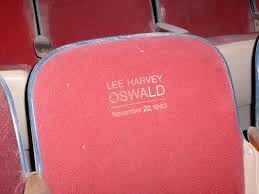
Bob Carroll from Dallas PD was on the scene when Oswald was apprehended and a struggle for Oswald’s gun caused Carroll to hit Oswald over the head. During press conferences at the police station Oswald is seen with a scar over his right eye. Other than that, Carroll described Oswald as cool and calm.
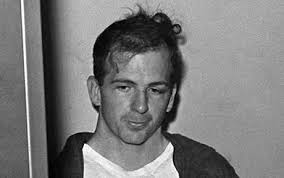
When they took Oswald into custody, he had two different identifications on him; two saying Lee Harvey Oswald and one with the name Alex Hidell. When asked about what was his real name, Oswald responded with, “You’re the cop, you figure it out.”
Jim Leavelle was one of the first policemen to interview Oswald and he denied shooting anyone, the only crime he admitted to was hitting a cop in the mouth during the struggle at the Texas Theater. Just like Bob Carroll, Leavelle felt Oswald was in a calm state of mind. He was left with the impression that most of Oswald’s answers even seemed rehearsed. Specifically on the topic of shooting JFK in relation to Oswald’s Fair Play for Cuba Committee, in episode 5 of TMWKK Leavelle said Oswald’s response was killing Kennedy wouldn’t matter because the Vice President would likely have the same views on Cuba.
Oswald denied shooting Officer Tippit and President Kennedy, no prints were found on the rifle found stashed at the TSBD by Dallas PD or the FBI until three days later when Oswald’s smudged palm print was discovered after Ruby killed him, gun powder tests on Oswald’s hand indicated he fired a gun recently, and the gun powder test on his cheek wasn’t conclusive enough to say he fired a rifle. In all Oswald had been interrogated for 36 hours, yet there are no notes on record on what he was asked or what he answered (Someone forget to bring a notepad?).
When Oswald had a chance to speak to the press, the reporters knew he had been charged with killing the President before he even did. He made the statement, “I hadn’t been charged”, and on camera a reporter is heard correcting him. Cameras also caught glimpses of Jack Ruby stalking his prey at the police station.
Late Night Phone Call
The night before Oswald was shot, Police Communications Officer Billy R. Grammer received an odd phone call at the station about 9pm. The caller wouldn’t identify himself, but warned the police to change the transfer plans of Oswald in the station basement or else, “We would kill him.” Grammer reported the call and went home. After receiving news that Ruby shot Oswald, it dawned on Grammer that it was Ruby who made that phone call as he mentioned on episode 1 of TMWKK. Grammer was one of the many police officers who used to frequent Ruby’s club.
Dallas reporter and friend of Jack Ruby’s, Seth Kantor, said once it was announced in late April 1963 that Kennedy would be visiting Dallas in November, the amount of calls at Ruby’s apartment and his Carousel Club increased 10-20 fold. In the weeks before the assassination, Ruby was meeting up with mob figures he hadn’t seen in nearly twenty years.
In May 1963 Ruby was in New Orleans (Carlos Marcello’s territory) to negotiate with Harold Tannenbaum for a dancer, which likely could’ve been Janet “Jada” Conforto, who could’ve been in New Orleans at that time since she had a April 1963 arrest in that city. Ruby also returned to New Orleans in June 1963 to scout for more talent to work at his Carousel Club. Where these trips to Carlos Marcello’s town to just pick up show girls, or was Ruby there to help plan other things?
Ray Vaughn was the officer put in charge of guarding the ramp entrance the day Ruby shot Oswald and he swears during episode 3 of TMWKK that Ruby did not go past him. The Warren Report says Ruby entered from the ramp. Vaughn took a polygraph test about the issue and past, so that says at least him his mind he didn’t see Ruby go past him. The 1976 HSCA differed from the Warren Report and concluded Ruby entered from an unguarded garage door.
In the same episode 3 of TMWKK, Patrick Dean, who was in charge of security in the garage claims the door was locked and he had two guards positioned there. He says Ruby must have entered from the ramp entrance.
So basically there is no final answer on how Jack Ruby, who was known by a lot by Dallas PD, was able to get into the garage to shoot Oswald.
After Ruby was taken into police custody for shooting Oswald, he was stripped down and placed in the same cell Oswald previously housed. In Episode 1 of TMWKK, Don Archer described Ruby as looking nervous and sweating, even asking Archer for a cigarette. A little after 1pm when Archer informed Ruby that Oswald was dead (and he would be facing the death penalty), but Ruby seemed to relax after knowing Oswald was dead. Archer offered Ruby another cigarette and Ruby responded that he doesn’t smoke. Would seem like the weight of the (under)world was on Ruby’s shoulders for getting rid of Oswald.
The Warren Commission never dug deep into any possible mob ties with Ruby, but one item they did list was a real estate business association with a lady by the name of Bertha Cheek.
Why is that significant?
The sister of Bertha Cheeks is Earlene Roberts, the landlady of the house Oswald was staying at the day Kennedy was assassinated.
Yet the Warren Commission concluded no prior relationship between Oswald and Ruby and no conspiracy to kill President Kennedy. The commission listed Ruby’s shooting of Oswald a spur-of-the-moment reaction, but he was seen stalking Oswald at the police station days before, he corrected reporters at the police station regarding Oswald’s Fair Play for Cuba Committee, he made the threatening phone calls the night before (the Warren Report lists another “unknown” call to the FBI that night), and nobody knows how he was able to slip into the police station basement to shoot Oswald or had knowledge of the transfer plans in the first place.
Part Five: As It Happened – Results
Mary Ann Moorman wasn’t able to make her schedule meeting with the Warren Commission due to an ankle sprain. There wasn’t any rescheduling and she wasn’t asked to testify any further. She is still alive.
Beverly Oliver identified herself as the ‘The Babushka Lady’, seen in most photographs of the limo around the time of the shooting, in 1970. In 1994, she wrote her book about her experience and named Federal Agent Regis Kennedy has the man who took her camera after the shooting. Oliver Stone allowed her to have a brief cameo appearance in his 1991 film “JFK” in a scene at Jack Ruby’s Carousel Club. Many have disputed Oliver’s account since ‘The Babushka Lady’ looks to be a middle-aged woman and Oliver was only 17 at the time. Furthermore, the camera she mentioned she had that day, was not available in November 1963 according to researchers who have analyzed her story. She wasn’t called to testify for the Warren Commission and is currently still alive.
As for fellow nightclub performer “Jada”.
Seth Kantor in his 1978 book, “Who was Jack Ruby?”, mentioned Jada was hired by Ruby from the Sho-Bar in New Orleans after one of his headlines attractions got very sick from peritonitis. She was under contract for the Carousel Club starting from July 1963 that was to last till January 1964. Jada was a popular performer and commanded a top salary, but she would go too far with her act sometimes and Ruby was forced to turn off the lights on her stage. Following some disagreements with Ruby, she quit the Carousel Club during the first week of November 1963 (that conflicts with Oliver’s story who had them all together two weeks before the assassination, not three weeks, unless that’s too small a detail to be picky about?). There is still the Dallas PD memorandum stating she hit someone with her vehicle on November 27th in Dallas, so even if she quit the Carousel Club at the beginning of the month, she could’ve well still been in town for most of the month.
In 1980, a 44 year-old Janet Conforto was riding her motorcycle in Albuquerque, NM and fatally collided with a school bus. She married quite a few times in her life and by the time she died her full name was Janet Mole Adams Bonney Cuffari Smallwood Conforto Washington.
Although it’s yet another dead person who could potentially speak of a conspiracy, her death was nearly twenty years after the assassination and she did seem to have a wild lifestyle that would befit getting into a fatal motorcycle accident. Had her death occurred as she was about to testify before a committee, that would raise suspicion of foul play more than what occurred.
As for Jack Ruby’s polygraph examination given by the Warren Commission, here are the highlights of how he responded:
- Didn’t know Oswald prior to November 22, 1963.
- Didn’t plan on shooting Oswald until the morning of November 24, 1963.
- Didn’t make any threatening calls or have knowledge of threatening calls made to the FBI and Dallas Sherriff’s office before Oswald was killed.
- Was at the police station in previous days when Oswald was present, but didn’t carry a gun.
- Shot Oswald to save Jackie Kennedy the ordeal of going through a murder trial.
- Didn’t shoot Oswald to silence him.
- Wasn’t familiar with Officer J.D. Tippit and neither Tippit nor Oswald were ever at his club.
- Entered the basement through the ramp entrance.
- Was not part of any plot to overthrow the government.
- Was not part of any underworld plot.
- Was not part of any labor union plot.
- Was not part of any communist plot.
- Never did business with Castro’s Cuba and his trip there was for pleasure.
Since polygraph tests are not accepted for trials, the results of Ruby’s answers are not divulged. Ruby was sentenced to death in the murder of Oswald, and three years later before an appeal trial died of lung cancer in 1967.
Part Five: Lee Harvey Oswald
Working With Mice
It’s only fitting to dedicate a whole section to Oswald because he has come under the most speculation whether he acted alone or was part of a big conspiracy. He bounced around a lot in his lifetime from the Civil Air Patrol, to the Marines, to a military base in Japan, discharged from the Marines, enters Russia, renounces his US citizenship, marries a Russian bride, works in a Russian factory, returns to the US (Dallas area), goes to New Orleans to start the Fair Play for Cuba Committee, travels to Mexico City, returns to Dallas, accused to killing Kennedy, shot dead by Ruby. Since the typical person doesn’t have this type of resume, it has opened the door to speculation that by the time he was discharged from the Marines he was some type of CIA agent or government spy. Although the Warren Commission described him as a troubled youth who did poorly in school, by the time he was in the Marines he was speaking fluent Russian. Seems inconsistent for someone who did poorly in school to be able to pick up a new language and a new alphabet without intensive CIA-style intelligence training on the subject.
Oswald was also said to have been critical of capitalism and praised communism during his time in the Marines, which irked fellow soldiers. By this time it was the late 1950’s and the height of the Cold War, people in Hollywood were being blacklisted for even suspicion of communist ties, yet Oswald was allowed in the US military while promoting the words of Karl Marx? In today’s terms it would be like a Marine praising Al Qaeda and allowed to keep serving, it just doesn’t add up, unless the Karl Marx talk was just an Intelligence ploy to launch Oswald’s resume as a communist sympathizer.
There are plenty of Oswald tales to explore, but to start off the most outrageous of them all came from episode 8 of TMWKK as told by Judyth Vary Baker. She claimed she had a love affair with Oswald and the two of them were originally in a plot to kill Castro, but plans changed and Oswald was instead used as a patsy in the murder of Kennedy. Her account as received as much criticism as Madeleine Brown’s story about being LBJ’s mistress and attending a party of plotters the night before the assassination, but there’s also a brilliance and sophistication to this story that its worth at least telling.
Baker was from Florida and was a star science student at Manatee High-School. She specialized in cancer research which drew attention from the local media, and Baker was able to produce the news articles that helped her secure grants for her lab work. Her sister, Linda Bauer, also appeared in the episode to back up Judyth’s story. Her specialty was that she found a method to give lung cancer to lab mice faster than ever achieved before. This of course caught the US military’s attention that was in competition with the USSR in the field of bio-germ warfare.
1961, after high-school, Baker was sent to the Roswell Park Memorial Institute under the direction of strong anti-communist Dr. Alton Ochsner, who was following Baker’s studies, but hadn’t met her yet. Ochsner was a leading cancer expert in the US and was one of the first to find a link between smoking and cancer. From there she made her way to the University of Florida as a full-time student in 1962 and claimed she was drawn into a research on deadly cancers. By 1963, she was invited to work with a lady by the name of Mary Sherman in Dr. Ochsner’s lab in New Orleans on a temporary assignment.
Baker arrived in New Orleans on April 20, 1963 (somewhat strange she recalled the exact date, but she did seem to be a brilliant student, or it all could’ve been rehearsed). She was 19 at the time and her fiancé, Robert, was to meet her there ten days later. On a trip to the post office to pick up a letter from Robert, she accidently dropped her newspaper and a kind gentleman picked it up for her.
Guess who that was?
Yes, Lee Harvey Oswald.
After a little small talk, Oswald even walked her home.
Since Baker was new in town and it was going to be a few more days till her husband was to arrive, she relied on Oswald to show her around. One such place Oswald took her was to a restaurant to meet ‘Doctor’ David Ferrie, although the guy was wearing a pilot’s uniform for Eastern Airlines.
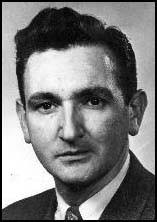
She found Ferrie well versed in many different subjects, he even was familiar with Dr. Ochsner and Mary Sherman. Ferrie said he was even working on his own cancer research project and invited Baker over to his apartment. The night she visited Ferrie’s place, Ferrie revealed more that he was working with Ochsner and Sherman on a top secret medical project to be used against Castro.
She found Ferrie well versed in many different subjects, he even was familiar with Dr. Ochsner and Mary Sherman. Ferrie said he was even working on his own cancer research project and invited Baker over to his apartment. The night she visited Ferrie’s place, Ferrie revealed more that he was working with Ochsner and Sherman on a top secret medical project to be used against Castro.
At a party at Ferrie’s place, Baker encounter a lot of strange characters, as she described them, making all sort of wild claims about killing Castro. She felt unnerved and asked Oswald if these people were for real or not. To satisfy Baker’s concerns, Oswald took her to meet Guy Bannister, and the former head of the FBI’s Chicago office confirmed they were all in a plot to remove Castro. Baker was anti-Castro, so this all fit in well with her. Oswald even took Baker to the 3rd floor of Bannister’s building which had all sorts of military equipment, and said he was involved in training young Cubans. The more time Bakers and Oswald were spending together, the more they were falling in love. Baker had only known her fiancé for ten months and was having more feelings for Oswald, but ultimately Baker backed off when Oswald admitted beating his current wife, Marina, which he expressed regret about.
Robert did arrive in New Orleans and did get married to Judyth, but his job forced him to leave immediately and she was left alone again in New Orleans.
It was finally time for Baker to meet Dr. Ochsner and Oswald accompanied her. Oswald actually went in to speak with him first, which gave her the impression they knew each other. Then when Baker entered the room, Ochsner told her that the project was to find a way to get Castro very rapidly. Since a violent overthrow of Castro by military force could provoke Russia to enter the fight, this method would look like Castro died naturally.
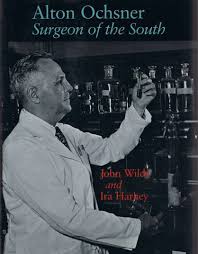
Baker didn’t like Castro and felt it was a noble cause to prevent a wider scale war with Russia, so she agreed to join. Her reward, according to Ochsner, was that she would skip the rest of her study at the University of Florida and have immediate acceptance into Tulane Medical School.
Baker didn’t like Castro and felt it was a noble cause to prevent a wider scale war with Russia, so she agreed to join. Her reward, according to Ochsner, was that she would skip the rest of her study at the University of Florida and have immediate acceptance into Tulane Medical School.
Both Oswald and Baker were provided cover jobs at the Reily & Co. coffee company (Baker was even able to display paystubs and tax records that she worked there).
Her real work was performed at Ferrie’s apartment in which there were 50-60 mice there at a time and she sought a quick forming cancer. She could use her background in giving mice cancer, cut out the fastest growing tumors, and blend them together. Reports and updates were provided to Mary Sherman at her apartment. Oswald himself, not Baker, would transport materials to Mary Sherman at her location in at the US Public Health Center. From there, culture samples were genetically altered and returned back to Baker for her to take additional steps in her project. Baker taught Oswald on how to handle the materials properly during these trips.
One on occasion at the apartment, Baker told Ferrie about a naughty dog she used to have called Sparky, in which Ferrie replied that she’ll meet another Sparky who was also a dog would couldn’t control himself.
This turned out to be Sparky Rubinstein, aka, Jack Ruby.
Wow, she’s meeting everybody.
Sparky was Ruby’s nickname from his early days as a boxer which stuck with him. Ruby was the shortened version for Rubinstein which occurred with many Jewish last names.
Sparky was Ruby’s nickname from his early days as a boxer which stuck with him. Ruby was the shortened version for Rubinstein which occurred with many Jewish last names.
Ruby was interested in their research and spoke a lot with Oswald, it gave her the impression they knew each other for a long time. Ruby also made the comment that he’s known Oswald since he was a little boy.
Baker and Oswald were only seven blocks away from each other, so when Oswald would have a fight with his wife Marina, Oswald would go to Baker’s to calm himself down. They saw each other every day as they rode the bus to their cover job at the coffee company, and since both seemed to be in disappointing marriages, they started to lose their control of remaining faithful to their spouses.
A friend and colleague of Dr. Ochsner, New Orleans businessman, Clay Shaw (might as well toss him in this story too), felt sorry for their situation and would set them up in fancy hotels so they could be alone together (why couldn’t they just do it at Baker’s place?).
As Baker and Oswald’s love affair grew, the cancer project was not. They wouldn’t able to find a cancer potent enough, so Baker recommended another angle: find a way to pull down the subject’s immune system, this way the treatments and radiation from X-rays would do the killing for them.
While this new method was being developed, Baker said Ferrie was put on assignment to infiltrate a group that was planning to kill JFK for not taking military action against Cuba, while Oswald was assisting Bannister to find pro-communist students on college campuses. In addition, it was around this time Oswald was being groomed as pro-Castro to allow him to have access to Cuba. Since the coffee company couldn’t have a known communist working for them, Oswald was fired from the cover job. He then had his pro-Castro publicity increased from handing out pamphlets (Fair Play for Cuba Committee), and making both radio and television appearances.
Eventually Baker developed a substance that should’ve worked and it was time to test the cancer virus.
What?
Prison “volunteers” from the Angola Penitentiary in Louisiana were to be driven to a mental institution in Jackson to receive the injections. Baker was horrified at this idea and wrote a note to Dr. Ochsner that she didn’t like it. Ochsner called Baker and expressed his anger for her writing these things on paper and reminded her that both she and Oswald were expendable.
So it was on with the human guinea pigs.
In August 1963, Clay Shaw (another opportunity to include him in the story) drove Oswald and Ferrie in his black cadillac 130 miles from New Orleans to Clinton, where they were to meet up with the prison bus of Angola prison volunteers on way to the Jackson mental hospital. Oswald knew how to handle the materials from Baker, and Ferrie, who had medical research experience of his own, was to instruct the doctors at the mental hospital on how to give the injections.
If the test was a success, Oswald told Baker he was selected to take the materials to Mexico City, where it would be handed off to a contact who will be able it into Cuba and in the hands of a dissenting doctor on Castro’s medical staff, who was going to inject him with it.
Oswald took Baker to the mental hospital and the test proved successful on one volunteer only 72 hours after he was injected.
She still had misgivings about the use of humans for tests, and Ochsner was still upset with her over her note, so he took back his Tulane promise. This left Baker with no choice but to distance herself from the group and go back to Florida where she would eventually be joined by her husband.
Baker and Oswald met in person one last time at a hotel in September 1963. By this time the mental hospital test subject had died and Oswald was preparing for his trip to Mexico City. They both realized they were in neglectful marriages and parted ways in hopes they would both break up and be able to marry each other in the future.
Regarding Oswald’s trip to Mexico City; he took the materials on a bus with him and was supposed to meet his contact at a gift shop, but the contact never showed. His CIA contact, who went by the codename ‘Mr.B’, wasn’t there either. With no other options, Oswald tried to get a visa to travel to Cuba to deliver the materials himself, but was denied. By October Oswald had returned to Dallas, and the destruction caused in Cuba from Hurricane Flavia put the cancer project on hold.
Oswald was provided a new assignment and given a cover job at the TSBD, the same way he was supplied with a cover job at the Reily coffee company. Ferrie was able to use his mob connections in Dallas and the racing betting lines they had, to set up a secure phone line for Oswald in Dallas and Baker in Miami. She said they had about fifteen of these calls and each one would get more and more serious. Oswald was penetrating a circle he was introduced to by Clay Shaw and Ferrie that wanted to kill Kennedy, and in order to gain their acceptance, Oswald acted like he too wanted to kill the President.
The assassination was to take place in one of three places; the airport, Dealey Plaza, or the Trade Mart. Oswald was to receive a phone call at the TSBD around lunchtime to either stay there or move to one of the other locations. On November 17th, Oswald told Baker he wasn’t afraid to die, but felt bad for his children because he knew there was the likelihood he would get blamed. He left hope that he might somehow be able to save the President’s life. Days later Baker left a message for Oswald at the TSBD and that night on November 20th, they had their last call. He mentioned he had 2-3 others with him on this mission and he was in too deep to pull out. He gave Baker some information that he wanted her to remember. He claimed Billy Sol Estes and Bobby Baker (no relation to Judyth or her husband Robert), both business associates of LBJ, were behind the attack. He mentioned those two were being investigated and they could possibly drag LBJ down with them to jail. In addition, he told her his CIA handler who went by the codenames ‘Mr. B’, ‘Mr. Benton’, and ‘Mr. Bishop’, was no other than David Atlee Phillips, a CIA official for covert action located in Mexico City.
Two later the assassination happened and Oswald was charged with the killings of Officer J.D. Tippit and President Kennedy. When Baker saw Oswald on television, she noticed he looked like he lost weight since she last saw him (probably was under a lot of duress).
Baker received a call that night from Ferrie who claimed things went wrong, but promised to get Oswald out of the jam (maybe that’s why Oswald was acting so cool at the police station). He was going to travel to Houston, meet up with Oswald (somehow, even though he was in police custody), and fly him to Laredo, TX. If not, Ferrie said he would at least find out what was going to happen to Oswald.
Oswald was eventually shot and killed on television by Jack Ruby.
Two weeks after Oswald died, she received another call from Ferrie that she needed to keep quiet about the whole thing or else she was dead. In addition, she was not to pursue her research or career into cancer any further; that meant no more articles in the news, no good grades at school, nothing that would put her in the public eye. Ferrie warned that New Orleans mob boss Carlos Marcello was going to have his friend and Florida mob boss Santo Trafficante keep an eye on her.
Judyth Vary Baker said she kept this secret hidden from her family for nearly forty-years and wanted her children to grow up before telling it.
This was the ultimate ‘too good to be true’ story, and since this was episode 8 of TMWKK and episode 9 covers the LBJ-Bobby Baker-Billie Sol Estes story, this looked like the perfect set-up for the next episode. JFK conspiracy buffs could likely shred this story a part, so I won’t spend time getting picky about it, but she was able to produce news clipping of her success as a young student in the field on cancer research as well as the documents to show she worked at the Reily coffee company. I just found it hard to believe from the start when she was at the post office, dropped her newspaper, and Oswald was right there to pick it up. Unless he was tailing her around town and looking for an opportunity to start a conversation, it’s just too perfect. If she was this brilliant student in her youth, it seems uneven and too random for her to cook up a wild story like this forty-years later, but too much of it seems like it was put together after seeing the other episodes of TMWKK and the 1991 “JFK” film. The only basis of reality there seems to be is how Oswald could’ve been drawn in to think he was preventing an assassination, but instead ended up as the patsy.
Just as Oswald’s mother and his wife Marina claimed, Baker stated Oswald was a hero and served his country to the very end as a Marine.
Lee Harvey Oswald’s brother, Robert, doesn’t buy into the fact he was this heroic patsy, as he mentioned on a recent program aired by the History Channel (which used to air TMWKK series) about the assassination, that if he had any evidence to prove his brother’s innocence, he would’ve tried to clear his name. Robert Oswald says there is nothing to dispute that his brother did the killing and acted alone.
In 2009, Oswald’s former wife Marina told Jesse Ventura on his show “Conspiracy Theory with Jesse Ventura” that she believed Lee Harvey Oswald was some sort of low level CIA operative.
More Than One Oswald
In addition to being part of the CIA’s mind altering program MK-ULTRA, which CIA Director Richard Helms ordered all documents on destroyed in 1973, other researchers have looked into the possibility Lee Harvey Oswald was involved in a body-double program with someone who looked just like him.
Let’s go to the measuring sticks.
The Warren Report lists Oswald in twelve difference instances as being 5’9’’. This includes his employment applications, such as the TSBD, and his arrest street from August 1963 in New Orleans when he got into a street scuffle with anti-Castro Cubans. On his documents after his military service such as his Marine discharge and his passport to enter Russia, he is listed as 5’11’’. On the day Oswald was taken into police custody for the assassination, FBI agent James Hosty states Oswald dropped his wallet at the Tippit murder scene and in the wallet he was carrying a 1959 Marine Selective Service System Registration card and a Department of Defense Identification Card listing his height as 5’11’’. Also discovered in this wallet that day was a counterfeit Selective Service System Registration card under the fake name ‘Alek James Hidell’ with the listed height of 5’9”.
When Oswald was in Russia and had an adenoid operation in Minsk, his hospital files display a range of names; ‘Harvey Alik Oswald’, ‘Harvey A. Oswald’, and ‘H.A. Oswald’, nothing with the name ‘Lee’ in it. On the other side of the coin, Oswald entered his name as ‘Harvey’ in his half-brother John’s address book, the weird thing about that is a Marine who served with Oswald, J.E. Pitts, recalled that Oswald would get mad at anyone who referred to him as ‘Harve’ or ‘Harvey’.
Author John Armstrong in his 2003 book ‘Harvey and Lee’ had the hypothesis of an intelligence program involving two teenage boys. One named Lee Oswald from Texas, and a Russian-speaking boy named Harvey Oswald from New York. The goal was to switch their identities and send the Russian-speaking one into Russia.
Armstrong found alarming evidence of such a possibility.
New York courts have a ‘Lee Oswald’ in school the same time a ‘Harvey Oswald’ is in school in Stanley, ND. When Oswald was serving in the Marines and stationed in Japan, records show another Oswald was working at Pfisterer Dental Lab in New Orleans. On the day of the assassination, the FBI went to Stripling High-School in Dallas and seized all of Oswald’s records, but the years of records they took were during times Assistant Principal Frank Kudlaty recalled Oswald was attending a different school (thousands of kids passing through the school and he’s gonna remember that detail?).
It’s Armstrong’s belief that the goal of the two Oswalds was to have the Russian-speaking Harvey hidden in Russia while the Texas Lee one was in New Orleans building himself up as communist with a series of acts and working with CIA handlers, all to frame the Russian Harvey. Then for the actual assassination, ditch Lee somewhere and have the Russian Harvey inserted in to take the blame.
Most of this theory is based on paperwork and it stands to believe some relative would’ve spoken up if they didn’t recognize the person known as Lee Harvey Oswald. When Oswald was in police custody, his brother Robert had to answer solve their puzzle whether the formal name was Harvey Lee Oswald or Lee Harvey Oswald, he told them it’s Lee Harvey Oswald.
Any signs that Lee Harvey Oswald was planting his name around?
During episode 4 of TMWKK series a few people from the town of Jackson had experiences with Oswald. One such was barber named Edwin Lea McGehee. He said Oswald came in asking for a haircut, even though it didn’t look like he needed one. The barber recalled that Oswald made pointed statements, as if he was going out of his way to make an impression so he would be remembered. He said Oswald asked if there was any work in town, and McGehee said the only big thing around was the local mental hospital. On hearing about the mental hospital, Oswald lighted up with excitement, and McGehee suggested he speak to State Representative Reeves Morgan nearby about getting a job at the hospital.
In Judyth Vary Baker’s story, a mental hospital in Jackson was used to test out her cancer virus on Angola prisoners.
When Oswald arrived at Reeves Morgan’s doorstep he asked if there were any positions opened at the hospital. After Morgan recognized Oswald’s face on television after the assassination, he contacted the FBI to tell them Oswald was in Jackson. Their reply was they already knew about his trip to Jackson, and that was it. Nobody came to Jackson to ask any questions.
In New Orleans, the supposed communist fanatic spend his lunches while working at the Reily coffee company in Adrian Alba’s Crescent St. garage.
What was so unique about this garage?
The nearby offices of the Secret Service and the Office of Naval Intelligence had their vehicles serviced there. Oswald would come into Adrian Alba’s office and read the gun magazines (the FBI tried to say Oswald took an ad from a June magazine to order the rifle, but it was actually a February issue). Perhaps Oswald was trying to make an impression on any agents who would come into the place that he was a big gun enthusiast. Guy Bannister’s office was across the street from these intelligence offices, which was also the same building Oswald addressed his ‘Fair Play for Cuba Committee’ leaflets on.
There was the street scuffle with anti-Castro Cubans that gave Oswald publicity, as well as a televised debate with one of those Cubans on local television shortly after.
As for Oswald being set up as a patsy during the assassination.
One co-worker Harold Norman told the Warren Commission he saw Oswald on the 1st floor thirty-minutes before the motorcade was scheduled to pass by the TSBD. Another co-worker Carolyn Arnold claimed she spoke with Oswald on the 2nd floor in what she phrased as “moments” before the shooting.
Researcher Robert Groden pointed out during episode 4 of TMWKK that the motorcade was running late as the President was supposed to be at the Trade Mart lunch by 12:30pm, but by that time they were just passing by the TSBD. Oswald wasn’t logged onto his Twitter or Facebook account at the time, so there was no way for him to know the parade was running late. If he was the shooter he would have not been on the 2nd floor to speak with Carolyn Arnold, he would have been up on the 6th floor wondering what was holding up the motorcade.
Taking the ’moments before the shooting’ comment from Carolyn Arnold on the 2nd floor, and the fact Officer Barber and building superintendent Roy Truly discovered Oswald in the 2nd floor break room in two minutes after the shooting, there’s the strong possibility Oswald was on the 2nd floor during the entire assassination event and didn’t fire any shots. For him to have done so, he would’ve needed to rush up four floors, shoot the President, ditch the gun, and go back down four floors to be found by Barber and Truly, all in less than two minutes, impossible! As suggested by Jim Garrison’s character in the film “JFK”, perhaps Oswald was instructed by his handler to wait in the break room for a phone call with instructions, to either participate in the assassination, or prevent it. But the call never came. Something must have gone wrong. Soon enough, Oswald realized he had just been set up to take the fall.”
No witnesses inside the building saw Oswald do the shooting, and no witnesses saw him going up or down floors near the time of the shooting. The only witnesses to a gunman were outside the building where it would be near impossible to positively identify the shooter as Oswald from that distance.
At the Texas Theater, Butch Burroughs had Oswald pegged as entering around 1:07pm as other witnesses had Oswald shooting Officer J.D. Tippit at 1:15pm. Was the theater a pre-determined meeting point for both Oswalds after the assassination took place? Were these two different Oswalds entering the theater? Maybe it was another Oswald, who was running late due to the Tippit incident that was seen entering the theater without buying a ticket which caused a staff member to call the police.
Burroughs has more.
While the police had their big perp-walk by taking Oswald out the theater’s entrance through an angry crowd out front, Burroughs said another man who looked just like Oswald, like a brother or something, was arrested and taken out the back of the theater.
Bernard Haire of Bernie’s Hobby House, two doors down from the theater, said he saw the police bring a young white man dressed in a pullover shirt and slacks out of the rear entrance of the theater where he was put into a car and driven off.
Could’ve just been a random heckler who was interfering with police business.
The best indication of multiple Oswalds actually occurred after Lee Harvey Oswald died.
Miller’s Funeral Home was selected to handle Oswald’s remains after he was killed on Sunday November 24, 1963. To that point no prints were found of the rifle stashed on the 6th floor of the TSBD. Funeral Director Paul Groody started preparing Oswald’s body that night around 11pm, and as he explains during episode 4 of TMWKK, in the early hours of November 25th, agents came in to take finger and palm prints of Oswald’s corpse.
Later that day it was announced Oswald’s smudged palm print was found on the rifle.
Three weeks after Oswald’s burial, Groody was visited by agents again and they were interested to know if he noticed any scars on his wrist as he was preparing Oswald’s body. Oswald supposedly attempted suicide in Russia when he was forced to leave due to his visa running out, by slashing his wrist. Groody wasn’t able to recall such a scar since he didn’t think to look for it in the first place. According to Groody, the reason the agents were concerned about the body buried out in Rose Hill Cemetery was that, “We don’t know who we have in that grave.”
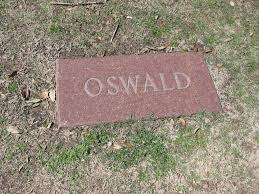
Parkland Hospital administrator, C.J. Price, was contacted by Dallas FBI agents asking if he observed any scars on Oswald’s wrist while the body was there for the autopsy. Price answered no and said nobody else saw such a thing either, as far as he knew. CIA Director Richard Helms was kicking up a storm to find out about that wrist scar and wanted the FBI to exhume the grave.
There was much speculation about who was buried in the grave and Oswald’s wife Marina feared the body might’ve been snatched, so by 1981 she ordered it exhumed to see if her husband was still there. Paul Groody was still in business, but Miller’s Funeral Home had been bought out by Baumgardner, Inc., Groody handled the remains as it made its way to Baylor for pathologists to run a dental identification test. Their conclusion was that beyond any shadow of a doubt, the body in that grave was indeed Lee Harvey Oswald.
So is that the end of that debate?
Not so fast.
Paul Groody said that in 1963 he placed Oswald’s casket in a steel-reinforced concrete vault that was guaranteed not to crack or break. When the grave was dug up in 1981, the bottom of the vault was broken and as a result the casket looked deteriorated and disturbed (perhaps the vault was made in China). Inside the casket, the body had the same clothes Groody recalled dressing Oswald with, but there was one detail that stuck out.
After Ruby killed Oswald, Oswald’s body had an autopsy performed on it, and part of an autopsy is the skull is opened up for the brain to be removed. A distinct cut it made across the top of the scalp to open up the head, and Groody recalled this scar while preparing Oswald’s body for burial in 1963. The skull Groody saw in 1981 when they exhumed the body did not have this basic autopsy mark. Based on this, it is Groody’s belief that between the years 1963 and 1981, someone cracked open the vault to get at the body inside the casket, then replaced the head.
Oswald was buried in a new casket in his same plot. Baumgardner, Inc. kept the old casket stored in their funeral home.
Part Five: Lee Harvey Oswald – Results
After her appearance on TMWKK, Judyth Vary Baker said she was fired from her job as a teacher and received a lot of harassment as well as death threats. She also claimed a mysteriously white van was stalking her and one-time even tried to kill her while she was crossing a street.

She moved to the Netherlands where she deals in art, makes appearances at Kennedy conspiracy functions, and frequently releases videos on YouTube. On her website there is an option for people to donate money to help pay her bills……which doesn’t exactly help her ‘over-the-top’ story seem very valid.
Dr. Alton Ochsner started to pick up on the effects smoking had in causing cancer from soldiers returning from World War I who smoked. The Ochsner Clinic, which he co-founded, was one of the first to document the link between cancer and cigarette use. Today the clinic is known as Ochsner Foundation Hospital and is a highly-reputable medical facility.
As for Ochnser’s politics.
The FBI maintained a file on Ochsner and it was recently released under the Freedom of Information Act. It shows that Ochsner had a long relationship with various U.S. government agencies. Ochsner also developed a close friendship with Clint Murchison who helped fund various right-wing organizations.
In 1961 Ochsner, with the financial help of Clint Murchison, established the Information Council of the Americas (INCA). Ed Butler was appointed as Executive Director of INCA. The main objective of the organization was to prevent communist revolutions in Latin America. Ochsner told the New Orleans States Item: "We must spread the warning of the creeping sickness of communism faster to Latin Americas, and to our own people, or Central and South America will be exposed to the same sickness as Cuba."
Edgar and Edith Stern, owners of WDSU radio and television, were members of INCA. Eustis Reily of the Reily Coffee Company personally donated thousands of dollars to INCA (Judyth Vary Baker claimed she and Oswald were provided cover jobs at Reily’s coffee company). Edward Haslam argues in “Dr. Mary's Monkey” that ‘Ochsner's hospital was one of the 159 covert research centers which the CIA had admitted to setting up.’ Haslam believes that Ochsner recruited Mary Sherman to run the research operation. The basic project was set up March 23, 1962, using conventional facilities, which then expanded out of the loop for its final phases. Haslam believes that Sherman was involved in carrying out secret research into developing a vaccine to prevent an epidemic of soft-tissue cancers caused by polio vaccine contaminated with SV-40. This work included using a linear particle accelerator located in the Infectious Disease Laboratory at the Public Health Service Hospital in New Orleans. According to Haslam there was a second-lab working on this project. This was being run by David Ferrie on Louisiana Avenue Parkway.
Ochsner was also associated with Clay Shaw. Ochsner was president of the International House, whereas Shaw was director of the organization. Both men were also directors of the Foreign Policy Association of New Orleans.
When Jim Garrison went after Clay Shaw for JFK’s murder, In his article, “Social Origins of Anticommunism: The Information Council of the Americas”, Arthur Carpenter claimed that Ochsner launched a propaganda campaign against Garrison.
Dr. Alton Ochsner died in September 1981.
Mary Sherman was murdered on July 21, 1964. She had been stabbed in the heart, arm, leg and stomach. The crime has never been solved and one bizarre detail was her mattress was set on fire, but the burn discovered on her body was inconsistent with that of a blazing mattress. Edward Haslam in his book suggests her burns came from one of her top secret lab procedures that backfired. Sherman's death occurred on the day the Warren Commission came to New Orleans to obtain testimony from witnesses in that city.
David Atlee Phillips, named by Judyth Vary Baker as someone Oswald told her was his CIA handler, was also named by former CIA agent E. Howard Hunt as one of the conspirators involved in the plot to kill Kennedy during his deathbed confessions period.
Any other suspected CIA handlers for Oswald worth mentioning?
Oh yeah, George de Mohrenschildt. Just call him George.
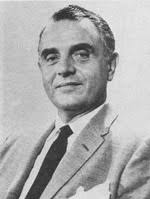
George was a Russian-born petroleum geologist who befriended the Oswalds in 1962 through contacts in the Russian community. Marina always felt it was strange that George took an interest in them since they were so poor and he was quite wealthy. George wanted to help Oswald find a job and introduce them to the rest of the community, but before doing so, George reached out to J. Walton Moore who George knew since 1957, and according to a CIA classified document obtained by the HSCA, was an agent of the CIA's Domestic Contacts Division in Dallas. Moore assured George that Oswald was clear to associate with and help out. George testified to this to the Warren Commission, and his questioning segment was the longest on record.
When testifying to the HSCA in 1978, J. Walton Moore denied that Oswald conversation took place.
On April 13, 1963, three days after Oswald's alleged attempt on the life of conservative activist General Edwin Walker at his home in Dallas (for which the police had no suspects), the de Mohrenschildts visited the Oswalds' apartment. George, aware of Oswald's stated dislike for Walker, joked to Oswald, "Hey, Lee! How is it possible that you missed?"
In 1967, New Orleans District Attorney Jim Garrison interviewed the de Mohrenschildts as part of Garrison's prosecution of Clay Shaw. Garrison said that both de Mohrenschildts insisted that Oswald had been the scapegoat in the assassination of President Kennedy. Garrison concluded from his conversation with the de Mohrenschildts that George had been one of Oswald's unwitting "baby-sitters" ... "assigned to protect or otherwise see to the general welfare of.
What really makes George de Mohrenschildt interesting is in the years after the assassination. He went through a number of nervous breakdowns and his wife even had him committed to an institution for a while. The de Mohrenschidts mysteriously divorced in secret in 1973, but maintained a public life that they were still married. He believed forces were out to get him, specifically the CIA, the FBI, and the even the Jewish Mafia, so he contacted the Director of the CIA at the time, George H.W. Bush.
George de Mohrenschildt wrote:
You will excuse this hand-written letter. Maybe you will be able to bring a solution to the hopeless situation I find myself in. My wife and I find ourselves surrounded by some vigilantes; our phone bugged; and we are being followed everywhere. Either FBI is involved in this or they do not want to accept my complaints. We are driven to insanity by the situation. I have been behaving like a damn fool ever since my daughter Nadya died from [cystic fibrosis] over three years ago. I tried to write, stupidly and unsuccessfully, about Lee H Oswald and must have angered a lot of people — I do not know. But to punish an elderly man like myself and my highly nervous and sick wife is really too much. Could you do something to remove the net around us? This will be my last request for help and I will not annoy you any more. Good luck in your important job. Thank you so much.
George H.W. Bush wrote back:
Let me say first that I know it must have been difficult for you to seek my help in the situation outlined in your letter. I believe I can appreciate your state of mind in view of your daughter's tragic death a few years ago, and the current poor state of your wife's health. I was extremely sorry to hear of these circumstances. In your situation I can well imagine how the attentions you described in your letter affect both you and your wife. However, my staff has been unable to find any indication of interest in your activities on the part of Federal authorities in recent years. The flurry of interest that attended your testimony before the Warren Commission has long subsided. I can only speculate that you may have become "newsworthy" again in view of the renewed interest in the Kennedy assassination, and thus may be attracting the attention of people in the media. I hope this letter had been of some comfort to you, George, although I realize I am unable to answer your question completely. George Bush, Director of the Central Intelligence Agency. [CIA Exec Reg. # 76,51571 9.28.76]
The exchange in itself doesn’t say much, but the idea an old friend of the man accused to killing JFK had access to contact the Director of the CIA, Bush, and get a response back! That should raise a few eyebrows. Imagine if a friend of one of the 9/11 hijackers reached out to the current Director of the CIA and received a legitimate response back?
A few last George H.W. Bush notes; although he was appointed Director of the CIA by President Ford in 1976, he says he was not in the CIA during 1963.
Do you remember where you were when you first heard about the 9/11 attacks?
Everyone does.
The Kennedy Assassination is the same thing. Everyone remembers where they were when they first heard the news.
Everyone, except George H.W. Bush that is. Darn it, just can’t account for his whereabouts when one of the biggest news stories of all time was released.
A photo taken in front of the TSBD after the shooting shows a man in a suit that bears a striking resemblance to the former 41st President of the United States which has entered the conspiracy theory realm.
George de Mohrenschildt received a business card from a HSCA investigator that was interested in speaking with him, but later in the day George was found dead due to a blast to the head from a shotgun. The death was ruled a suicide.
Jeanne de Mohrenschildt also gave the HSCA committee a copy of a manuscript called “I Am a Patsy! I Am a Patsy!” which George had recently written about his relationship with his "dear, dead friend" Oswald, wherein he said that the Lee Oswald he knew, while capable of violence and petty meanness, would not have been the sort of person to have killed John F. Kennedy
Oswald’s wife Marina had some skepticism about who was in the grave, or if anyone was in the grave, but no family members for either supposed ‘Oswald’ have ever come forward claiming any such ‘multiple–Oswald’ scenario might’ve existed.
Mortician Paul Groody died on Oct. 12, 2010 at the age of 91. Who says being an undertaker doesn’t pay?
As for Oswald’s old casket?
It’s been sold!
Nate D. Sanders Auctions sold it to an anonymous bidder (which wasn’t a museum) for $87,468 in December 2010. Makes for the perfect Christmas gift.
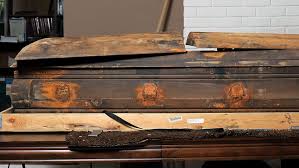
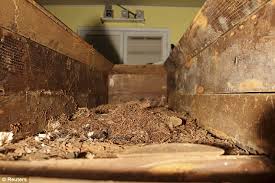
Allen Baumgardner, who assisted at the exhumation, kept the old coffin in a funeral home storage room. He decided to sell the coffin because he was 68 years old and, "I just felt it was time to let it go."
Other items sold were the "Lee Harvey Oswald Death Certificate" for $49.734; the "Lee Harvey Oswald Porcelain Embalming Table" for $2,507; the "Lot of Oswald Medical Instruments" for $4,037; and seven other lots, for a total list price of $161,336.
I could’ve afforded the Porcelain Embalming Table at least.
Another item sold was a piece of the leather interior of JFK’s limo, which then contradicts the story that the interior of the limo was stripped at a Ford plant in Michigan days after the assassination.
Lee Harvey Oswald’s brother, Robert, claimed he had no idea the old casket was still around after his brother’s body was exhumed in 1981 and reburied in a new coffin. After finding out about the auction, he took out a lawsuit against Baumgardner, Inc. for the $160,000 amount of profits earned from the auction.
Part Six: Conclusion
SOB Story
The JFK conspiracy has become one of the most written about topics with over a thousand books and counting published. With conspiracy always a better seller than stability, there has been an oversaturation of theories as everyone is jumping on board to make a buck. This has caused theories to overlap and compete with each other, and usually the legitimate stories have been drowned out by the fairy tales. These days, authors and researchers are spending more time discrediting each other’s theory as everyone thinks they’ve unlocked the magic box with the answer. Meanwhile all this does is strengthen the Warren Report and the government’s stance that there was no foul play involved. As the assassination is about to reach the fifty-year anniversary, no one has yet to provide a substantial piece of evidence to prove conspiracy. Items such as a juicy story someone tells, an old CIA document, or the direction of Kennedy’s head going ‘back and to the left’ is very provocative, but it’s not exactly evidence as those are all open to interpretation.
What has opened the door to all these stories and theories is that the government never brought a solid case against Lee Harvey Oswald being the lone assassin. When agencies such as the CIA and the FBI hide information, when government inquiries such as the Warren Commission and the HSCA pick and choose who gets to testify, and when documents are locked away to not be released until 2017, 2028, 2049, it only leads people to believe that the government has something to hide. With the internet providing a platform to just about anyone who wants to throw their crazy theory out there (like I will do in two minutes) and with the photo-shop technology available, it will get to the point the conspiracy theorist will be extremely less trustworthy than the Warren Report.

When there’s random people like Illinois prisoner James Files, who in 1994 popped up for no reason and said he was the grassy knoll shooter, it’s becoming far more difficult to believe any of the theories. Files, who would’ve only been 21 years old at the time, claims he made the fatal Kennedy head wound with a glorified sling shot.


When there’s random people like Illinois prisoner James Files, who in 1994 popped up for no reason and said he was the grassy knoll shooter, it’s becoming far more difficult to believe any of the theories. Files, who would’ve only been 21 years old at the time, claims he made the fatal Kennedy head wound with a glorified sling shot.
So without further rambling, based on everything I researched, this is my theory on what probably happened:
What Probably Happened
I’m going to start from the ground up, beginning with Lee Harvey Oswald.
His background, his resume as a communist fanatic, and the evidence used against him looks too perfect that it must have been staged. I agree with what his wife Marina told Jesse Ventura in 2009, Oswald was probably some type of operative or tool of the CIA. She lived through that entire ordeal and was the guy’s wife, so if she feels that way, I would tend to side with her.
Staying away from the wild conspiracy tales and just analyzing accepted facts:
- Oswald serves in the Marines (military service a key necessity for government agents)
- Is positioned overseas in a base in Japan (cut away from family and friends to be endrocinated)
- Discharged from the Marines and is able to speak fluent Russian(trained), enters Russia (having a time spent in Russia on his resume makes him easier to sell as a legitimate communist).
- Back in the US, fails to assassinate Retired Gen. Walker (to show he has a history of violence).
- Leaves a note to Marina with instructions if he’s captured trying to shoot Walker, which is now in the National Archives (Why not tear up such a note afterwards? Why keep it for the police to find after the Kennedy assassination? It helps the public believe he’s a killer).
- Authors the “Historic Diary”, his memoirs (more paper trail evidence of a nutty communist).
- Has Marina take a photo of him in their backyard holding the very two weapons that were tied to the November 22, 1963 killings of Kennedy and Tippit (ties him to both murders and builds a case against him like the Gen. Walker assassination note).
- In New Orleans, hands out his leaflets for the ‘Fair Play for Cuba Committee’ (more building up his communist credentials).
- Committee office located in the same building as by Guy Bannister’s P.I. firm. Bannister a former Naval Intelligence Officer and former head of the Chicago FBI office (it can’t be a coincidence those two are bumping into each other on the way to the bathroom).
- Oswald is able to appear on local radio and television to promote his committee (I know I couldn’t get on the radio or TV if I wanted to, unless I had the government on my side).
- In Dallas, is able to get a job at the TSBD, where Kennedy will just happen to be passing by soon (planted there once the assassination plot was finalized).
- Speaking of jobs, Oswald never stays too long anywhere and bounces from one mundane job after the next (not enough time for co-workers to find out about his personal life).
- Same with housing, always bouncing around (no opportunity for anyone to get to know him).
- During the Kennedy shooting, takes time to hide the rifle, but leaves the three shells by the window to be found (shells look planted).
- Boxes stacked up as a sniper’s nest near the window the shooting supposedly happened (also looks planted, boxes can’t muzzle the gunshot noise, so if he was shooting, someone else on the 6th floor would hear the shots and come over anyways).
- Witnesses inside the TSBD who heard shots from above them; yet no one thought of going upstairs to check it out? Nobody does, and nobody sees Oswald do the shooting or make this journey from the 6th floor down to the 2nd floor, where Officer Barber finds him 2 minutes after the shooting happened (Oswald was probably on the 2nd floor the whole time).
- If Oswald was looking to skip town after Kennedy was shot, why not immediately go to the local Greyhound station a couple of blocks away, or even the nearby train station? Instead he wastes time by going all the way back to his boarding house to pick up his gun, which gives police more time to close in on him (wasn’t looking to leave town, had to go to prearranged meeting place and needed a gun for protection as he realized he might’ve been set up as the patsy).
- Officer J.D. Tippit ambushed in cold blood by unknown entity to bring police closer to area of prearranged meeting place, the theater (Oswald’s handgun was found fully loaded and had no extra shells in his possession. No witnesses spotted him walking between his boarding house and the area Tippit was killed, and one witness had him entering the theater a few minutes after 1pm).
- A wallet was picked up at the Tippit murder scene that was identified as Oswald's, although Oswald's usual wallet was left at Ruth Paine's house (fake wallet planted to tie Oswald to the Tippit murder).
- An army of police swarm into the theater to arrest Oswald (a higher-power knew Oswald would be there).
- The rifle tied to Kennedy’s murder was paid for by a money order in the name of A. Hidell, shipped to Oswald’s PO Box, and at the Tippit murder scene "Oswald's wallet" was found and inside was a phony ID with the name Alek Hidell (do the cops have to do any work in this case? It’s all too easy).
- Oswald denied killing Tippit and Kennedy and looked calm in front of news cameras (if he didn’t kill anyone then there was no reason for him to look nervous).
- Oswald didn’t have a lawyer while in police custody and there is no record of what was said during his interrogations outside two scribbled sheets from FBI agent James Hosty (his answers would conflict with the findings of the Warren Report).
Oswald seemed to have been constructed as a communist and stored on the shelf for a range of purposes; such as infiltrating communist groups in America, becoming a US spy in Russia, becoming a US spy in Cuba, anything really. When this plot to kill Kennedy was hatched, someone just looked up on the shelf for a good candidate to play the patsy role of the communist lone nut, and Oswald’s image fit the bill.
Had Oswald lived and been sent to prison, he likely would have served his time hidden away and there wouldn’t be all this talk of conspiracy. Similar to Sirhan Sirhan, the convicted killer of Bobby Kennedy, there isn’t the same conspiracy craze around his murder as there is for JFK. Whoever was in charge should have just Oswald go to jail, instead Jack Ruby was sent or compelled to finish Oswald off. That in itself cries conspiracy and also puts part of this plot on the mob’s doorstep.
Some burlesque club owner is going to be that upset someone shot the President that he’s willing to go on a suicide mission to dish out the punishment himself? Give me a break
It’s very difficult to determine which mob bosses were involved, but since there’s a lot of activity dealing with New Orleans, Miami, Dallas, and Cuba; it begs the names of Santos Trafficante and Carlos Marcello as a minimum. Johnny Roselli was found dead in a drum in Miami, he was Chicago mob, so somewhere Sam Giancana had to be in the mix. Giancana himself was killed before he was to testify to a committee, so he probably knew about this plot.
The mob probably supplied at least one or more shooters. Lucien Sarti was very likely one of them, and CIA men like E. Howard Hunt, Frank Sturgis, and David Atlee Phillips would be the type to handle the logistics on the ground. Someone flashed a Secret Service badge behind the picket fence to Officer Joe Smith and seemed convincing enough to have Officer Smith accept it.
Was this an official CIA operation? Can’t be, but who knows how many different sub-agencies are affiliated under the CIA, and this fusion CIA-Mob combo that was responsible for activities in Cuba, probably was the one responsible for killing Kennedy.
Intelligence contacts such as Guy Bannister and David Ferrie probably led Oswald to a fake group of communist plotters, and although Oswald thought he was infiltrating this group, he was instead framed for the murders of Tippit and Kennedy.
The fact none of the Parkland Hospital doctors recognized the wounds displayed on the Kennedy autopsy photos and that the 1976 HSCA wouldn’t allow the Parkland doctors to testify about them, can only point to the fact they were forged.
A Secret Service man who rode in the limo, Roy Kellerman, even testified that there had to be more than three shots fired at the car. Taking that into account plus Gerald Ford later admitting to faking information for the ‘magic-bullet’ theory, it makes one wonder what else in the Warren Report was inaccurate.
With fake autopsy photos and an unreliable Warren Report, for those two items to go unchallenged by the rest of the government; that would point to very high powers stamping their approval. Its doubtful LBJ had any definitive pre-knowledge of any assassination; he rode in a limo behind Kennedy’s and could’ve been killed himself. Perhaps he got wind something was in the air from the right-wing oil and military weapon-manufacturing crowd who could afford to pay for the assassination and the cover-up, but just looked the other way and let it happen. Once he was seated as President, even if he had an idea who or what killed Kennedy, he wasn’t going to tear the country apart and let the rest of the world see America’s dirty laundry. Under that condition, the government suppressed any witnesses or materials that contradicted the story of Lee Harvey Oswald acting alone and Jack Ruby killing Oswald out of a knee-jerk reaction.
Had Bobby Kennedy been elected President in 1968, and there was every indication he had a great chance, his presidential access would've allowed him to find out what exactly happened to his older brother. He needed to go! Learning from mistakes five years earlier, this one went smoother. The whole evil Russian Communist takeover of America story-line was wearing thin as the 70's approached, so Sirhan Sirhan's narrative for shooting RFK was built around the Israeli-Palestinian conflict of which most Americans didn't have a clue about nor was that dispute even on RFK's radar.
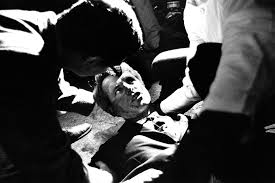
Speaking of which, what screams conspiracy the loudest are the deaths.
In the three years after the murders of President Kennedy and Lee Harvey Oswald, eighteen materials witnesses had died; six by gun fire, three in motor accidents, two by suicide, one from a cut throat, one from a karate chop to the neck, three from heart attacks, and two by natural causes.
An actuary engaged by the London Sunday Times concluded that on November 22, 1963, the odds of these witnesses being dead by February 1967 were 100,000,000,000,000,000,000 to 1.
Had Bobby Kennedy been elected President in 1968, and there was every indication he had a great chance, his presidential access would've allowed him to find out what exactly happened to his older brother. He needed to go! Learning from mistakes five years earlier, this one went smoother. The whole evil Russian Communist takeover of America story-line was wearing thin as the 70's approached, so Sirhan Sirhan's narrative for shooting RFK was built around the Israeli-Palestinian conflict of which most Americans didn't have a clue about nor was that dispute even on RFK's radar.
Speaking of which, what screams conspiracy the loudest are the deaths.
In the three years after the murders of President Kennedy and Lee Harvey Oswald, eighteen materials witnesses had died; six by gun fire, three in motor accidents, two by suicide, one from a cut throat, one from a karate chop to the neck, three from heart attacks, and two by natural causes.
An actuary engaged by the London Sunday Times concluded that on November 22, 1963, the odds of these witnesses being dead by February 1967 were 100,000,000,000,000,000,000 to 1.


No comments:
Post a Comment